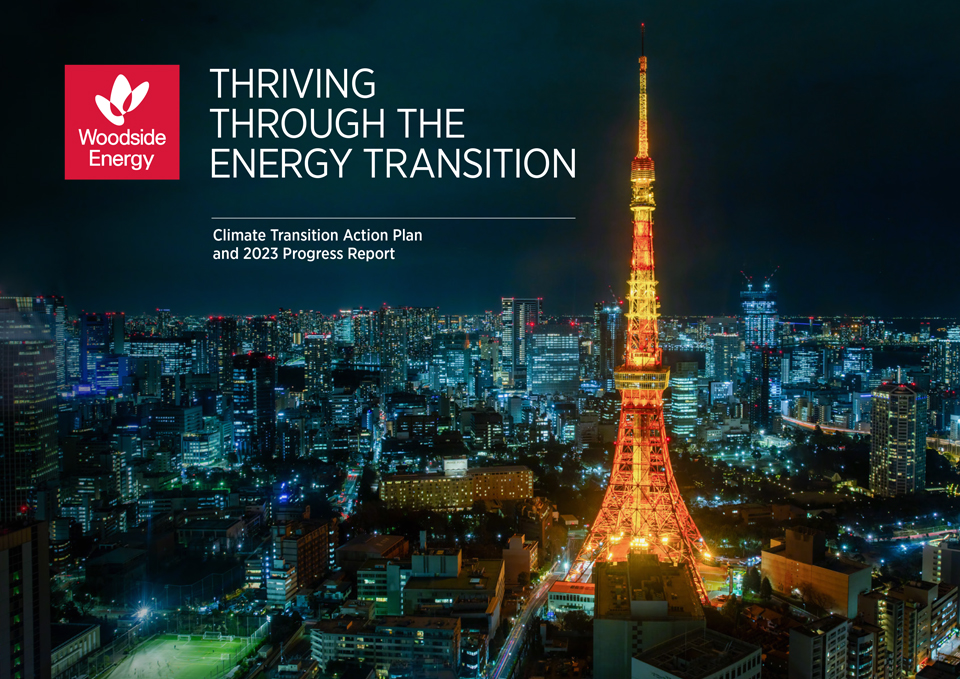
展品99.3
 |
在能源转型中茁壮成长气候转型行动计划和2023年进展报告
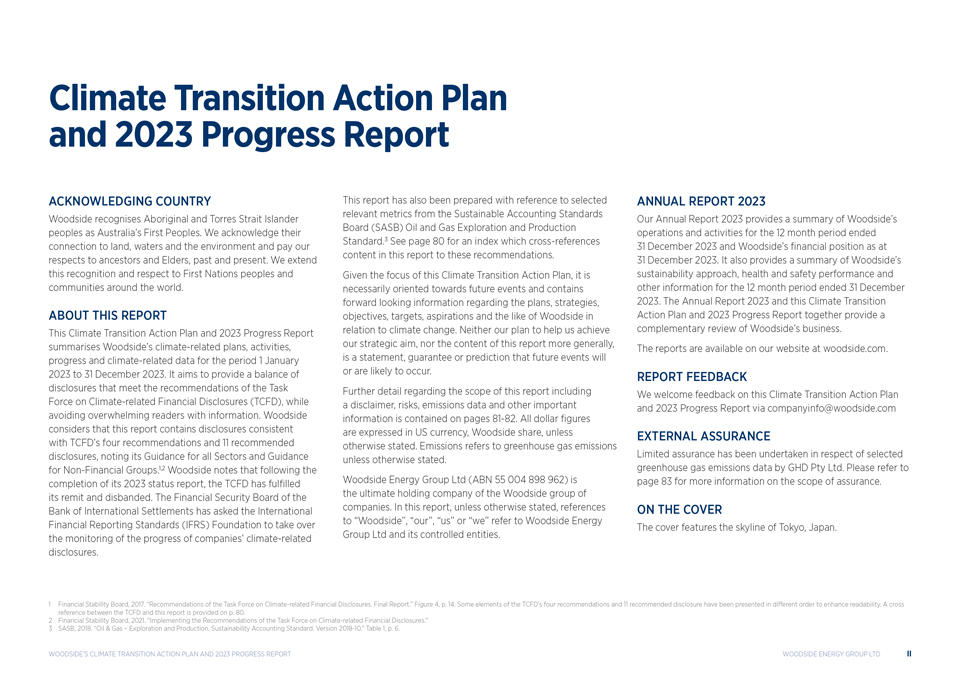 |
气候和2023年过渡进展行动报告 承认国家伍德赛德的计划承认土著和托雷斯海峡岛民为澳大利亚?S原住民。我们承认它们与土地、水和环境的联系,并向祖先和长辈致敬,无论是过去的还是现在的。我们对世界各地的原住民人民和社区给予这种承认和尊重。关于本报告本《气候过渡行动计划和2023年进展报告》概述了2023年1月1日至2023年12月31日期间的伍德赛德?S气候相关计划、活动、进展和气候相关数据。它旨在提供符合气候相关财务披露特别工作组(TCFD)建议的披露之间的平衡,同时避免向读者提供大量信息。伍德赛德认为,本报告包含符合TCFD的披露?S提出了4项建议和11项建议披露,并注意到其对所有部门的指导和对非金融集团的指导。1,2伍德赛德指出,在完成其2023年状况报告后,TCFD已完成其职权范围并解散。国际清算银行金融安全委员会已要求国际财务报告准则(IFRS)基金会接管对公司进展的监督?与气候有关的披露。本报告的编制也参考了可持续会计准则委员会(SASB)石油和天然气勘探与生产标准中选定的相关指标。3索引将本报告中的内容与这些建议交叉引用。鉴于本气候过渡行动计划的重点,它必须面向未来事件, 包含有关伍德赛德与气候变化相关的计划、战略、目标、指标、抱负等的前瞻性信息。无论是我们帮助我们实现战略目标的计划,还是本报告更一般的内容,都不是对未来事件将会或可能发生的声明、保证或预测。关于本报告范围的进一步详情,包括免责声明、风险、排放数据和其他重要信息,载于第81-82页。除非另有说明,所有美元均以美国货币伍德赛德股票表示。除非另有说明,排放是指温室气体排放。伍德赛德能源集团有限公司(ABN 55 004 898 962)是伍德赛德集团公司的最终控股公司。在本报告中,除非另有说明,否则指的是伍德赛德、我们的、我们的。或者?我们?请参考伍德赛德能源集团有限公司及其控制的实体。2023年年报我们的2023年年报提供了截至2023年12月31日的12个月期间伍德赛德?S的运营和活动以及伍德赛德?S截至2023年12月31日的财务状况的摘要。它还提供了截至2023年12月31日的12个月期间伍德赛德?S的可持续发展方法、健康和安全绩效以及其他 信息的摘要。2023年年度报告和本气候转型行动计划以及2023年进展报告共同为伍德赛德?S的业务提供了补充回顾。这些报告可在我们的 网站伍德赛德网站上找到。报告反馈我们欢迎对本《气候过渡行动计划》和《2023年进度报告》的反馈,请发送至pananyinfo@wood side.com。GHD Pty Ltd已对选定的温室气体排放数据进行了有限保证。有关保证范围的更多信息,请参阅第83页。封面以日本东京的天际线为特色。1金融稳定委员会,2017年。?与气候有关的财务披露问题工作队的建议。最终报告。?图4,第14页。TCFD的一些要素?S的四项建议和11项建议公开以不同的顺序列出,以增强可读性。第80页提供了TCFD和本报告之间的交叉引用。2金融稳定委员会,2021年。?执行气候相关财务披露工作队的建议。3 SASB,2018。?石油和天然气?勘探和生产。可持续性 会计准则。版本2018-10。?表1,第6页,伍德赛德?S气候过渡行动计划和2023年进展报告伍德赛德能源集团有限公司2
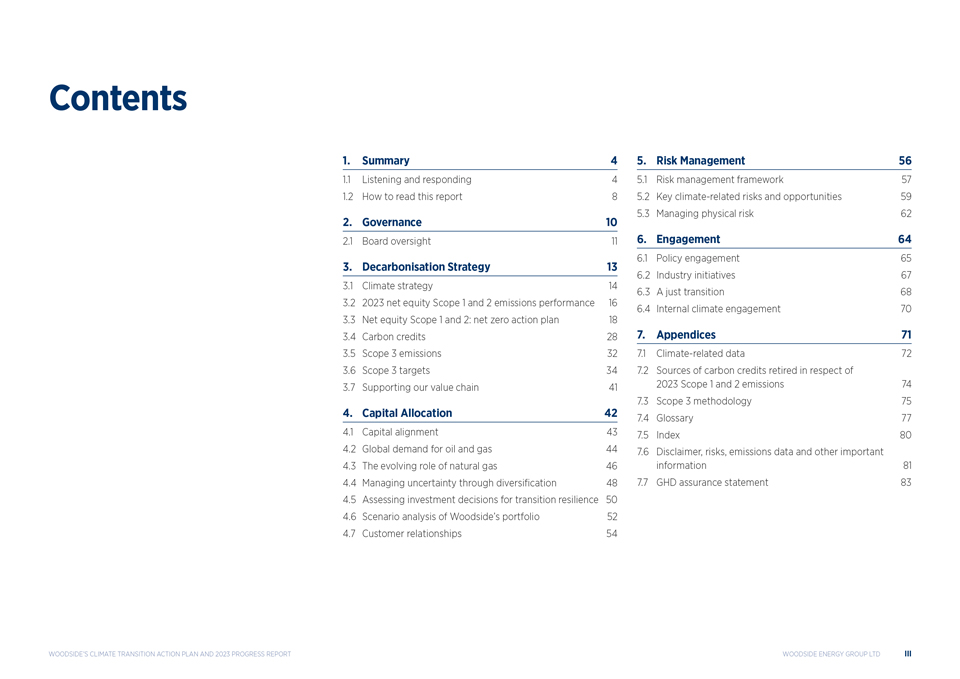 |
内容1.摘要4 1.1倾听和回应4 1.2如何阅读本报告8 2.治理10 2.1董事会监督11 3.脱碳战略13 3.1气候战略14 3.2 2023净股本范围1和2排放绩效16 3.3净股本范围1和2:净零行动计划18 3.4碳 信用额度28 3.5范围3排放32 3.6范围3目标34 3.7支持我们的价值链41 4.资本分配42 4.1资本调整43 4.2全球石油和天然气需求天然气44 4.3天然气的角色演变46 4.4通过多元化管理不确定性 48 4.5评估转型弹性的投资决策50 4.6伍德赛德?S投资组合的情景分析52 4.7客户关系54 5.风险管理56 5.1风险管理框架57 5.2与气候有关的关键风险和机会59 5.3管理实物风险62 6.参与度64 6.1政策参与度65 6.2行业倡议67 6.3 A刚刚过渡68 6.4内部气候参与度70 7.附录71 7.1与气候有关的数据72 7.2关于2023年范围1和范围2排放报废的碳信用来源74 7.3范围3方法75 7.4词汇表77 7.5索引80 7.6免责声明,风险、排放数据和其他重要信息81 7.7 GHD保证声明83伍德赛德?S气候过渡行动计划和2023年进展报告伍德赛德能源集团有限公司III
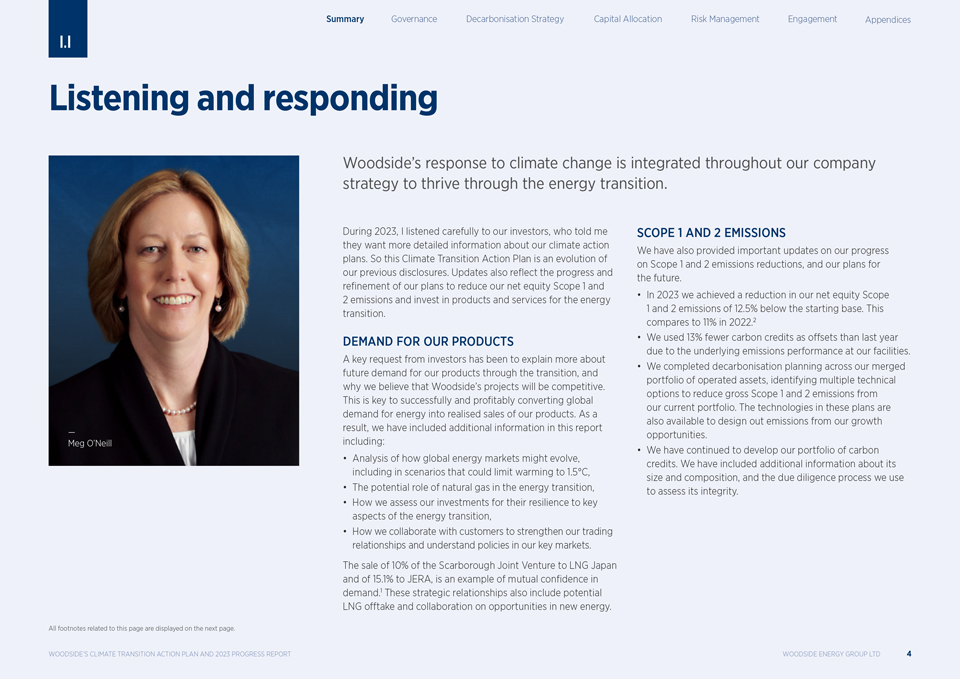 |
倾听和回应伍德赛德?S对气候变化的回应 融入了我们公司的战略,以在能源转型中蓬勃发展。在2023年期间,我仔细听取了我们的投资者的意见,他们告诉我,他们想要关于我们的气候行动计划的更详细的信息。因此,这份气候转型行动计划是我们之前披露的内容的演变。更新还记录了我们减少净资产范围1和2排放的计划的进展和结果,并投资于能源过渡的产品和服务。对我们产品的需求 投资者的一个关键要求是解释更多关于过渡期间对我们产品的未来需求,以及为什么我们相信伍德赛德?S项目将具有竞争力。这是成功且有利可图地将全球能源需求转化为我们产品实现销售的关键。因此,我们在本报告中包含了更多信息,包括:分析全球能源市场可能如何发展,包括可能将升温限制在1.5摄氏度以下的情况;天然气在能源转型中的潜在作用;我们如何评估我们的投资对能源转型关键方面的弹性;我们如何与客户合作加强我们的贸易关系;以及 了解我们关键市场的政策。将斯卡伯勒合资公司10%的股份出售给LNG日本公司,并将15.1%的股份出售给JERA,这是双方需求一致的一个例子。1这些战略关系还包括潜在的LNG承购和在新能源机会上的合作。范围1和范围2排放我们还提供了我们在范围1和范围2减排方面的最新进展,以及我们未来的计划。2023年,我们实现了净权益范围1和范围2排放量在起始基数下减少12.5%。与2022.2年度的11%相比,由于我们设施的潜在排放表现,我们使用的碳信用作为补偿比去年减少了13%。我们在我们合并的运营资产组合中完成了脱碳计划 ,确定了多个技术选项,以减少我们当前投资组合的范围1和范围2的总排放量。这些计划中的技术也可用于设计我们增长机会的排放 。我们继续发展我们的碳信用投资组合。我们还包括了有关其规模和组成的更多信息,以及我们用来评估其完整性的尽职调查程序。与本页相关的所有脚注均显示在下一页上。伍德赛德?S气候转型行动计划和2023年进展报告伍德赛德能源集团有限公司4
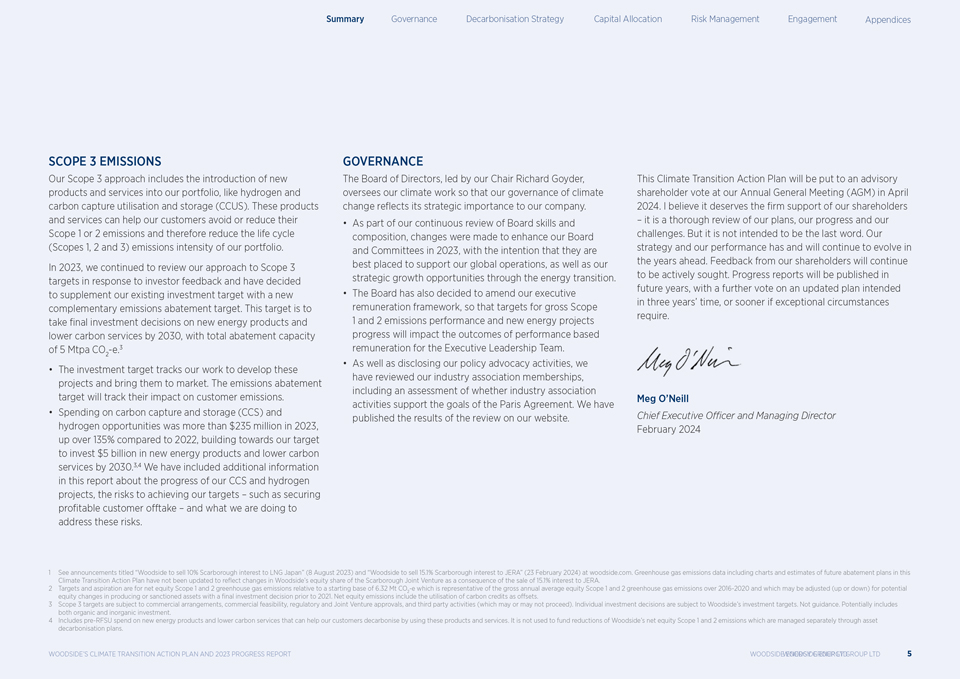 |
范围3排放我们的范围3方法包括 在我们的产品组合中引入新产品和服务,如氢和碳捕获利用和储存(CCUS)。这些产品和服务可以帮助我们的客户避免或减少其范围1或2的排放,从而降低我们产品组合的生命周期(范围1、2和3)的排放强度。2023年,我们继续审查我们对范围3目标的方法,以回应投资者的反馈,并决定用新的补充性减排目标来补充我们现有的投资目标。这一目标是到2030年在新能源产品和低碳服务方面做出国家投资决策,总减排能力达到5 Mtpa CO-E.3 2投资目标跟踪我们开发这些项目并将其推向市场的工作。减排目标将跟踪它们对客户排放的影响。2023年在碳捕获和储存(CCS)和氢气机会方面的支出超过2.35亿美元,与2022年相比增长了135% ,朝着我们到2030.3年前在新能源产品和低碳服务上投资50亿美元的目标不断迈进。4我们在本报告中是否包含了关于我们的CCS和氢气项目进展的更多信息,以及实现我们的目标的风险?例如确保有利可图的客户流失?以及我们正在做些什么来应对这些风险。治理由我们的主席Richard Goyder领导的董事会监督我们的气候工作,以便我们对气候变化的治理反映它对我们公司的战略重要性。作为我们对董事会技能和组成的持续审查的一部分,我们在2023年进行了改革,以加强我们的董事会和委员会,目的是使它们处于最佳地位,以支持我们的全球业务, 以及我们在能源转型期间的战略增长机会。董事会还决定修订我们的高管薪酬框架,以使范围1和2排放总量以及新能源项目进展的目标 将影响高管领导团队绩效薪酬的结果。除了披露我们的政策宣传活动外,我们还审查了我们的行业协会成员资格,包括评估行业协会活动是否支持《巴黎协定》的目标。我们已经在我们的网站上公布了审查结果。本气候转型行动计划将于2024年4月在我们的年度股东大会(AGM)上进行顾问股东投票。我相信它值得我们股东的坚定支持?这是对我们的计划、我们的进展和我们的挑战的彻底审查。但这并不是最后的决定。我们的战略和业绩已经并将在未来几年继续发展。我们将继续积极寻求股东的反馈意见。未来几年将发布进度报告,并对三年后计划的更新计划进行进一步投票?时间,或在特殊情况需要时更早 。梅格·奥尼尔担任董事首席执行官兼董事总经理2024年2月1请访问Woodside网站,查看题为?伍德赛德将向日本液化天然气公司出售10%斯卡伯勒权益?(2023年8月8日)和?伍德赛德将向杰拉出售15.1%斯卡伯勒权益?(2024年2月23日)的公告。温室气体排放数据,包括本气候过渡行动计划中对未来减排计划的图表和估计,没有更新以反映由于向JERA出售15.1%的权益而导致的伍德赛德?S在斯卡伯勒合资企业的股权份额的变化。2目标和期望是净权益范围1和2的温室气体排放量,相对于6.32公吨CO-e的起始基数,代表2016-2020年权益范围1和2温室气体排放的年均总量,可根据生产或受制裁资产的潜在权益变化进行调整(上调或下调),但在2021年前作出最终投资决定。净权益排放量包括利用碳信用作为补偿。3范围3的目标取决于商业安排、商业可行性、监管和合资企业的批准以及第三方活动(可能进行也可能不进行)。个人投资 以伍德赛德?S的投资目标为准。而不是指导。可能既包括有机投资,也包括无机投资。4包括RFSU之前在新能源产品和低碳服务上的支出,这些服务可以通过使用这些产品和服务来帮助我们的客户实现脱碳。这笔资金不用于为减少伍德赛德?S净股本范围1和2的排放提供资金,这两个范围通过资产脱碳计划单独管理。伍德赛德?S气候转型行动计划和2023年进展 报告沃德赛德能源集团能源集团有限公司5
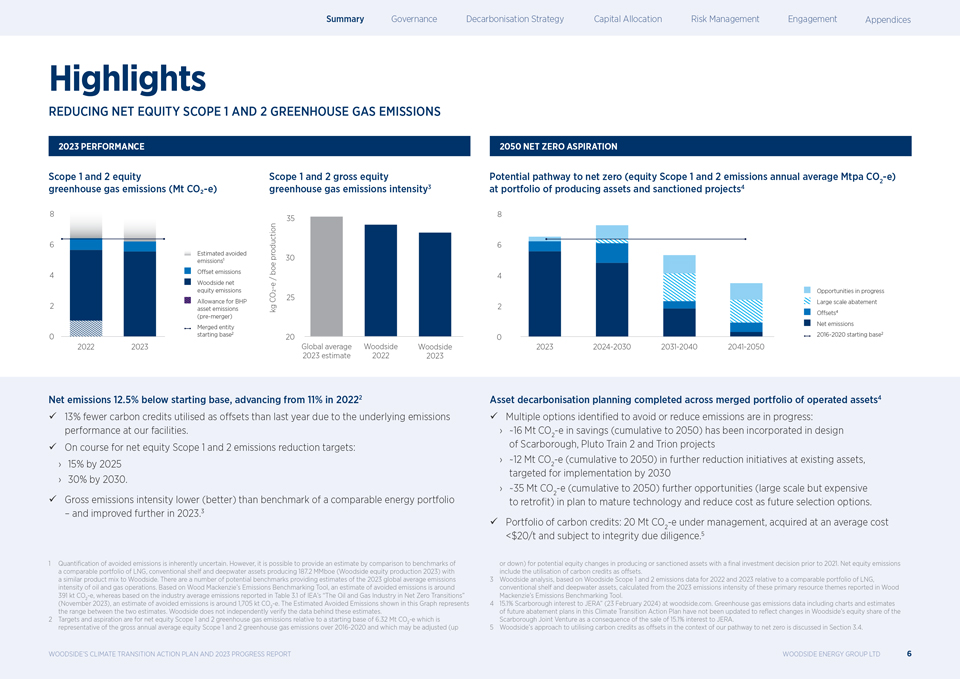 |
重点介绍减少净权益范围1和2温室气体排放2023业绩范围1和2权益范围1和2总权益温室气体排放量(Mt CO?-e)温室气体排放强度3 8 35 6估计的避免生产排放量1 30抵消排放量Boe 4/Woodside净值-CO2 25必和必拓2资产排放津贴kg(合并前)合并实体0起点基数2 20 2022 2023全球平均伍德赛德森林2023估计2022 2023 2050净零预期潜在途径净零(权益范围1和2年平均Mtpa CO-e)4 2在投资组合中生产资产和批准项目8 6 4正在进行中的机会2抵消4 2016-2020年开始净排放量2 2023 2024-2030 2031-2040 2041-2050净排放量比开始基数低12.5%,从20222年度的11%上升?由于我们设施的潜在排放表现,用作补偿的碳信用比去年减少了13%。?正在实现净资产范围1和2的减排目标:到2025年减少15%,到2030年减少30%。?总排放强度低于(好于)可比能源组合的基准?并在2023.3作了进一步改进,1避免排放的量化本质上是不确定的。然而,可以通过与液化天然气、常规大陆架和深水资产组合的基准进行比较来提供估计,这些资产组合的产量为187.2 Mboe(2023年伍德赛德权益产量),产品组合与伍德赛德类似。有许多潜在基准可提供对2023年全球石油和天然气作业平均排放强度的估计。基于Wood Mackenzie?S排放基准工具,估计避免排放量约为391kt CO-e,而根据国际能源署S?石油和天然气行业净零过渡2(2023年11月)表3.1中报告的行业平均排放量,估计避免排放量约为1,705kt CO-e。此图表中显示的估计避免排放量 表示2两个估计值之间的范围。伍德赛德没有独立核实这些估计背后的数据。2目标和期望是净权益范围1和2温室气体排放量相对于6.32公吨CO-e的起始基数 ,这2代表2016-2020年权益范围1和2温室气体排放的年平均总量,可能会进行调整(在合并的运营资产组合中完成资产脱碳计划4?多个避免或减少排放的选项正在进行中:斯卡伯勒的设计中纳入了节省的约16公吨CO-e(累积到2050年),2个冥王星列车2和Trion项目约12公吨CO-e(累积到2050年),在现有资产的进一步削减 举措中,目标是在2030~35公吨CO-e(累积到2050年)之前实施2更多机会(大规模但追溯成本昂贵)2计划成熟技术和降低成本作为未来的选择选项。? 碳信用组合:管理下的20公吨CO-E,以2
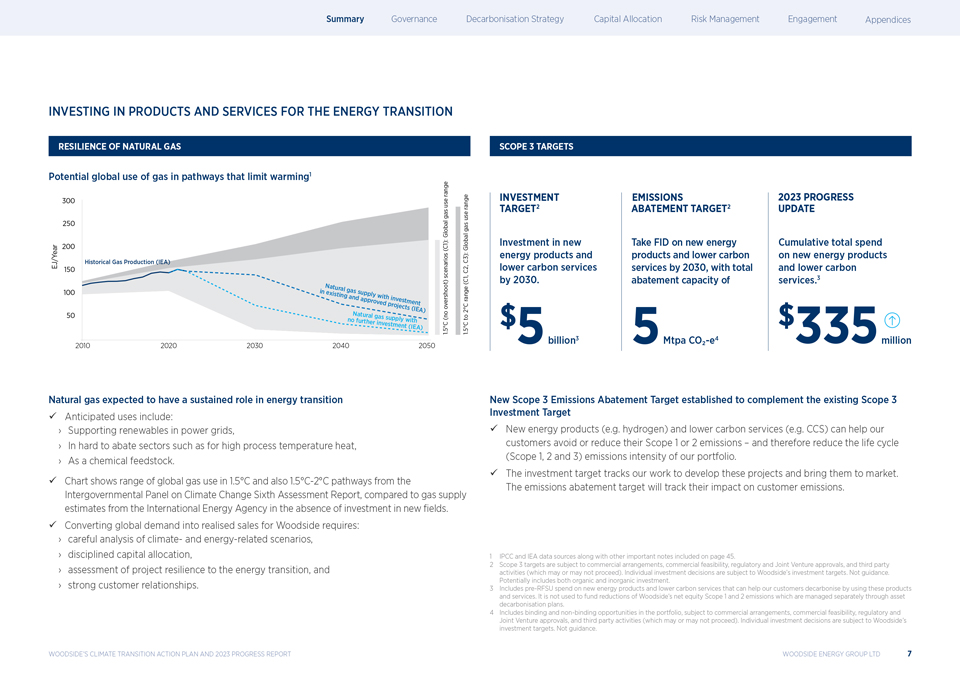 |
INVESTING IN PRODUCTS AND SERVICES FOR THE ENERGY TRANSITION RESILIENCE OF NATURAL GAS Potential global use of gas in pathways that limit warming1 range 300 use gas range 250 use Globalgas 200 (C1): Global C3): Historical Gas Production (IEA) EJ/Year 150 C2, scenarios (C1, Natural 100 in exis gas supply ting and with appr inves range oved projectmen ts t overshoot) (IEA) 2C 50 Natural gas supply (noto no further with investmen t (IEA) 5C 5C 1 . 1 . 2010 2020 2030 2040 2050 SCOPE 3 TARGETS INVESTMENT EMISSIONS 2023 PROGRESS TARGET2 ABATEMENT TARGET2 UPDATE Investment in new Take FID on new energy Cumulative total spend energy products and products and lower carbon on new energy products lower carbon services services by 2030, with total and lower carbon by 2030. abatement capacity of services.3 $ $ 5billion3 5Mtpa CO?-e4 335million Natural gas expected to have a sustained role in energy transition ? Anticipated uses include: Supporting renewables in power grids, In hard to abate sectors such as for high process temperature heat, As a chemical feedstock. ? Chart shows range of global gas use in 1.5C and also 1.5C-2C pathways from the Intergovernmental Panel on Climate Change Sixth Assessment Report, compared to gas supply estimates from the International Energy Agency in the absence of investment in new ?elds. ? Converting global demand into realised sales for Woodside requires: careful analysis of climate- and energy-related scenarios, disciplined capital allocation, assessment of project resilience to the energy transition, and strong customer relationships. New Scope 3 Emissions Abatement Target established to complement the existing Scope 3 Investment Target ? New energy products (e.g. hydrogen) and lower carbon services (e.g. CCS) can help our customers avoid or reduce their Scope 1 or 2 emissions ? and therefore reduce the life cycle (Scope 1, 2 and 3) emissions intensity of our portfolio. ? The investment target tracks our work to develop these projects and bring them to market. The emissions abatement target will track their impact on customer emissions. 1 IPCC and IEA data sources along with other important notes included on page 45. 2 Scope 3 targets are subject to commercial arrangements, commercial feasibility, regulatory and Joint Venture approvals, and third party activities (which may or may not proceed). Individual investment decisions are subject to Woodside?s investment targets. Not guidance. Potentially includes both organic and inorganic investment. 3 Includes pre-RFSU spend on new energy products and lower carbon services that can help our customers decarbonise by using these products and services. It is not used to fund reductions of Woodside?s net equity Scope 1 and 2 emissions which are managed separately through asset decarbonisation plans. 4 Includes binding and non-binding opportunities in the portfolio, subject to commercial arrangements, commercial feasibility, regulatory and Joint Venture approvals, and third party activities (which may or may not proceed). Individual investment decisions are subject to Woodside?s investment targets. Not guidance. WOODSIDE?S CLIMATE TRANSITION ACTION PLAN AND 2023 PROGRESS REPORT WOODSIDE ENERGY GROUP LTD 7
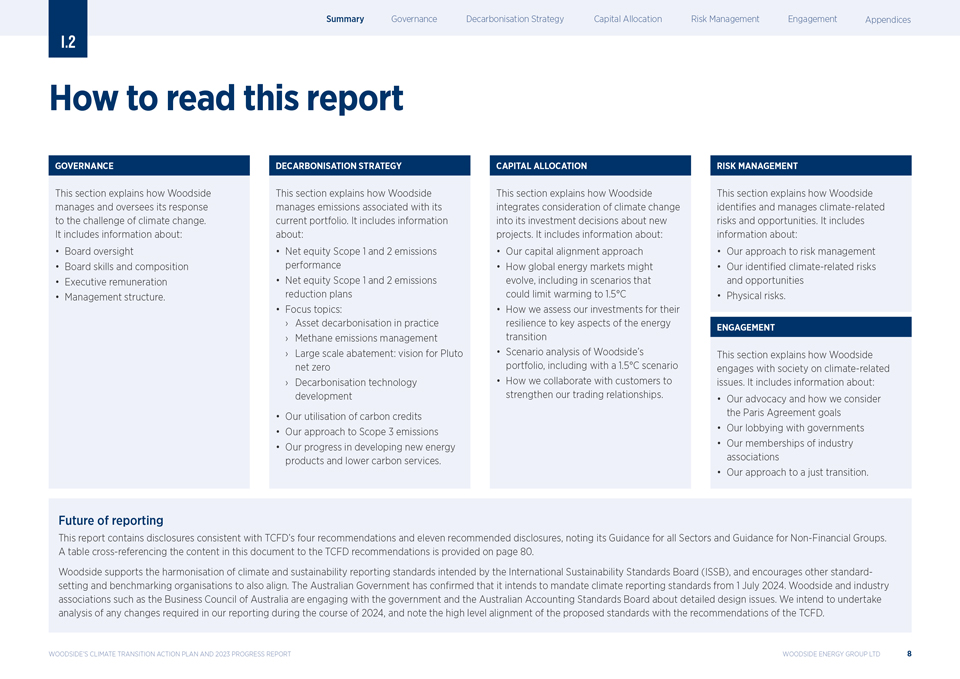 |
How to read this report GOVERNANCE This section explains how Woodside manages and oversees its response to the challenge of climate change. It includes information about: Board oversight Board skills and composition Executive remuneration Management structure. DECARBONISATION STRATEGY This section explains how Woodside manages emissions associated with its current portfolio. It includes information about: Net equity Scope 1 and 2 emissions performance Net equity Scope 1 and 2 emissions reduction plans Focus topics: Asset decarbonisation in practice Methane emissions management Large scale abatement: vision for Pluto net zero Decarbonisation technology development Our utilisation of carbon credits Our approach to Scope 3 emissions Our progress in developing new energy products and lower carbon services. CAPITAL ALLOCATION This section explains how Woodside integrates consideration of climate change into its investment decisions about new projects. It includes information about: Our capital alignment approach How global energy markets might evolve, including in scenarios that could limit warming to 1.5C How we assess our investments for their resilience to key aspects of the energy transition Scenario analysis of Woodside?s portfolio, including with a 1.5C scenario How we collaborate with customers to strengthen our trading relationships. RISK MANAGEMENT This section explains how Woodside identi?es and manages climate-related risks and opportunities. It includes information about: Our approach to risk management Our identi?ed climate-related risks and opportunities Physical risks. ENGAGEMENT This section explains how Woodside engages with society on climate-related issues. It includes information about: Our advocacy and how we consider the Paris Agreement goals Our lobbying with governments Our memberships of industry associations Our approach to a just transition. Future of reporting This report contains disclosures consistent with TCFD?s four recommendations and eleven recommended disclosures, noting its Guidance for all Sectors and Guidance for Non-Financial Groups. A table cross-referencing the content in this document to the TCFD recommendations is provided on page 80. Woodside supports the harmonisation of climate and sustainability reporting standards intended by the International Sustainability Standards Board (ISSB), and encourages other standard-setting and benchmarking organisations to also align. The Australian Government has con?rmed that it intends to mandate climate reporting standards from 1 July 2024. Woodside and industry associations such as the Business Council of Australia are engaging with the government and the Australian Accounting Standards Board about detailed design issues. We intend to undertake analysis of any changes required in our reporting during the course of 2024, and note the high level alignment of the proposed standards with the recommendations of the TCFD. WOODSIDE?S CLIMATE TRANSITION ACTION PLAN AND 2023 PROGRESS REPORT WOODSIDE ENERGY GROUP LTD 8
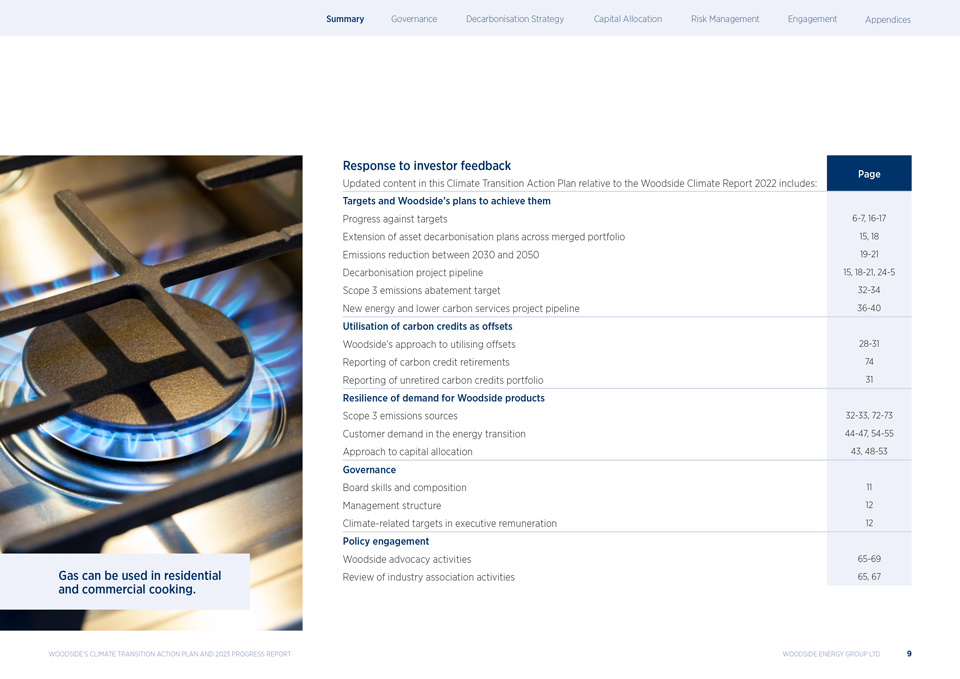 |
燃气可用于住宅和商业烹饪 。对投资者反馈的回应相对于2022年伍德赛德气候报告的最新内容包括:页面目标和伍德赛德?s的计划实现目标6—7、16—17的进展 在合并后的投资组合中延长资产脱碳计划15、18 2030年至2050年期间的减排19—21脱碳项目管道15、18—21,24—5范围3减排目标32—34新能源和低碳服务项目 管道36—40利用碳信用额作为抵消伍德赛德?利用抵消的方法28—31碳信用额度退役的报告74未退役的碳信用额度组合的报告31对伍德赛德产品的需求的弹性范围3排放源32—33,72—73能源转型中的客户需求44—47,54—55资本分配的方法43,48—53治理委员会的技能和组成11管理结构12高管薪酬中与气候有关的目标12政策参与伍德赛德倡导活动65—69审查行业协会活动65,67伍德赛德?2023年全球气候变迁行动计划与进展报告Woodside Energy Group Limited 9
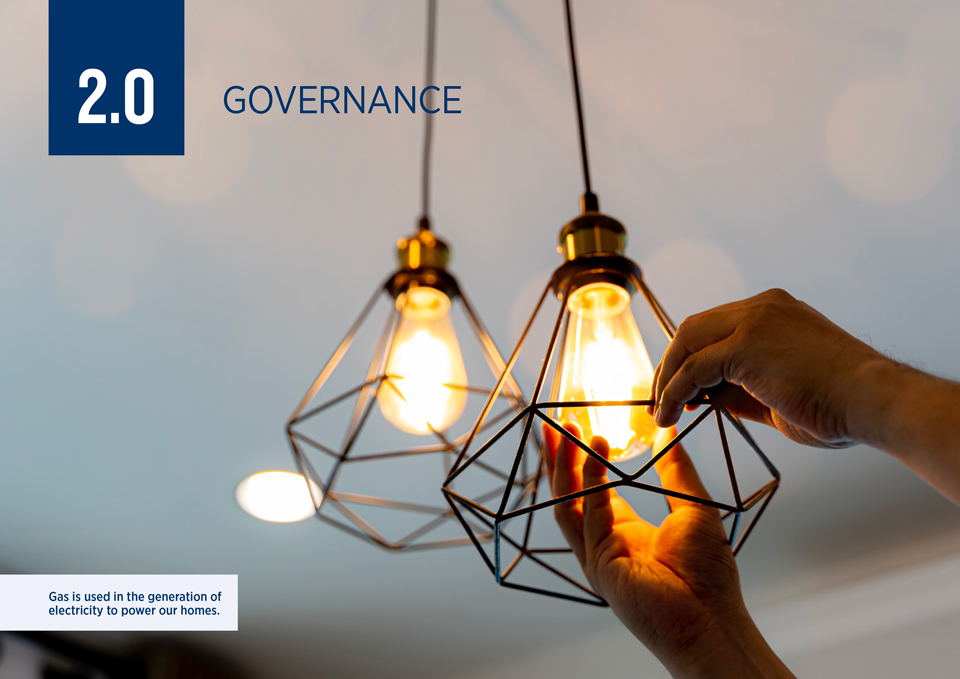 |
政府天然气用于 发电,为我们的家庭供电。
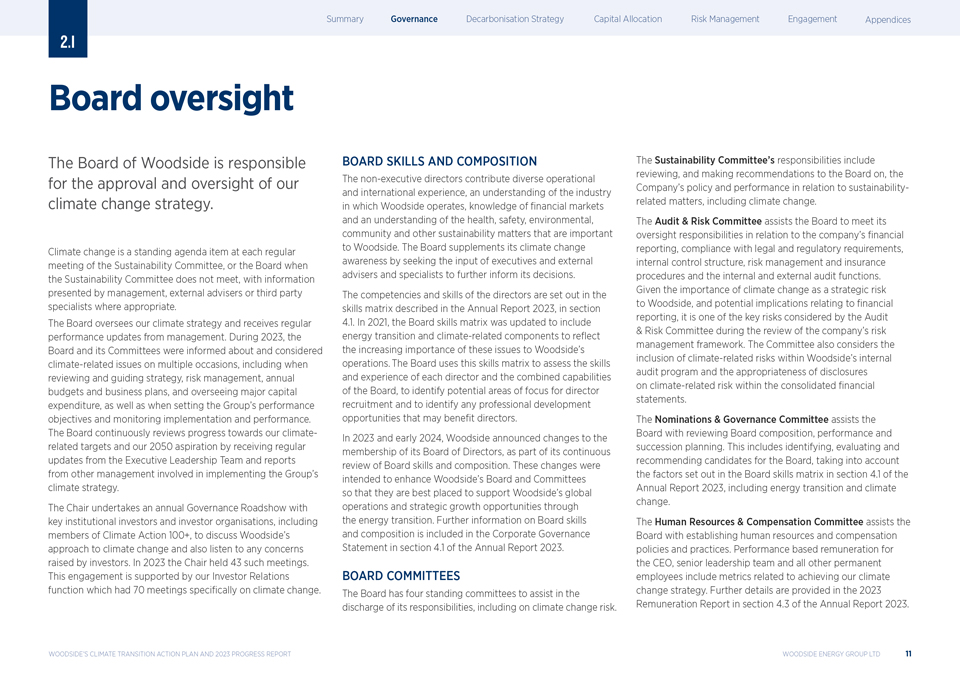 |
Board oversight The Board of Woodside is responsible for the approval and oversight of our climate change strategy. Climate change is a standing agenda item at each regular meeting of the Sustainability Committee, or the Board when the Sustainability Committee does not meet, with information presented by management, external advisers or third party specialists where appropriate. The Board oversees our climate strategy and receives regular performance updates from management. During 2023, the Board and its Committees were informed about and considered climate-related issues on multiple occasions, including when reviewing and guiding strategy, risk management, annual budgets and business plans, and overseeing major capital expenditure, as well as when setting the Group?s performance objectives and monitoring implementation and performance. The Board continuously reviews progress towards our climate-related targets and our 2050 aspiration by receiving regular updates from the Executive Leadership Team and reports from other management involved in implementing the Group?s climate strategy. The Chair undertakes an annual Governance Roadshow with key institutional investors and investor organisations, including members of Climate Action 100+, to discuss Woodside?s approach to climate change and also listen to any concerns raised by investors. In 2023 the Chair held 43 such meetings. This engagement is supported by our Investor Relations function which had 70 meetings specifically on climate change. BOARD SKILLS AND COMPOSITION The non-executive directors contribute diverse operational and international experience, an understanding of the industry in which Woodside operates, knowledge of ?nancial markets and an understanding of the health, safety, environmental, community and other sustainability matters that are important to Woodside. The Board supplements its climate change awareness by seeking the input of executives and external advisers and specialists to further inform its decisions. The competencies and skills of the directors are set out in the skills matrix described in the Annual Report 2023, in section 4.1. In 2021, the Board skills matrix was updated to include energy transition and climate-related components to reflect the increasing importance of these issues to Woodside?s operations. The Board uses this skills matrix to assess the skills and experience of each director and the combined capabilities of the Board, to identify potential areas of focus for director recruitment and to identify any professional development opportunities that may bene?t directors. In 2023 and early 2024, Woodside announced changes to the membership of its Board of Directors, as part of its continuous review of Board skills and composition. These changes were intended to enhance Woodside?s Board and Committees so that they are best placed to support Woodside?s global operations and strategic growth opportunities through the energy transition. Further information on Board skills and composition is included in the Corporate Governance Statement in section 4.1 of the Annual Report 2023. BOARD COMMITTEES The Board has four standing committees to assist in the discharge of its responsibilities, including on climate change risk. The Sustainability Committee?s responsibilities include reviewing, and making recommendations to the Board on, the Company?s policy and performance in relation to sustainability-related matters, including climate change. The Audit & Risk Committee assists the Board to meet its oversight responsibilities in relation to the company?s financial reporting, compliance with legal and regulatory requirements, internal control structure, risk management and insurance procedures and the internal and external audit functions. Given the importance of climate change as a strategic risk to Woodside, and potential implications relating to financial reporting, it is one of the key risks considered by the Audit & Risk Committee during the review of the company?s risk management framework. The Committee also considers the inclusion of climate-related risks within Woodside?s internal audit program and the appropriateness of disclosures on climate-related risk within the consolidated financial statements. The Nominations & Governance Committee assists the Board with reviewing Board composition, performance and succession planning. This includes identifying, evaluating and recommending candidates for the Board, taking into account the factors set out in the Board skills matrix in section 4.1 of the Annual Report 2023, including energy transition and climate change. The Human Resources & Compensation Committee assists the Board with establishing human resources and compensation policies and practices. Performance based remuneration for the CEO, senior leadership team and all other permanent employees include metrics related to achieving our climate change strategy. Further details are provided in the 2023 Remuneration Report in section 4.3 of the Annual Report 2023. WOODSIDE?S CLIMATE TRANSITION ACTION PLAN AND 2023 PROGRESS REPORT WOODSIDE ENERGY GROUP LTD 11
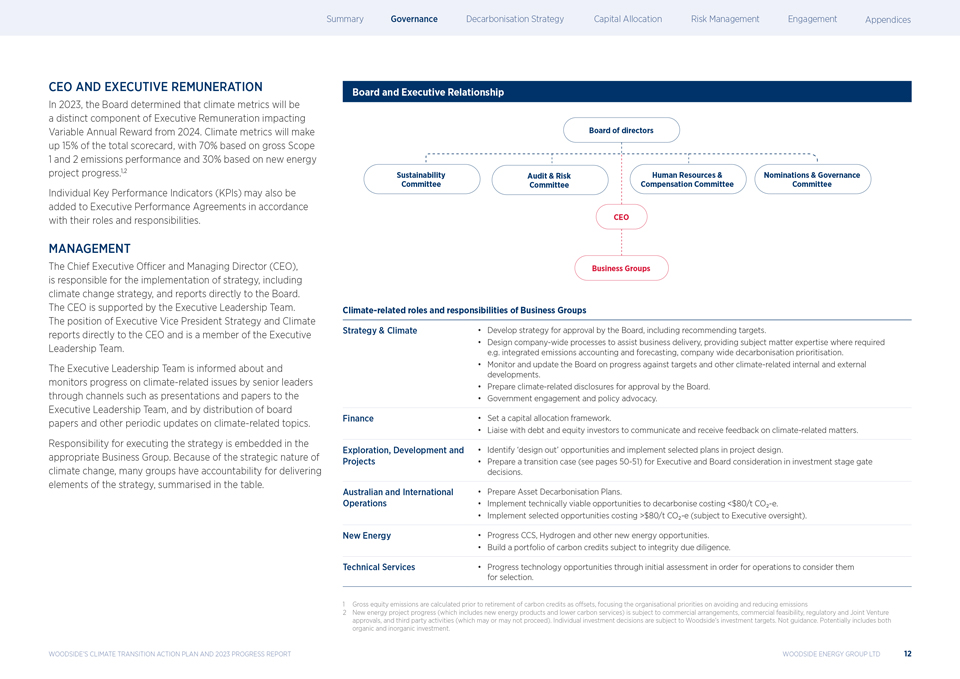 |
关于2023年CEO和高管薪酬,董事会 决定从2024年起,气候指标将成为影响可变年度薪酬的高管薪酬的一个独特组成部分。气候指标将占总记分卡的15%,其中70%基于总范围1和2排放绩效 ,30%基于新能源项目进度。1、2个单独的关键绩效指标(KPI)也可以根据其角色和职责添加到高管绩效协议中。管理层首席执行官兼董事董事总经理(首席执行官)负责战略的实施,包括气候变化战略,并直接向董事会报告。首席执行官由行政领导团队提供支持。执行副总裁总裁 战略与气候直接向首席执行官汇报,是执行领导团队的成员。高级领导人通过向执行领导团队作报告和文件等渠道,以及分发董事会文件和其他有关气候相关议题的定期更新,向执行领导团队通报气候相关问题的进展情况并监测进展情况。执行战略的责任嵌入到适当的业务组中。由于气候变化的战略性质,许多团体有责任交付该战略的内容,如表所示。董事会和执行关系董事会可持续发展审计和风险人力资源 &提名和治理委员会薪酬委员会首席执行官业务小组气候相关角色和责任业务小组战略和气候发展战略供董事会批准, 包括推荐目标。设计公司范围内的流程,以协助业务交付,在需要时提供主题专业知识,例如集成的排放核算和预测、公司范围内的脱碳优先顺序。监测 并向董事会通报目标的进展情况以及其他与气候有关的内部和外部事态发展。准备与气候有关的披露,以供董事会批准。政府参与和政策倡导。金融设定了资本配置框架 。与债务和股权投资者联络,就气候相关问题进行沟通和接受反馈。探索、开发和识别?设计?在项目设计中提供机会并实施选定的计划。项目准备一个过渡案例(见第50-51页),供执行委员会和董事会在投资阶段大门决策中考虑。澳大利亚和国际准备资产脱碳计划。运营实现了技术上可行的脱碳机会 成本低于80美元/吨CO-E。实施选定的商机,成本超过80美元/吨的CO-E(受管理层监督)。新能源进展CCS、氢气等新能源机遇。建立一个经过 诚信尽职调查的碳信用组合。技术服务通过初步评估提高技术机会,以便运营部门考虑进行选择。1总股本排放量在碳信用报废前计算为补偿 ,将组织重点放在避免和减少排放上2新能源项目进展(包括新能源产品和低碳服务)取决于商业安排、商业可行性、监管 和合资企业批准,以及第三方活动(可能进行也可能不进行)。个人投资决策受制于伍德赛德?S的投资目标。而不是指导。可能包括有机和无机投资。伍德赛德?S气候过渡行动计划和2023年进展报告伍德赛德能源集团有限公司12
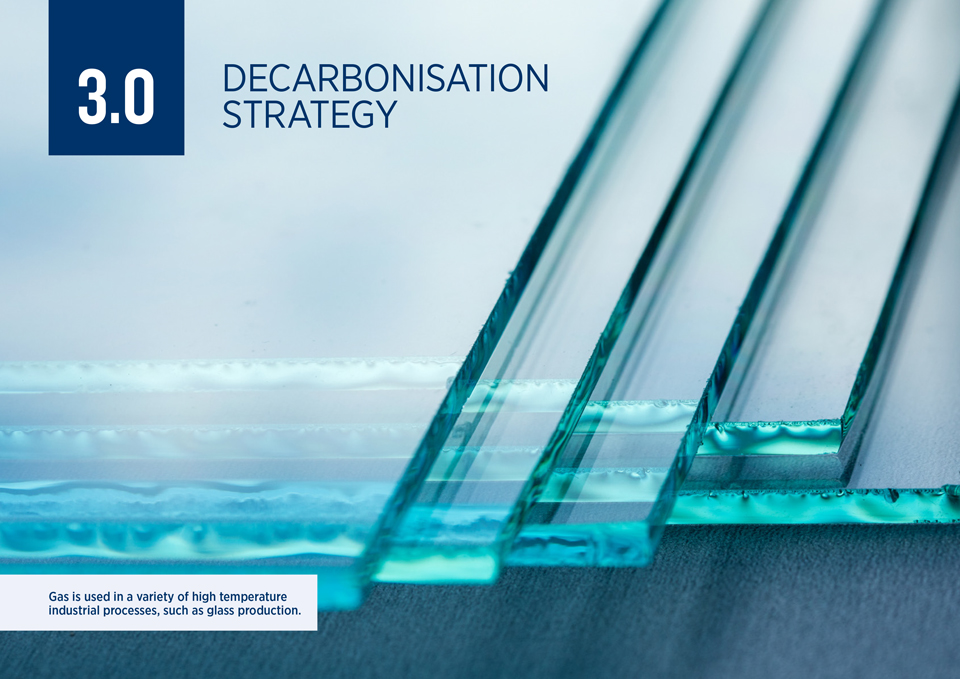 |
脱碳策略气体用于各种高温工业流程,如玻璃生产。
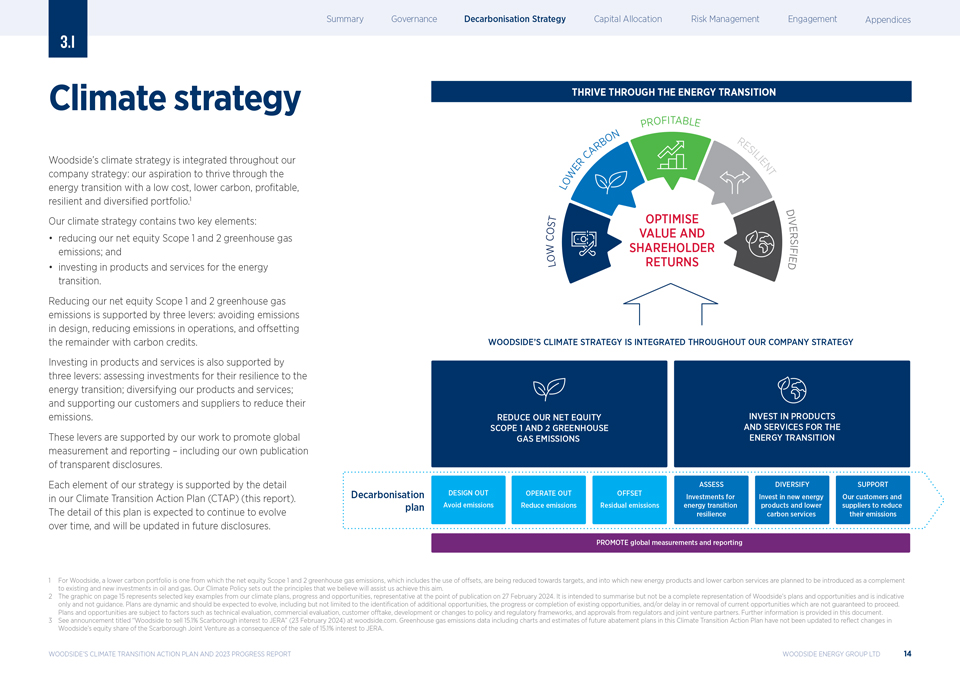 |
气候战略伍德赛德?S气候战略被整合到我们的公司战略中:我们渴望以低成本、低碳、盈利、弹性和多样化的投资组合在能源转型中蓬勃发展1我们的气候战略包含两个关键要素:减少我们的净权益范围1和2温室气体排放;以及投资于能源转型的产品和服务。减少我们的净权益范围1和2温室气体排放得到三个杠杆的支持:在设计中避免排放,在运营中减少 排放,以及通过碳信用来抵消其余部分。对产品和服务的投资也得到了三个杠杆的支持:评估投资对能源转型的适应能力;使我们的产品和服务多样化;以及支持我们的客户和供应商减少排放。这些杠杆得到了我们促进全球衡量和报告的工作的支持?包括我们自己发布的透明披露。我们的气候转型行动计划(CTAP)(本报告)中的详细内容支持了我们 战略的每一个要素。该计划的细节预计将随着时间的推移而继续演变,并将在未来的披露中更新。在能源转型中茁壮成长 有利可图的N B O R ES A I L R C I E E NT W L O D T优化I S V O价值和E C R S W股东F O回报E I L D伍德赛德?S气候战略整合在我们整个公司的战略脱碳计划1对于伍德赛德,较低的碳 投资组合是指净股权范围1和2的温室气体排放,包括使用抵消,正在朝着目标减少,并计划引入新的能源产品和低碳服务,作为对现有和新的石油和天然气投资的补充。我们的气候政策制定了我们相信将帮助我们实现这一目标的原则。2第15页的图表代表了我们在2024年2月27日发表时具有代表性的气候计划、进展和 机会中精选的关键例子。本文旨在对伍德赛德?S的计划和机会进行总结,但不是完整的表述,仅供参考,而不是指导。计划是动态的, 应预期会发生变化,包括但不限于确定其他机会、现有机会的进展或完成、和/或延迟或删除不能保证继续进行的当前机会。 计划和机会受以下因素的影响:技术评估、商业评估、客户承购、政策和监管框架的发展或更改,以及监管机构和合资伙伴的批准。本文档提供了更多 信息。3参见Woodside将15.1%的Scarborough权益出售给jera?(2024年2月23日)的公告。温室气体排放数据,包括本气候过渡行动计划中对未来减排计划的图表和估计,尚未更新,以反映由于向JERA出售15.1%权益而导致伍德赛德?S在斯卡伯勒合资企业中的股权份额的变化。伍德赛德?S气候转型行动计划和2023年进展报告伍德赛德能源集团有限公司14
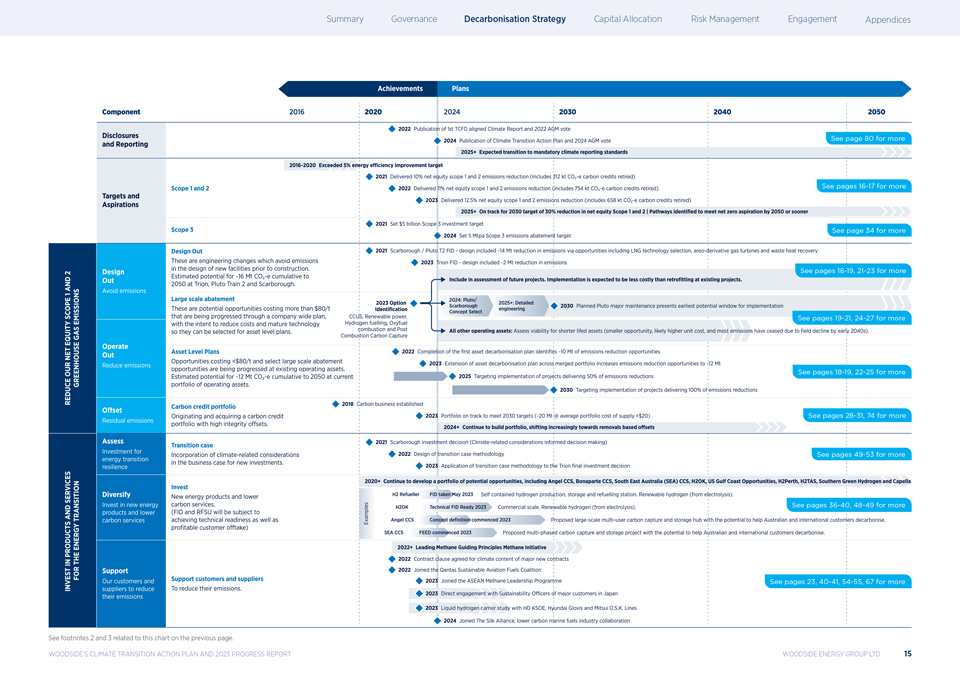 |
请参阅上一页中与此图表相关的脚注2和3。伍德赛德?S气候转型行动计划和2023年进展报告伍德赛德能源集团有限公司15
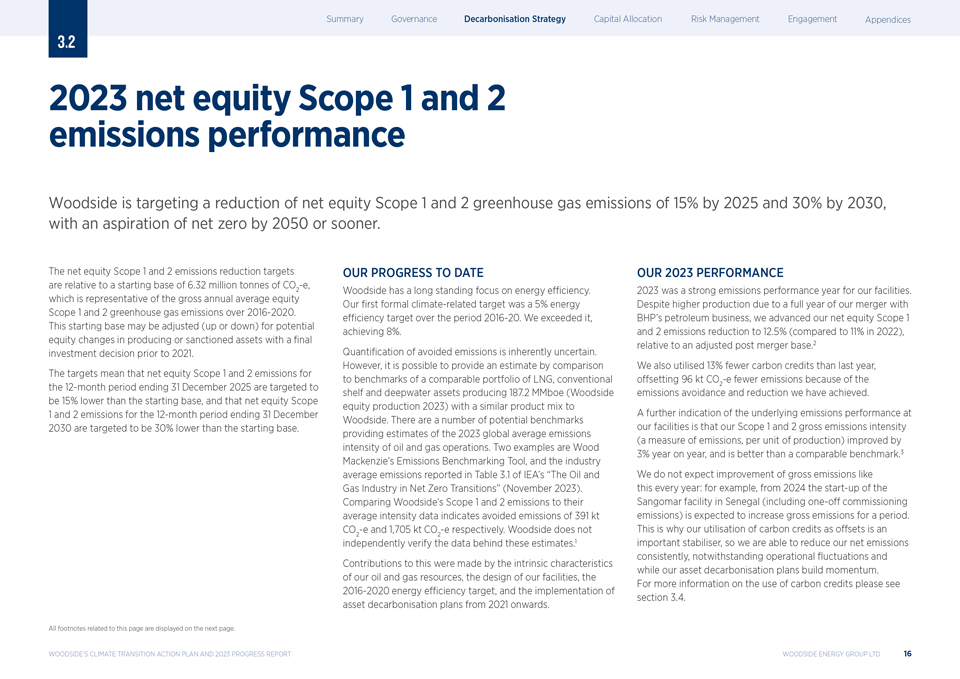 |
2023 emissions net equity performance Scope 1 and 2 Woodside is targeting a reduction of net equity Scope 1 and 2 greenhouse gas emissions of 15% by 2025 and 30% by 2030, with an aspiration of net zero by 2050 or sooner. The net equity Scope 1 and 2 emissions reduction targets are relative to a starting base of 6.32 million tonnes of CO -e, which is representative of the gross annual average equity 2 Scope 1 and 2 greenhouse gas emissions over 2016-2020. This starting base may be adjusted (up or down) for potential equity changes in producing or sanctioned assets with a ?nal investment decision prior to 2021. The targets mean that net equity Scope 1 and 2 emissions for the 12-month period ending 31 December 2025 are targeted to be 15% lower than the starting base, and that net equity Scope 1 and 2 emissions for the 12-month period ending 31 December 2030 are targeted to be 30% lower than the starting base. OUR PROGRESS TO DATE Woodside has a long standing focus on energy efficiency. Our ?rst formal climate-related target was a 5% energy efficiency target over the period 2016-20. We exceeded it, achieving 8%. Quantification of avoided emissions is inherently uncertain. However, it is possible to provide an estimate by comparison to benchmarks of a comparable portfolio of LNG, conventional shelf and deepwater assets producing 187.2 MMboe (Woodside equity production 2023) with a similar product mix to Woodside. There are a number of potential benchmarks providing estimates of the 2023 global average emissions intensity of oil and gas operations. Two examples are Wood Mackenzie?s Emissions Benchmarking Tool, and the industry average emissions reported in Table 3.1 of IEA?s ?The Oil and Gas Industry in Net Zero Transitions? (November 2023). Comparing Woodside?s Scope 1 and 2 emissions to their average intensity data indicates avoided emissions of 391 kt CO -e and 1,705 kt CO -e respectively. Woodside does not 2 2 independently verify the data behind these estimates.1 Contributions to this were made by the intrinsic characteristics of our oil and gas resources, the design of our facilities, the 2016-2020 energy efficiency target, and the implementation of asset decarbonisation plans from 2021 onwards. OUR 2023 PERFORMANCE 2023 was a strong emissions performance year for our facilities. Despite higher production due to a full year of our merger with BHP?s petroleum business, we advanced our net equity Scope 1 and 2 emissions reduction to 12.5% (compared to 11% in 2022), relative to an adjusted post merger base.2 We also utilised 13% fewer carbon credits than last year, offsetting 96 kt CO -e fewer emissions because of the emissions avoidance 2 and reduction we have achieved. A further indication of the underlying emissions performance at our facilities is that our Scope 1 and 2 gross emissions intensity (a measure of emissions, per unit of production) improved by 3% year on year, and is better than a comparable benchmark.3 We do not expect improvement of gross emissions like this every year: for example, from 2024 the start-up of the Sangomar facility in Senegal (including one-off commissioning emissions) is expected to increase gross emissions for a period. This is why our utilisation of carbon credits as offsets is an important stabiliser, so we are able to reduce our net emissions consistently, notwithstanding operational ?uctuations and while our asset decarbonisation plans build momentum. For more information on the use of carbon credits please see section 3.4. All footnotes related to this page are displayed on the next page. WOODSIDE?S CLIMATE TRANSITION ACTION PLAN AND 2023 PROGRESS REPORT WOODSIDE ENERGY GROUP LTD 16
 |
净股本范围1和2减排目标在2025年实现12.5%减排目标:2025年达到15%到2030年达到净零30%2050年或更早净股本范围1和2排放量(Mt CO-e)8 6估计避免排放量1 4抵消排放量伍德赛德净股本排放量 必和必拓2资产排放(合并前)合并实体0起点基数2 20232 2022年范围1和2总排放强度3 35产量30 boe/e二氧化碳排放25公斤20全球平均伍德赛德2023年甲烷排放量估计值0.2石油2023年甲烷排放强度4和气体气候倡议(%)(OGCI)目标远低于0.2%气体0.15上市0.1 SM3/SM3 0.05 0 OGCI行业伍德赛德2023年2022 2023伍德赛德?S净权益范围1和2 2023年温室气体排放量总计5,532 kt CO?-e,比起始基数低12.5%。2总权益范围1和2排放量为6,190 kt CO-e。为了实现这一净结果,658kt CO?-2E的碳信用额度已经报废。2023年,伍德赛德?S总权益范围1温室气体排放的70%来自于燃料燃烧为我们的资产提供动力,22%来自于排气,其中大部分与水库CO?作为液化天然气过程的一部分,8%来自燃烧。在上图中,为实现与2023年的全年可比性,增加了必和必拓石油投资组合在合并前5个月的排放额度。我们2023年的总权益范围1和2的排放量低于可比基准。通过与伍德赛德可比产品组合和产量的基准进行比较,可以 提供避免排放量的估计。有关估算的信息,请参见第16页。1总范围1和2排放强度是在应用补偿之前对我们生产效率的衡量。这是证明伍德赛德在我们的设施中适当优先考虑避免和减少排放的一种方式。伍德赛德的总排放强度低于(高于)液化天然气、常规大陆架和深水资产可比资产组合的全球平均水平,这表明了为避免和减少我们运营的排放而采取的行动的影响,以及我们石油和天然气资源的内在特征。1由于强大的可靠性表现,包括冥王星的减少等因素,2023年我们的总范围1和2的排放强度有所改善。伍德赛德的甲烷排放强度低于(高于)行业(OGCI)目标,并制定了进一步改善和争取接近零的甲烷排放的行动计划。5伍德赛德?S甲烷排放业绩和减少计划见第23页。甲烷排放对伍德赛德?S范围1的排放有贡献,但受到特别关注 ,因为它们对实现全球气候目标具有近期重要性。我们的甲烷强度在2023年有所改善,原因包括减少冥王星的排放和减少生产、储存和卸载(FPSO)设施的排放。1避免排放的量化本质上是不确定的。然而,可以通过与液化天然气、常规大陆架和深水资产组合的基准进行比较来提供估计,这些资产的产量为187.2 Mboe(伍德赛德股权生产2023年),产品组合与伍德赛德类似。有许多潜在的基准提供了对2023年全球石油和天然气作业平均排放强度的估计。基于Wood Mackenzie?S排放基准工具, 估计避免排放量约为391kt CO-e,而根据国际能源署?S?石油和天然气行业净零过渡?表3.1中报告的行业平均排放量?(2023年11月),估计避免的排放量约为1,705千吨CO-e。此图中显示的估算避免排放量代表两个估计值之间的范围。2伍德赛德没有独立核实这些估计背后的数据。2目标和期望是净权益范围1和2温室气体排放量相对于6.32公吨CO-e的起始基数,这代表2016-2020年权益范围1和2温室气体排放的年平均总量,可根据生产或批准资产的潜在权益变化进行调整(上调或下调) 在2021年之前作出最终投资决定。净股本排放量包括利用碳信用作为补偿。3伍德赛德分析,基于2022年和2023年伍德赛德范围1和2相对于液化天然气、常规大陆架和深水资产可比投资组合的排放数据,根据Wood Mackenzie?S排放基准工具中报告的这些主要资源主题的2023年排放强度计算得出。4伍德赛德分析,基于2022年和2023年伍德赛德甲烷排放数据,相对于OGCI平均值和目标。Https://www.ogci.com/action-and-engagement/reducing-methane-emissions/#methane-target.5 OGMP,2023年。?实施计划指南?,第2页https://ogmpartnership.com/wp-content/uploads/2023/02/OGMP-2.0-Implementation-Plan-Guidance_2.pdf.OGMP提供了OGCI上游作业的集体平均目标,作为接近零的例子。排放强度。伍德赛德?S气候转型行动计划和2023年进展报告伍德赛德能源集团有限公司17
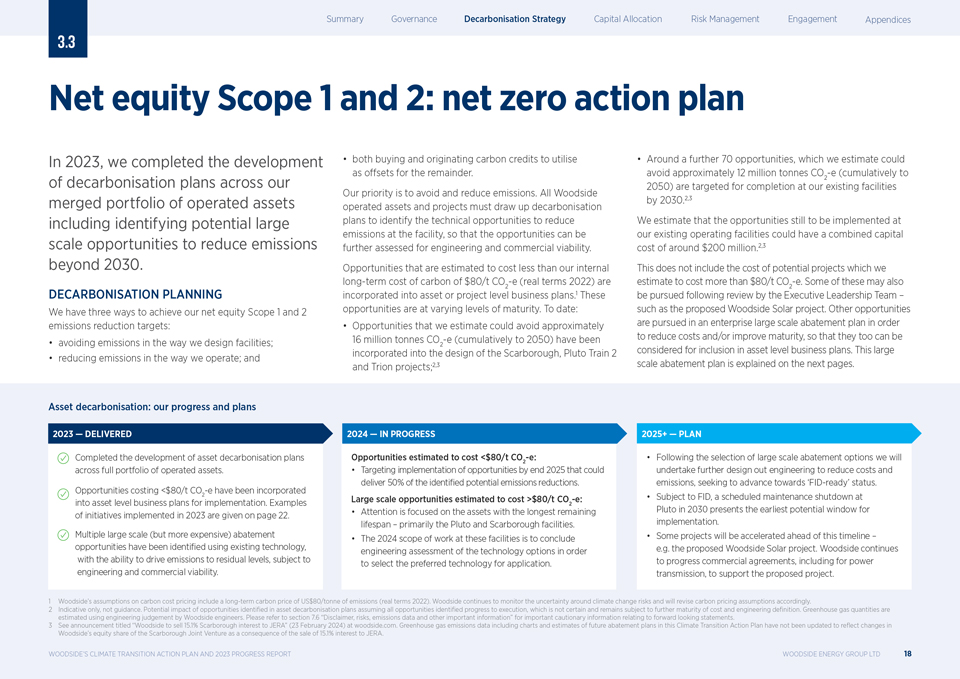 |
Net equity Scope 1 and 2: net zero action plan In 2023, we completed the development of decarbonisation plans across our merged portfolio of operated assets including identifying potential large scale opportunities to reduce emissions beyond 2030. DECARBONISATION PLANNING We have three ways to achieve our net equity Scope 1 and 2 emissions reduction targets: avoiding emissions in the way we design facilities; reducing emissions in the way we operate; and both buying and originating carbon credits to utilise as offsets for the remainder. Our priority is to avoid and reduce emissions. All Woodside operated assets and projects must draw up decarbonisation plans to identify the technical opportunities to reduce emissions at the facility, so that the opportunities can be further assessed for engineering and commercial viability. Opportunities that are estimated to cost less than our internal long-term cost of carbon of $80/t CO -e (real terms 2022) are 2 incorporated into asset or project level business plans.1 These opportunities are at varying levels of maturity. To date: Opportunities that we estimate could avoid approximately 16 million tonnes CO -e (cumulatively to 2050) have been incorporated into the 2 design of the Scarborough, Pluto Train 2 and Trion projects;2,3 Around a further 70 opportunities, which we estimate could avoid approximately 12 million tonnes CO -e (cumulatively to 2050) are targeted for completion at our 2 existing facilities by 2030.2,3 We estimate that the opportunities still to be implemented at our existing operating facilities could have a combined capital cost of around $200 million.2,3 This does not include the cost of potential projects which we estimate to cost more than $80/t CO -e. Some of these may also be pursued following review by the Executive 2 Leadership Team ? such as the proposed Woodside Solar project. Other opportunities are pursued in an enterprise large scale abatement plan in order to reduce costs and/or improve maturity, so that they too can be considered for inclusion in asset level business plans. This large scale abatement plan is explained on the next pages. Asset decarbonisation: our progress and plans 2023 ? DELIVERED Completed the development of asset decarbonisation plans across full portfolio of operated assets. Opportunities costing $80/t CO -e: 2 Attention is focused on the assets with the longest remaining lifespan ? primarily the Pluto and Scarborough facilities. The 2024 scope of work at these facilities is to conclude engineering assessment of the technology options in order to select the preferred technology for application. 2025+ ? PLAN Following the selection of large scale abatement options we will undertake further design out engineering to reduce costs and emissions, seeking to advance towards ?FID-ready? status. Subject to FID, a scheduled maintenance shutdown at Pluto in 2030 presents the earliest potential window for implementation. Some projects will be accelerated ahead of this timeline ? e.g. the proposed Woodside Solar project. Woodside continues to progress commercial agreements, including for power transmission, to support the proposed project. 1 Woodside?s assumptions on carbon cost pricing include a long-term carbon price of US$80/tonne of emissions (real terms 2022). Woodside continues to monitor the uncertainty around climate change risks and will revise carbon pricing assumptions accordingly. 2 Indicative only, not guidance. Potential impact of opportunities identified in asset decarbonisation plans assuming all opportunities identified progress to execution, which is not certain and remains subject to further maturity of cost and engineering definition. Greenhouse gas quantities are estimated using engineering judgement by Woodside engineers. Please refer to section 7.6 ?Disclaimer, risks, emissions data and other important information? for important cautionary information relating to forward looking statements. 3 See announcement titled ?Woodside to sell 15.1% Scarborough interest to JERA? (23 February 2024) at woodside.com. Greenhouse gas emissions data including charts and estimates of future abatement plans in this Climate Transition Action Plan have not been updated to reflect changes in Woodside?s equity share of the Scarborough Joint Venture as a consequence of the sale of 15.1% interest to JERA. WOODSIDE?S CLIMATE TRANSITION ACTION PLAN AND 2023 PROGRESS REPORT WOODSIDE ENERGY GROUP LTD 18
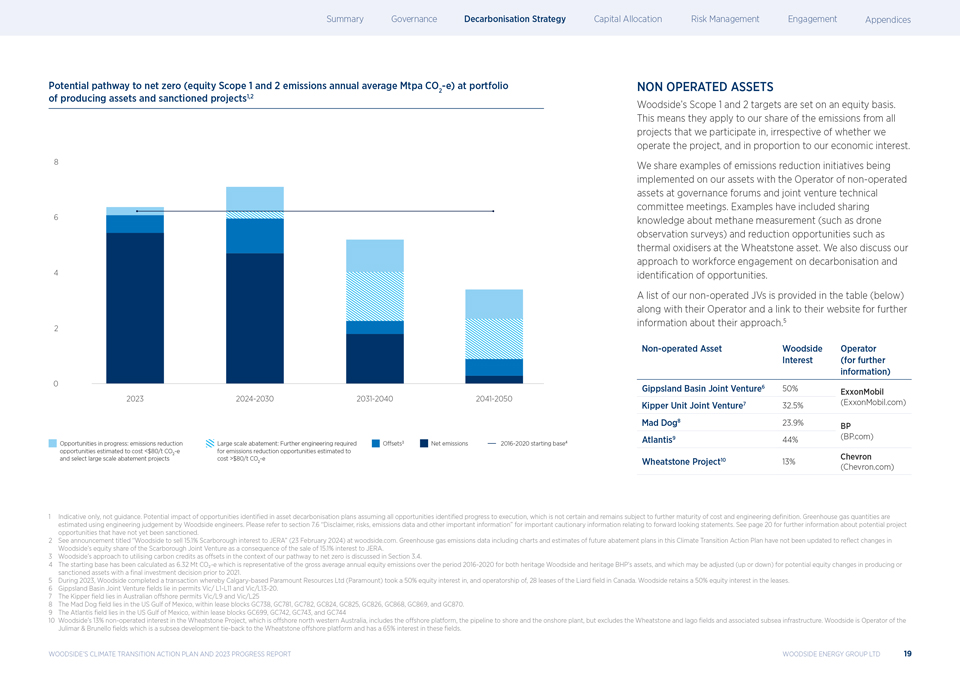 |
Potential pathway to net zero (equity Scope 1 and 2 emissions annual average Mtpa CO -e) at portfolio 1,2 2 of producing assets and sanctioned projects 8 6 4 2 0 2023 2024-2030 2031-2040 2041-2050 Opportunities in progress: emissions reduction Large scale abatement: Further engineering required Offsets3 Net emissions 2016-2020 starting base4 opportunities estimated to cost $80/t CO -e 2 NON OPERATED ASSETS Woodside?s Scope 1 and 2 targets are set on an equity basis. This means they apply to our share of the emissions from all projects that we participate in, irrespective of whether we operate the project, and in proportion to our economic interest. We share examples of emissions reduction initiatives being implemented on our assets with the Operator of non-operated assets at governance forums and joint venture technical committee meetings. Examples have included sharing knowledge about methane measurement (such as drone observation surveys) and reduction opportunities such as thermal oxidisers at the Wheatstone asset. We also discuss our approach to workforce engagement on decarbonisation and identification of opportunities. A list of our non-operated JVs is provided in the table (below) along with their Operator and a link to their website for further information about their approach.5 Non-operated Asset Woodside Operator Interest (for further information) Gippsland Basin Joint Venture6 50% ExxonMobil Kipper Unit Joint Venture7 32.5% (ExxonMobil.com) Mad Dog8 23.9% BP Atlantis9 44% (BP.com) 10 Chevron Wheatstone Project 13% (Chevron.com) 1 Indicative only, not guidance. Potential impact of opportunities identified in asset decarbonisation plans assuming all opportunities identified progress to execution, which is not certain and remains subject to further maturity of cost and engineering definition. Greenhouse gas quantities are estimated using engineering judgement by Woodside engineers. Please refer to section 7.6 ?Disclaimer, risks, emissions data and other important information? for important cautionary information relating to forward looking statements. See page 20 for further information about potential project opportunities that have not yet been sanctioned. 2 See announcement titled ?Woodside to sell 15.1% Scarborough interest to JERA? (23 February 2024) at woodside.com. Greenhouse gas emissions data including charts and estimates of future abatement plans in this Climate Transition Action Plan have not been updated to reflect changes in Woodside?s equity share of the Scarborough Joint Venture as a consequence of the sale of 15.1% interest to JERA. 3 Woodside?s approach to utilising carbon credits as offsets in the context of our pathway to net zero is discussed in Section 3.4. 4 The starting base has been calculated as 6.32 Mt CO?-e which is representative of the gross average annual equity emissions over the period 2016-2020 for both heritage Woodside and heritage BHP?s assets, and which may be adjusted (up or down) for potential equity changes in producing or sanctioned assets with a final investment decision prior to 2021. 5 During 2023, Woodside completed a transaction whereby Calgary-based Paramount Resources Ltd (Paramount) took a 50% equity interest in, and operatorship of, 28 leases of the Liard ?eld in Canada. Woodside retains a 50% equity interest in the leases. 6 Gippsland Basin Joint Venture ?elds lie in permits Vic/ L1-L11 and Vic/L13-20. 7 The Kipper ?eld lies in Australian offshore permits Vic/L9 and Vic/L25 8 The Mad Dog ?eld lies in the US Gulf of Mexico, within lease blocks GC738, GC781, GC782, GC824, GC825, GC826, GC868, GC869, and GC870. 9 The Atlantis ?eld lies in the US Gulf of Mexico, within lease blocks GC699, GC742, GC743, and GC744 10 Woodside?s 13% non-operated interest in the Wheatstone Project, which is offshore north western Australia, includes the offshore platform, the pipeline to shore and the onshore plant, but excludes the Wheatstone and Iago fields and associated subsea infrastructure. Woodside is Operator of the Julimar & Brunello fields which is a subsea development tie-back to the Wheatstone offshore platform and has a 65% interest in these fields. WOODSIDE?S CLIMATE TRANSITION ACTION PLAN AND 2023 PROGRESS REPORT WOODSIDE ENERGY GROUP LTD 19
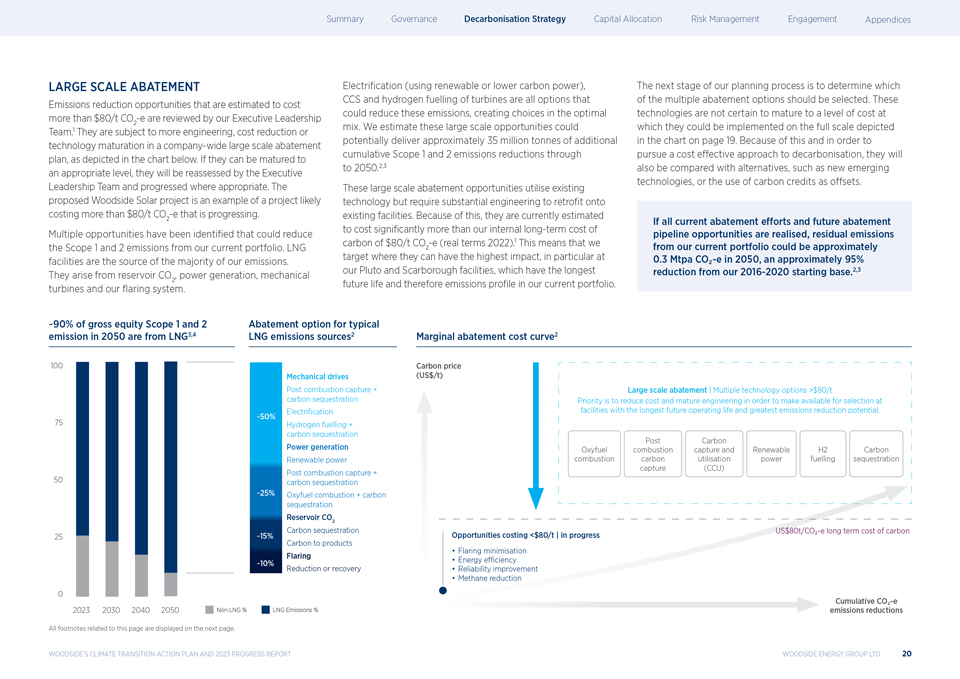 |
LARGE SCALE ABATEMENT Emissions reduction opportunities that are estimated to cost more than $80/t CO -e are reviewed by our Executive Leadership 2 Team.1 They are subject to more engineering, cost reduction or technology maturation in a company-wide large scale abatement plan, as depicted in the chart below. If they can be matured to an appropriate level, they will be reassessed by the Executive Leadership Team and progressed where appropriate. The proposed Woodside Solar project is an example of a project likely costing more than $80/t CO -e that is progressing. 2 Multiple opportunities have been identi?ed that could reduce the Scope 1 and 2 emissions from our current portfolio. LNG facilities are the source of the majority of our emissions. They arise from reservoir CO , power generation, mechanical turbines and our ?aring system 2 . Electri?cation (using renewable or lower carbon power), CCS and hydrogen fuelling of turbines are all options that could reduce these emissions, creating choices in the optimal mix. We estimate these large scale opportunities could potentially deliver approximately 35 million tonnes of additional cumulative Scope 1 and 2 emissions reductions through to 2050.2,3 These large scale abatement opportunities utilise existing technology but require substantial engineering to retro?t onto existing facilities. Because of this, they are currently estimated to cost signi?cantly more than our internal long-term cost of carbon of $80/t CO -e (real terms 2022).1 This means that we target where they can 2 have the highest impact, in particular at our Pluto and Scarborough facilities, which have the longest future life and therefore emissions pro?le in our current portfolio. The next stage of our planning process is to determine which of the multiple abatement options should be selected. These technologies are not certain to mature to a level of cost at which they could be implemented on the full scale depicted in the chart on page 19. Because of this and in order to pursue a cost effective approach to decarbonisation, they will also be compared with alternatives, such as new emerging technologies, or the use of carbon credits as offsets. If all current abatement efforts and future abatement pipeline opportunities are realised, residual emissions from our current portfolio could be approximately 0.3 Mtpa CO?-e in 2050, an approximately 95% reduction from our 2016-2020 starting base.2,3 ~90% of gross equity Scope 1 and 2 Abatement option for typical emission in 2050 are from LNG3,4 LNG emissions sources2 100 Mechanical drives Post combustion capture + carbon sequestration Electri?cation ~50% 75 Hydrogen fuelling + carbon sequestration Power generation Renewable power 50 Post combustion capture + carbon sequestration ~25% Oxyfuel combustion + carbon sequestration Reservoir CO 2 Carbon sequestration 25 ~15% Carbon to products ~10% Flaring Reduction or recovery 0 2023 2030 2040 2050 Non LNG % LNG Emissions % Marginal abatement cost curve2 Carbon price (US$/t) Large scale abatement | Multiple technology options >$80/t Priority is to reduce cost and mature engineering in order to make available for selection at facilities with the longest future operating life and greatest emissions reduction potential. Post Carbon Oxyfuel combustion capture and Renewable H2 Carbon combustion carbon utilisation power fuelling sequestration capture (CCU) US$80t/CO?-e long term cost of carbon Opportunities costing
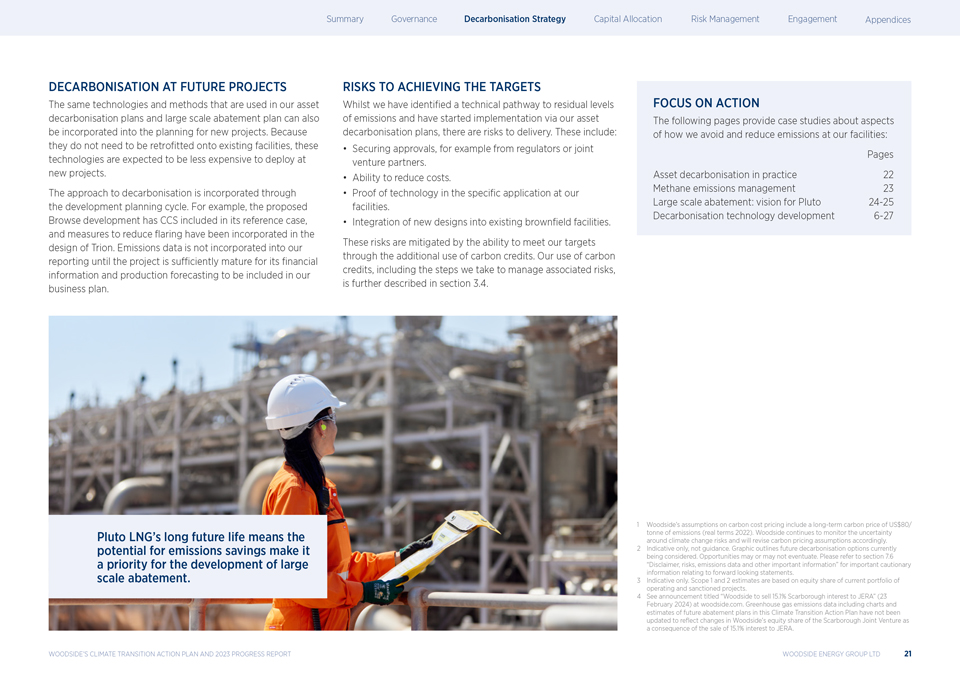 |
DECARBONISATION AT FUTURE PROJECTS The same technologies and methods that are used in our asset decarbonisation plans and large scale abatement plan can also be incorporated into the planning for new projects. Because they do not need to be retro?tted onto existing facilities, these technologies are expected to be less expensive to deploy at new projects. The approach to decarbonisation is incorporated through the development planning cycle. For example, the proposed Browse development has CCS included in its reference case, and measures to reduce ?aring have been incorporated in the design of Trion. Emissions data is not incorporated into our reporting until the project is sufficiently mature for its ?nancial information and production forecasting to be included in our business plan. RISKS TO ACHIEVING THE TARGETS Whilst we have identi?ed a technical pathway to residual levels of emissions and have started implementation via our asset decarbonisation plans, there are risks to delivery. These include: Securing approvals, for example from regulators or joint venture partners. Ability to reduce costs. Proof of technology in the speci?c application at our facilities. Integration of new designs into existing brown?eld facilities. These risks are mitigated by the ability to meet our targets through the additional use of carbon credits. Our use of carbon credits, including the steps we take to manage associated risks, is further described in section 3.4. FOCUS ON ACTION The following pages provide case studies about aspects of how we avoid and reduce emissions at our facilities: Pages Asset decarbonisation in practice 22 Methane emissions management 23 Large scale abatement: vision for Pluto 24-25 Decarbonisation technology development 6-27 Pluto LNG?s long future life means the potential for emissions savings make it a priority for the development of large scale abatement. 1 Woodside?s assumptions on carbon cost pricing include a long-term carbon price of US$80/ tonne of emissions (real terms 2022). Woodside continues to monitor the uncertainty around climate change risks and will revise carbon pricing assumptions accordingly. 2 Indicative only, not guidance. Graphic outlines future decarbonisation options currently being considered. Opportunities may or may not eventuate. Please refer to section 7.6 ?Disclaimer, risks, emissions data and other important information? for important cautionary information relating to forward looking statements. 3 Indicative only. Scope 1 and 2 estimates are based on equity share of current portfolio of operating and sanctioned projects. 4 See announcement titled ?Woodside to sell 15.1% Scarborough interest to JERA? (23 February 2024) at woodside.com. Greenhouse gas emissions data including charts and estimates of future abatement plans in this Climate Transition Action Plan have not been updated to reflect changes in Woodside?s equity share of the Scarborough Joint Venture as a consequence of the sale of 15.1% interest to JERA. WOODSIDE?S CLIMATE TRANSITION ACTION PLAN AND 2023 PROGRESS REPORT WOODSIDE ENERGY GROUP LTD 21
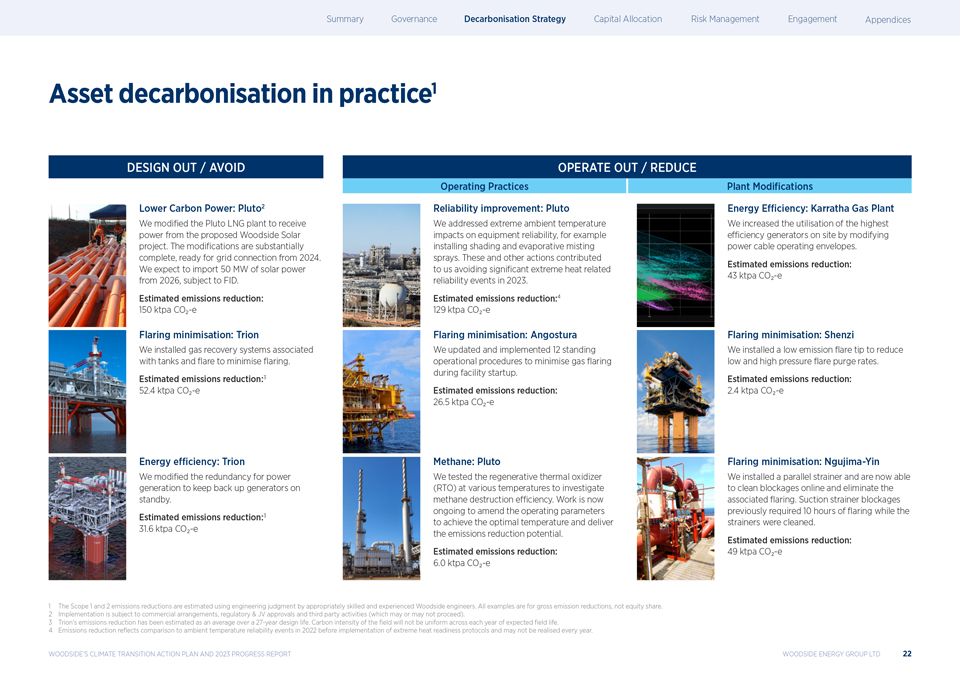 |
Asset decarbonisation in practice1 DESIGN OUT / AVOID Lower Carbon Power: Pluto2 We modi?ed the Pluto LNG plant to receive power from the proposed Woodside Solar project. The modi?cations are substantially complete, ready for grid connection from 2024. We expect to import 50 MW of solar power from 2026, subject to FID. Estimated emissions reduction: 150 ktpa CO?-e Flaring minimisation: Trion We installed gas recovery systems associated with tanks and ?are to minimise ?aring. Estimated emissions reduction:3 52.4 ktpa CO?-e Energy efficiency: Trion We modi?ed the redundancy for power generation to keep back up generators on standby. Estimated emissions reduction:3 31.6 ktpa CO?-e OPERATE OUT / REDUCE Operating Practices Plant Modi?cations Reliability improvement: Pluto Energy Efficiency: Karratha Gas Plant We addressed extreme ambient temperature We increased the utilisation of the highest impacts on equipment reliability, for example efficiency generators on site by modifying installing shading and evaporative misting power cable operating envelopes. sprays. These and other actions contributed Estimated emissions reduction: to us avoiding signi?cant extreme heat related 43 ktpa CO?-e reliability events in 2023. Estimated emissions reduction:4 129 ktpa CO?-e Flaring minimisation: Angostura Flaring minimisation: Shenzi We updated and implemented 12 standing We installed a low emission ?are tip to reduce operational procedures to minimise gas ?aring low and high pressure ?are purge rates. during facility startup. Estimated emissions reduction: Estimated emissions reduction: 2.4 ktpa CO?-e 26.5 ktpa CO?-e Methane: Pluto Flaring minimisation: Ngujima-Yin We tested the regenerative thermal oxidizer We installed a parallel strainer and are now able (RTO) at various temperatures to investigate to clean blockages online and eliminate the methane destruction efficiency. Work is now associated ?aring. Suction strainer blockages ongoing to amend the operating parameters previously required 10 hours of ?aring while the to achieve the optimal temperature and deliver strainers were cleaned. the emissions reduction potential. Estimated emissions reduction: Estimated emissions reduction: 49 ktpa CO?-e 6.0 ktpa CO?-e 1 The Scope 1 and 2 emissions reductions are estimated using engineering judgment by appropriately skilled and experienced Woodside engineers. All examples are for gross emission reductions, not equity share. 2 Implementation is subject to commercial arrangements, regulatory & JV approvals and third party activities (which may or may not proceed). 3 Trion?s emissions reduction has been estimated as an average over a 27-year design life. Carbon intensity of the field will not be uniform across each year of expected field life. 4 Emissions reduction re?ects comparison to ambient temperature reliability events in 2022 before implementation of extreme heat readiness protocols and may not be realised every year. WOODSIDE?S CLIMATE TRANSITION ACTION PLAN AND 2023 PROGRESS REPORT WOODSIDE ENERGY GROUP LTD 22
 |
Methane emissions management In January 2024, Woodside joined the UN Environment Programme?s (UNEP) flagship reporting and mitigation program, the Oil and Gas Methane Partnership (OGMP 2.0). Methane management plan: 2023 progress Methane emissions management is an important part of global efforts to limit climate change because it has a higher global warming potential than carbon dioxide, especially in the near term, and is estimated to have made the second largest contribution to human-induced climate change after carbon dioxide. Woodside?s reported methane emissions are around 0.1% of production by volume. This calculation is supported by our improving ability to directly monitor and measure methane at our facilities. It is lower than the Oil and Gas Climate Initiative (OGCI) 2025 target of below 0.2%.1 It re?ects our long standing focus on reducing methane leaks, which if they occur at sufficient volume would be a loss to our production and a potential safety hazard. We continue to strive for further reductions through our methane plan (2023 progress against four pillars of the plan is shown on the right). When we assess emissions reduction opportunities, we multiply our internal long-term cost of carbon of $80/t CO -e (real terms 2022) by 84 (an effective price for 2 methane of $6,720/t) to align with the higher global warming potential of methane in the near term. MEASURE We are improving our ability to measure methane emissions. In 2023 we: Built and maintained a database of methane emissions sources, con?rmed with selected site measurements across all operated assets. Trialled a spectrometric aerial methane measurement technique at onshore facilities. Conducted methane point source detection and quanti?cation trials from two satellite vendors to test capability. Completed strategic drone surveys trialling the use of CO /CH ratios for combustion assessment 2 4 . Piloted several fugitive detection tools including quanti?ed optical gas imaging. Partnered with the University of Western Australia to prototype novel methane sensors. REDUCE We are taking action to reduce methane emissions to near-zero at our operated assets by prioritising the mitigation of our most material sources.2 In 2023 we took action to reduce methane emissions by 2.0 ktpa including:3 Performance optimisation of wet gas seals on two boil off gas (BOG) compressors, estimated saving of 1.5 ktpa of methane. Recti?cation of a trunkline fugitive leak at the Karratha Gas Plant onshore terminal, estimated saving of 0.3 ktpa of methane. Automation of a manual venting procedure on three acid gas removal units, estimated saving of 0.2 ktpa of methane. REPORT We aim to report our methane emissions data accurately and transparently. In 2023 we: Conducted surveys which support our calculation that our methane emissions are around 0.1% (of production by volume), consistent with historical aerial (top down) and point source (bottom up) site measurements. Engaged with Australia?s Climate Change Authority to support improvement of methane reporting regulations In 2024, we joined the Oil and Gas Methane Partnership (OGMP) 2.0 to support transparent methane emissions reporting. LEAD We support the adoption of methane best practice across industry through leadership, advocacy and collaboration. In 2023 we: Led the Methane Guiding Principles ?Global Midstream Initiative?. Joined the ASEAN Methane Leadership Program to share methane reduction learnings. Sponsored the ?rst technical workshop of the Australian Energy Producers methane taskforce. Collaborated with researchers conducting science studies as part of UNEP?s International Methane Emissions Observatory?s efforts to fill knowledge gaps in methane emissions. Shared knowledge on methane management through a presentation and journal article publication at the 2023 Australian Energy Producers conference. Presented and participated in panels at the Global Methane Summit and International Gas Union conference. 1 OGCI, 2024. https://www.ogci.com/action-and-engagement/reducing-methane-emissions/#methane-target. 2 OGMP, 2023. ?Implementation Plan Guidance?, p. 2 https://ogmpartnership.com/wp-content/uploads/2023/02/OGMP-2.0-Implementation-Plan-Guidance_2.pdf. OGMP provides the OGCI collective average target for upstream operations as an example of ?near zero? emissions intensity. 3 The methane emissions reductions are estimated using engineering judgment by appropriately skilled and experienced Woodside engineers. All examples are for gross emission reductions, not equity share. WOODSIDE?S CLIMATE TRANSITION ACTION PLAN AND 2023 PROGRESS REPORT WOODSIDE ENERGY GROUP LTD 23
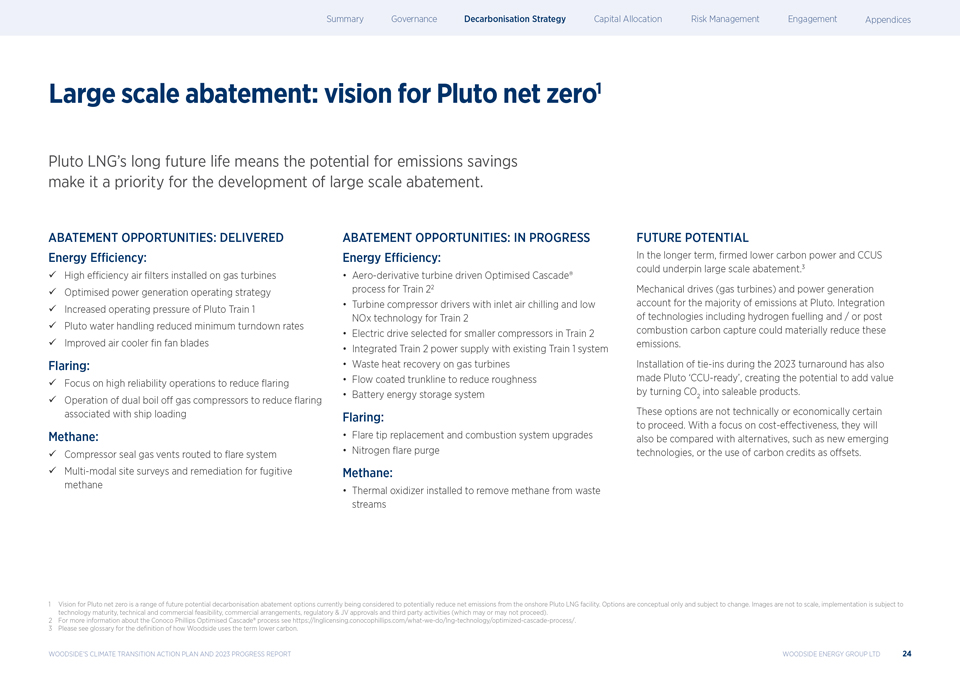 |
大规模减排:冥王星净零1冥王星液化天然气的愿景?其长期的未来寿命意味着减排的潜力使其成为发展大规模减排的优先事项。减少机会:提供的能源效率:?高效空气?安装在燃气轮机上的? 优化?发电运营策略?冥王星列车1号运行压力增加?冥王星水处理降低了最低夜床率?改进的空气冷却器?n风扇叶片扩口:?专注于高可靠性操作以减少?aring ?运行双蒸发气体压缩机以减少??与装载甲烷有关的船舶:?压缩机密封排气口路由至?系统?多模式现场调查和对散逸性甲烷减排的补救机会:正在 进展中的能源效率:用于22列涡轮压缩机驱动器的航空衍生涡轮机驱动优化级联工艺,具有入口空气冷却和低NOx?第2列的技术为第2列的小型压缩机选择电驱动器与现有的第1列系统集成的第2列电源供应燃气涡轮机废热回收流动涂层干线减少粗糙度电池储能系统燃烧:火炬尖端更换和燃烧系统升级氮气? 清除甲烷:安装了热氧化器以去除废物流中的甲烷未来潜力从长远来看,?更低碳发电和CCUS可以支持大规模减排。3机械驱动(燃气轮机)和发电 占冥王星排放的大部分。包括氢燃料和/或燃烧后碳捕集在内的技术的整合可以大大减少这些排放。在2023年的转折期间安装连接也使 冥王星?CCU准备好了吗?通过将一氧化碳转化为可销售产品,创造附加价值的潜力。2这些选择在技术上或经济上都不一定会进行。在注重成本效益的情况下,它们还将与替代品进行比较, 例如新兴技术,或使用碳信用额作为抵消。1冥王星净零排放愿景是目前正在考虑的一系列未来潜在脱碳减排方案,以潜在地减少陆上 冥王星液化天然气设施的净排放。备选方案只是概念性的,可能会有所改变。图像不按比例绘制,实施取决于技术成熟度、技术和商业可行性、商业安排、监管和合资企业批准以及 第三方活动(可能会进行也可能不会进行)。2有关康菲石油优化级联工艺的更多信息,请访问www.example.com。3请参见术语表 以了解de?伍德赛德如何使用低碳一词。伍德赛德?2023年全球气候变迁行动计划与进展报告Woodside Energy Group Limited 24
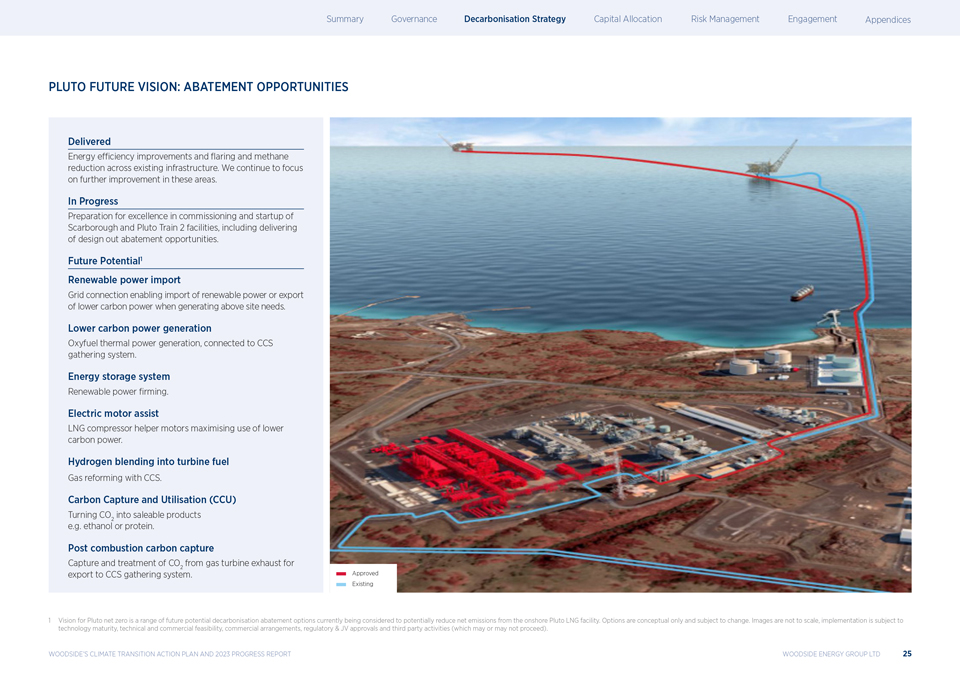 |
Pluto未来愿景:减少机遇 实现能源效率的提高和?在现有基础设施中减少甲烷和甲烷。我们将继续致力于进一步改善这些领域。正在进行中,为Scarborough 和Pluto Train 2设施的卓越调试和启动做好准备,包括提供设计出的减排机会。未来潜力1可再生能源输入电网连接,在发电厂以上需求时,可输入可再生能源或输出低碳电力。 低碳发电含氧燃料热发电,连接CCS集输系统。储能系统可再生能源?rming。电动机辅助LNG压缩机辅助电机,最大限度地利用低碳能源。氢气 混合到涡轮机燃料中使用CCS进行气体重整。碳捕集和利用(CCU)将一氧化碳转化为可销售的产品,如乙醇2或蛋白质。燃烧后碳捕集从燃气轮机排气中捕集和处理CO,以输出至CCS 集气系统2. 1冥王星净零愿景是目前正在考虑的一系列未来潜在脱碳减排方案,以潜在地减少陆上冥王星液化天然气设施的净排放。选项仅为概念性的, 可能会发生变化。图像不按比例绘制,实施取决于技术成熟度、技术和商业可行性、商业安排、监管和合资企业批准以及第三方活动(可能会进行也可能不会进行)。 伍德赛德?2023年全球气候变迁行动计划与进展报告Woodside Energy Group Limited 25
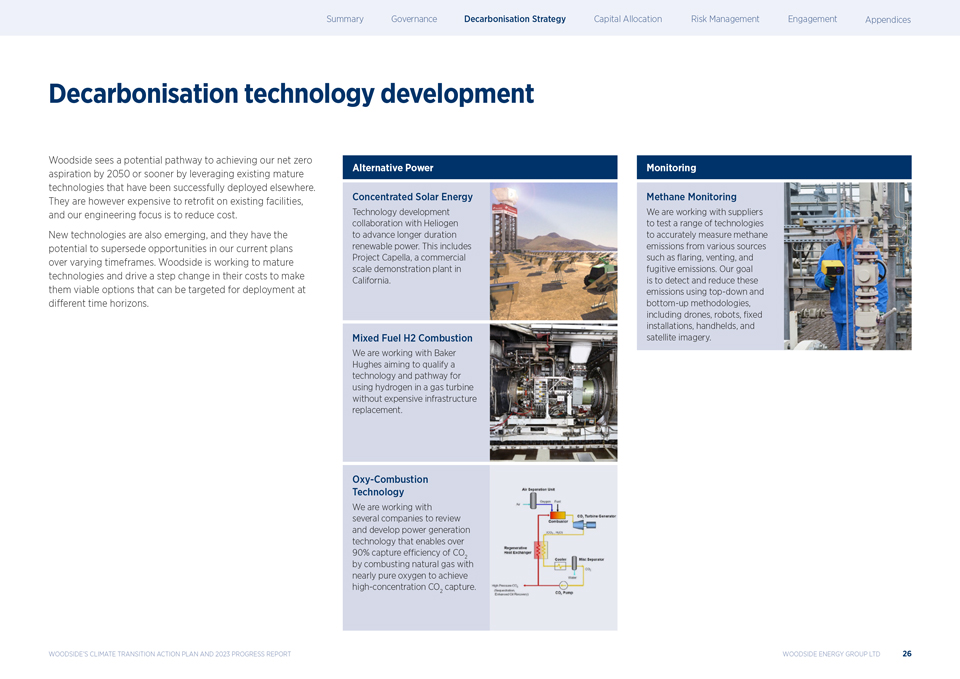 |
脱碳技术开发Woodside看到了一条潜在的途径,通过利用已在其他地方成功部署的现有成熟技术,到2050年或更早实现我们的净零排放目标。但是复古的价格贵吗?我们的工程 重点是降低成本。新技术也在不断涌现,它们有可能在不同的时间框架内取代我们当前计划中的机会。Woodside正在努力使技术成熟,并推动其成本的逐步变化, 使其成为可行的选项,可以在不同的时间范围内进行部署。与Heliogen合作开发可再生能源技术,以推进更长时间的可再生能源。其中包括加州的商业规模示范工厂 Capella项目。混合燃料H2燃烧我们正在与贝克休斯合作,旨在鉴定一种在燃气轮机中使用氢气的技术和途径,而无需昂贵的基础设施更换。 氧燃烧技术我们正在努力?有几家公司要审查开发发电技术,通过燃烧天然气和2个接近纯氧,实现高浓度CO 捕集,可实现90%以上的CO捕集效率。2监测甲烷监测我们正在与供应商合作,测试一系列技术,以准确测量各种来源的甲烷排放量,如?排放,排放和逃逸排放。我们的目标是使用自上而下和自下而上的方法来检测和减少这些排放,包括无人机、机器人,?固定的设备,手持设备,卫星图像。伍德赛德?2023年全球气候变迁行动计划与进展报告Woodside Energy Group Limited 26
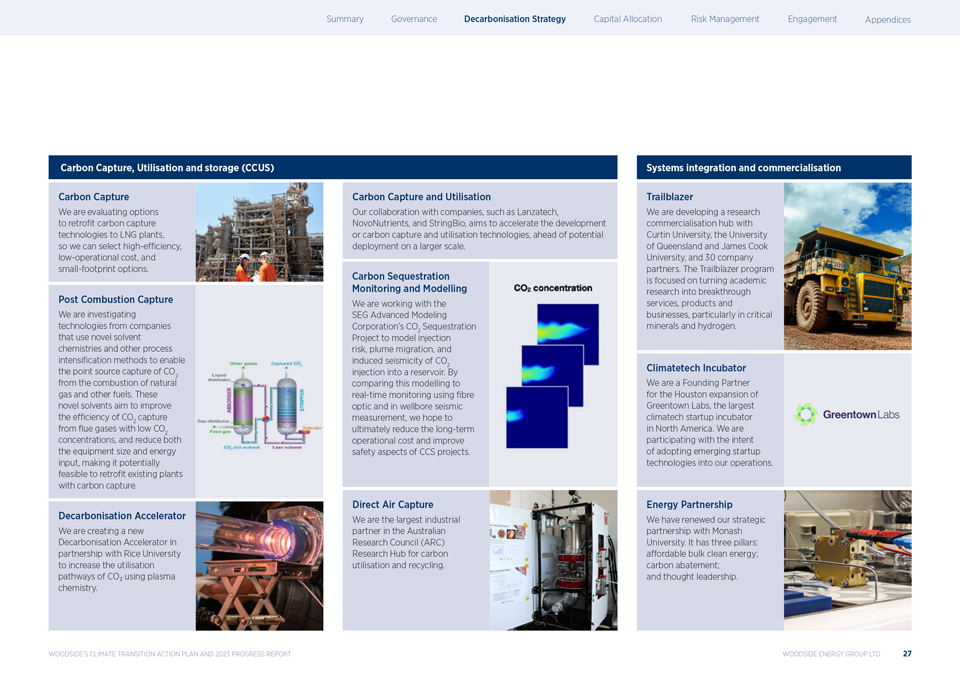 |
Carbon Capture, Utilisation and storage (CCUS) Carbon Capture We are evaluating options to retro?t carbon capture technologies to LNG plants, so we can select high-efficiency, low-operational cost, and small-footprint options. Post Combustion Capture We are investigating technologies from companies that use novel solvent chemistries and other process intensi?cation methods to enable the point source capture of CO from the combustion of natural2 gas and other fuels. These novel solvents aim to improve the efficiency of CO capture from ?ue gases with2 low CO concentrations, and reduce both 2 the equipment size and energy input, making it potentially feasible to retro?t existing plants with carbon capture. Decarbonisation Accelerator We are creating a new Decarbonisation Accelerator in partnership with Rice University to increase the utilisation pathways of CO? using plasma chemistry. Carbon Capture and Utilisation Our collaboration with companies, such as Lanzatech, NovoNutrients, and StringBio, aims to accelerate the development or carbon capture and utilisation technologies, ahead of potential deployment on a larger scale. Carbon Sequestration Monitoring and Modelling We are working with the SEG Advanced Modeling Corporation?s CO Sequestration Project to model 2 injection risk, plume migration, and induced seismicity of CO injection into a reservoir. 2 By comparing this modelling to real-time monitoring using ?bre optic and in wellbore seismic measurement, we hope to ultimately reduce the long-term operational cost and improve safety aspects of CCS projects. Direct Air Capture We are the largest industrial partner in the Australian Research Council (ARC) Research Hub for carbon utilisation and recycling. Systems integration and commercialisation Trailblazer We are developing a research commercialisation hub with Curtin University, the University of Queensland and James Cook University, and 30 company partners. The Trailblazer program is focused on turning academic research into breakthrough services, products and businesses, particularly in critical minerals and hydrogen. Climatetech Incubator We are a Founding Partner for the Houston expansion of Greentown Labs, the largest climatech startup incubator in North America. We are participating with the intent of adopting emerging startup technologies into our operations. Energy Partnership We have renewed our strategic partnership with Monash University. It has three pillars: affordable bulk clean energy; carbon abatement; and thought leadership. WOODSIDE?S CLIMATE TRANSITION ACTION PLAN AND 2023 PROGRESS REPORT WOODSIDE ENERGY GROUP LTD 27
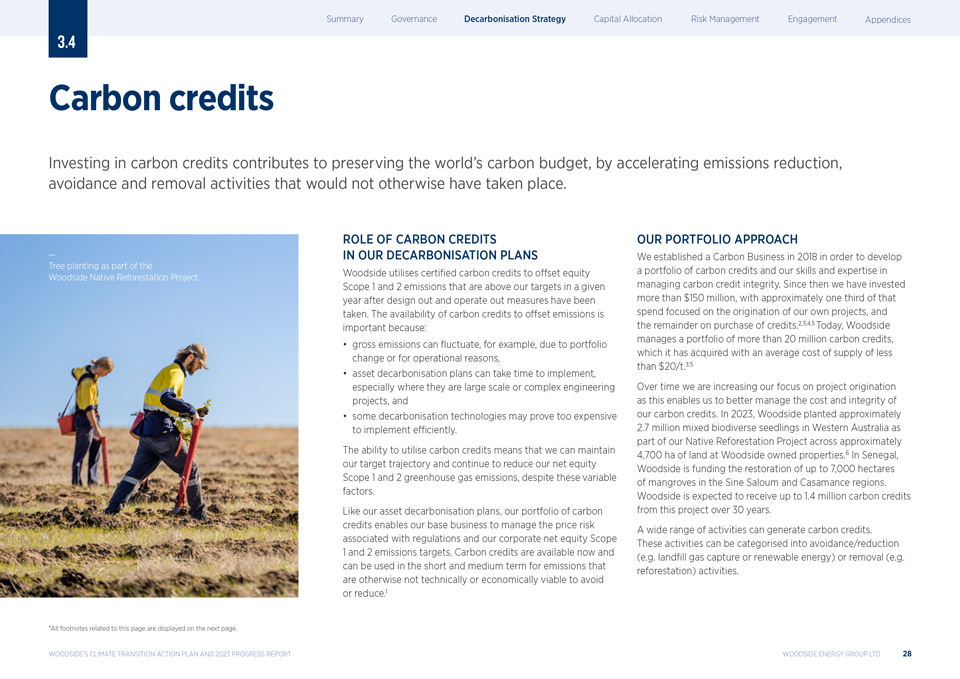 |
Carbon credits Investing in carbon credits contributes to preserving the world?s carbon budget, by accelerating emissions reduction, avoidance and removal activities that would not otherwise have taken place. ? Tree planting as part of the Woodside Native Reforestation Project. ROLE OF CARBON CREDITS IN OUR DECARBONISATION PLANS Woodside utilises certified carbon credits to offset equity Scope 1 and 2 emissions that are above our targets in a given year after design out and operate out measures have been taken. The availability of carbon credits to offset emissions is important because: gross emissions can fluctuate, for example, due to portfolio change or for operational reasons, asset decarbonisation plans can take time to implement, especially where they are large scale or complex engineering projects, and some decarbonisation technologies may prove too expensive to implement efficiently. The ability to utilise carbon credits means that we can maintain our target trajectory and continue to reduce our net equity Scope 1 and 2 greenhouse gas emissions, despite these variable factors. Like our asset decarbonisation plans, our portfolio of carbon credits enables our base business to manage the price risk associated with regulations and our corporate net equity Scope 1 and 2 emissions targets. Carbon credits are available now and can be used in the short and medium term for emissions that are otherwise not technically or economically viable to avoid or reduce.1 OUR PORTFOLIO APPROACH We established a Carbon Business in 2018 in order to develop a portfolio of carbon credits and our skills and expertise in managing carbon credit integrity. Since then we have invested more than $150 million, with approximately one third of that spend focused on the origination of our own projects, and the remainder on purchase of credits.2,3,4,5 Today, Woodside manages a portfolio of more than 20 million carbon credits, which it has acquired with an average cost of supply of less than $20/t.3,5 Over time we are increasing our focus on project origination as this enables us to better manage the cost and integrity of our carbon credits. In 2023, Woodside planted approximately 2.7 million mixed biodiverse seedlings in Western Australia as part of our Native Reforestation Project across approximately 4,700 ha of land at Woodside owned properties.6 In Senegal, Woodside is funding the restoration of up to 7,000 hectares of mangroves in the Sine Saloum and Casamance regions. Woodside is expected to receive up to 1.4 million carbon credits from this project over 30 years. A wide range of activities can generate carbon credits. These activities can be categorised into avoidance/reduction (e.g. land?ll gas capture or renewable energy) or removal (e.g. reforestation) activities. *All footnotes related to this page are displayed on the next page. WOODSIDE?S CLIMATE TRANSITION ACTION PLAN AND 2023 PROGRESS REPORT WOODSIDE ENERGY GROUP LTD 28
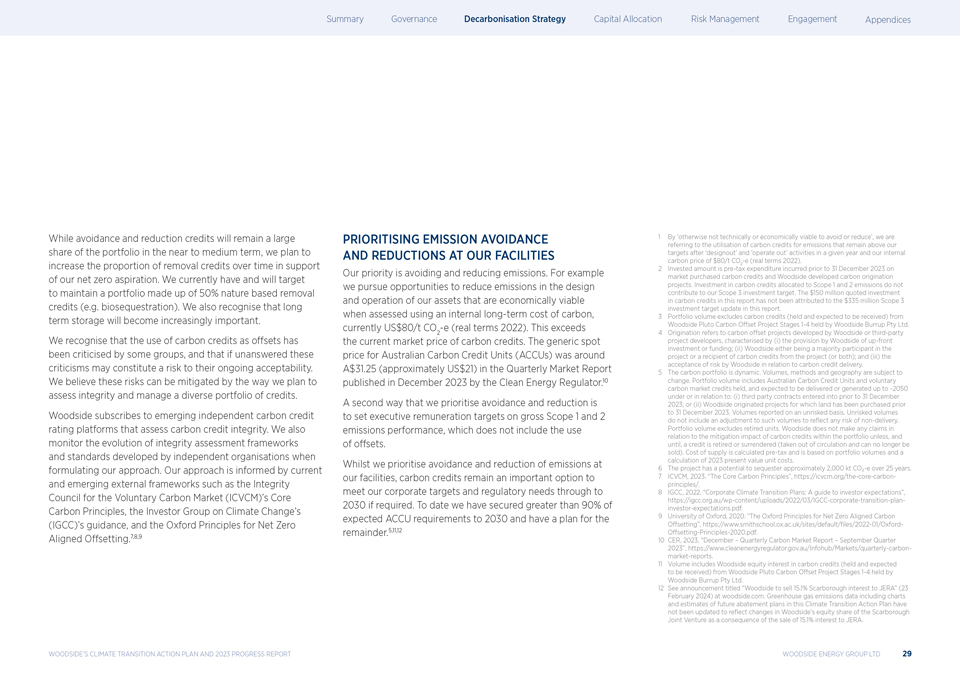 |
虽然在近期至中期内,避免和减少信贷仍将占投资组合的很大份额,但我们计划随着时间的推移增加清除信贷的比例,以支持我们的净零目标。我们目前拥有并将目标维持一个由50%基于自然的 清除信用(例如生物封存)组成的投资组合。我们也认识到,长期存储将变得越来越重要。我们认识到,使用碳信用额作为抵消受到了一些团体的批评,如果这些批评得不到回应, 可能会对其持续的可接受性构成风险。我们相信,这些风险可以通过我们计划评估诚信和管理多样化信贷组合的方式来减轻。Woodside订阅新兴的独立碳信用评级 平台,评估碳信用的完整性。我们亦会在制定方法时监察独立机构制定的诚信评估框架及标准的演变。我们的方法受到当前和新兴的 外部框架的影响,如自愿碳市场诚信委员会(ICVCM)?气候变化投资者组织的核心碳原则?s(IGCC)?7,8,9在我们的设施中优先避免和减少排放我们的首要任务是避免和减少排放。例如,我们寻求机会,在设计和运营我们的资产时,当使用内部长期碳成本(目前为80美元/吨二氧化碳当量(2022年实际价值)进行评估时,这些资产在经济上是可行的。这超过了目前碳信用额的市场价格2。在清洁能源监管机构于二零二三年十二月公布的季度市场报告中,澳大利亚碳信用单位(ACCU)的通用现货价格约为31. 25澳元(约21美元)。 虽然我们优先考虑避免和减少设施的排放,但碳排放额度仍然是实现我们公司目标和监管需求的重要选择,直至2030年(如果需要)。到目前为止,我们已经获得了到2030年预期ACCU需求的90%以上,并制定了一个规划。否则在技术上或经济上都不可行,以避免或减少?我们指的是使用 碳信用额来处理在之后仍然高于我们的目标的排放量?designout?然后呢?手术了吗我们的内部碳价格为80美元/吨CO—E(2022年实际价格)。 22投资金额为于二零二三年十二月三十一日之前就市场购买碳信用额及Woodside开发的碳来源项目产生的税前开支。分配至范围1和范围2排放的碳信用额投资不会有助于实现我们的范围3投资目标。本报告中引用的1.5亿美元碳信用额度投资未归因于本报告中3.35亿美元的范围3投资目标更新。3投资组合数量不包括碳信用额(持有并预期收到)来自Woodside Pluto碳抵消 由Woodside Burght Pty Ltd.持有的项目阶段1—4。4起源指Woodside或第三方项目开发商开发的碳抵消项目,其特征在于(i)Woodside提供前期投资或资金;(ii) Woodside是项目的多数参与者或项目的碳信用额接受者(或两者兼有);及(iii)Woodside接受与碳信用额交付有关的风险。5碳投资组合是动态的。方法、 和地理位置可能会发生变化。投资组合数量包括持有的澳大利亚碳信用单位和自愿碳市场信用,并预计将根据或与以下各项相关交付或产生至2050年:(i)2023年12月31日之前订立的第三方合同;或(ii)2023年12月31日之前购买土地的伍德赛德起源项目。该公司在没有风险的基础上报告了。无风险量不包括对此类量的调整,以重新?排除 任何无法交付的风险。投资组合数量不包括已退休的单位。Woodside不就投资组合中碳信用额度的缓解影响提出任何索赔,除非且直到某个信用额度被收回或放弃(从 循环中取出,并且不能再出售)。6该项目有可能在25年内封存约2,000千吨CO?-E。?核心碳原则?,https://icvcm.org/the-core-carbon-principles/.8 IGCC,2022年。?企业环境转型计划:投资者预期指南?, https://igcc.org.au/wp-content/uploads/2022/03/IGCC-corporate-transition-plan-investor-expectations.pdf.牛津大学,2020年。?《牛津净零对齐碳补偿原则》, https://www.smithschool.ox.ac.uk/sites/default/files/2022-01/Oxford-Offsetting-Principles-2020.pdf.2023年,10 CER。?十二月?碳市场季度报告?2023年9月季度?, https://www.cleanenergyregulator.gov.au/Infohub/Markets/quarterly-carbon-market-reports.11卷包括Woodside Burrup Pty Ltd.持有的Woodside Pluto碳抵消项目阶段1-4的碳信用(持有并预计将收到)的伍德赛德股权。12参见伍德赛德将向jera出售15.1%斯卡伯勒权益?(2024年2月23日)的公告。本气候过渡行动计划中的温室气体排放数据(包括图表和未来减排计划的估计)尚未更新,以反映由于向JERA出售15.1%的权益而导致伍德赛德?S在斯卡伯勒合资企业中的股权份额的变化。
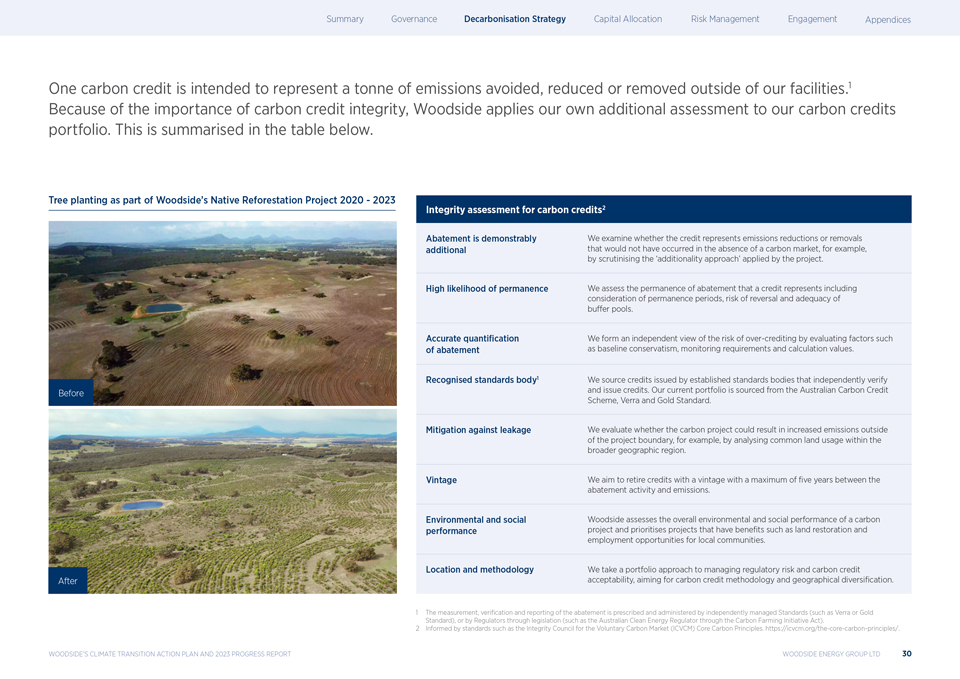 |
One carbon credit is intended to represent a tonne of emissions avoided, reduced or removed outside of our facilities.1 Because of the importance of carbon credit integrity, Woodside applies our own additional assessment to our carbon credits portfolio. This is summarised in the table below. Tree planting as part of Woodside?s Native Reforestation Project 2020—2023 Integrity assessment for carbon credits2 Abatement is demonstrably We examine whether the credit represents emissions reductions or removals additional that would not have occurred in the absence of a carbon market, for example, by scrutinising the ?additionality approach? applied by the project. High likelihood of permanence We assess the permanence of abatement that a credit represents including consideration of permanence periods, risk of reversal and adequacy of buffer pools. Accurate quanti?cation We form an independent view of the risk of over-crediting by evaluating factors such of abatement as baseline conservatism, monitoring requirements and calculation values. Recognised standards body1 We source credits issued by established standards bodies that independently verify and issue credits. Our current portfolio is sourced from the Australian Carbon Credit Scheme, Verra and Gold Standard. Mitigation against leakage We evaluate whether the carbon project could result in increased emissions outside of the project boundary, for example, by analysing common land usage within the broader geographic region. Vintage We aim to retire credits with a vintage with a maximum of ?ve years between the abatement activity and emissions. Environmental and social Woodside assesses the overall environmental and social performance of a carbon performance project and prioritises projects that have bene?ts such as land restoration and employment opportunities for local communities. Location and methodology We take a portfolio approach to managing regulatory risk and carbon credit acceptability, aiming for carbon credit methodology and geographical diversi?cation. 1 The measurement, veri?cation and reporting of the abatement is prescribed and administered by independently managed Standards (such as Verra or Gold Standard), or by Regulators through legislation (such as the Australian Clean Energy Regulator through the Carbon Farming Initiative Act). 2 Informed by standards such as the Integrity Council for the Voluntary Carbon Market (ICVCM) Core Carbon Principles. https://icvcm.org/the-core-carbon-principles/. WOODSIDE?S CLIMATE TRANSITION ACTION PLAN AND 2023 PROGRESS REPORT WOODSIDE ENERGY GROUP LTD 30
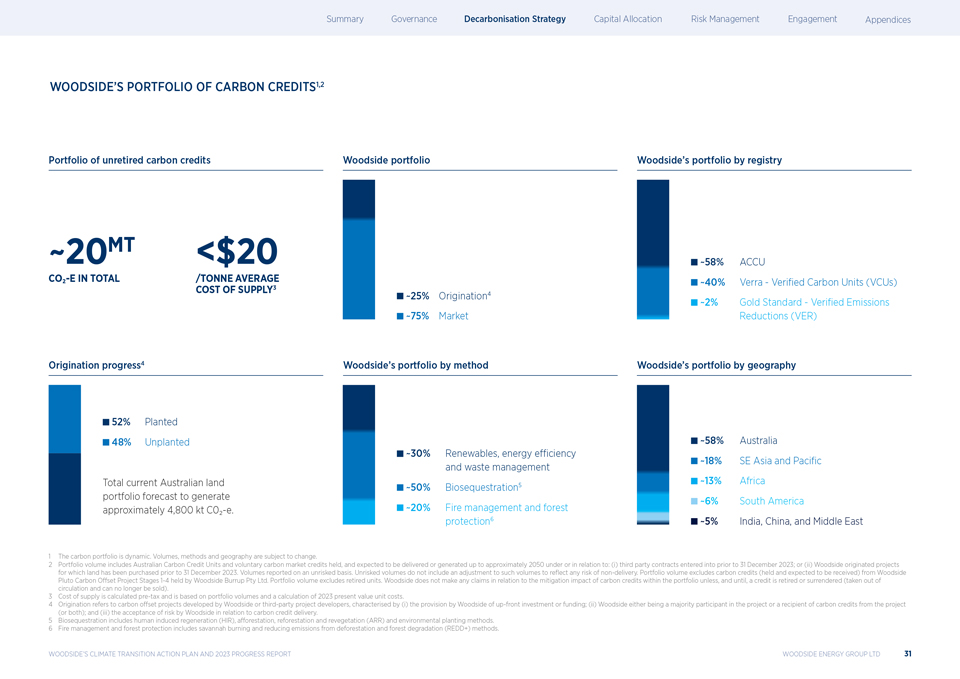 |
伍德赛德?碳信用投资组合1,2未退休碳信用投资组合 伍德赛德投资组合?s投资组合按注册表~20MT
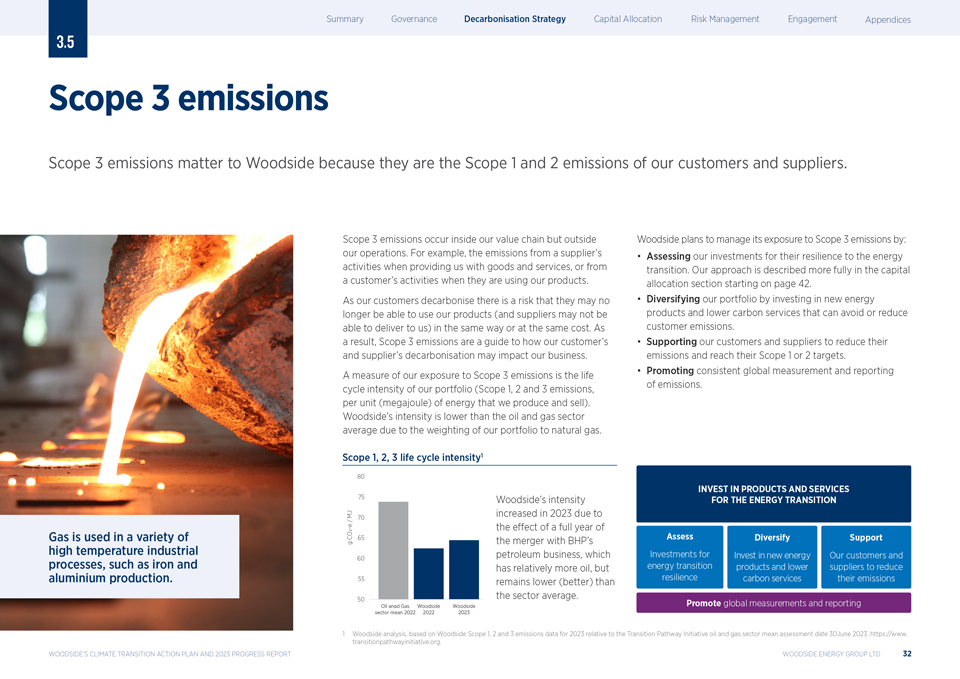 |
3.5范围3排放范围3排放对 Woodside很重要,因为它们是我们客户和供应商的范围1和2排放。范围3的排放发生在我们的价值链内,但在我们的运营之外。例如,供应商的排放量?在向我们提供商品和 服务时,或从客户那里进行的活动?当他们使用我们的产品时。随着我们的客户脱碳,他们可能无法再以同样的方式或 同样的成本使用我们的产品(供应商可能无法向我们交付产品)。因此,范围3排放是一个指南,如何我们的客户?S和供应商?我们的脱碳可能会影响我们的业务。衡量范围3排放风险的一个指标是我们产品组合的生命周期强度(范围1、2和3排放,我们生产和销售的每单位(兆焦耳)能源)。伍德赛德?由于我们的投资组合对天然气的权重,其强度低于石油和天然气行业的平均水平。Woodside计划通过以下方式管理其对范围3排放的敞口 :评估我们的投资对能源转型的弹性。我们的方法将在第42页开始的资本分配一节中作更全面的介绍。通过投资于新能源产品和低碳 服务,使我们的产品组合多样化,以避免或减少客户排放。支持我们的客户和供应商减少排放,并达到范围1或2的目标。促进一致的全球排放量计量和报告。气体用于各种 高温工业过程,如铁和铝生产。范围1、2、3生命周期强度1 Woodside?由于与必和必拓合并整整一年的影响,2023年的强度有所增加?美国的石油业务, 石油相对较多,但仍低于(好于)行业平均水平。伍德赛德?气候过渡行动计划和2023年进展报告1伍德赛德分析,基于伍德赛德范围1、2和3的2023年排放数据,相对于过渡 路径倡议石油和天然气部门平均评估日期2023年6月30日。https://www. transitionpathwayinitiation.org.伍德赛德能源集团有限公司32
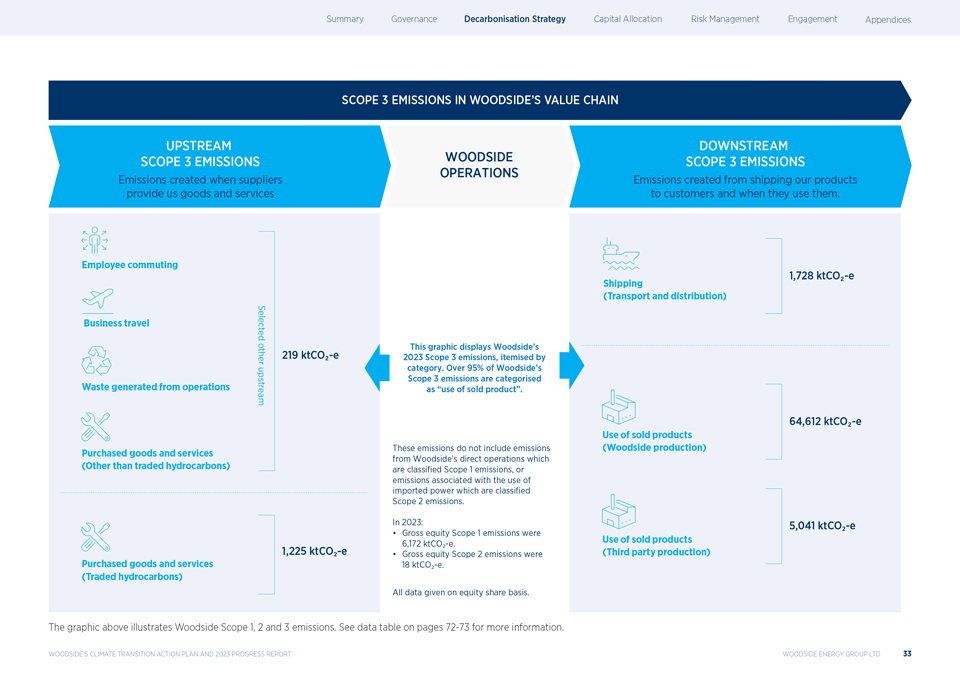 |
上游范围3排放 供应商向我们提供货物和服务时产生的排放木材作业下游范围3排放将我们的产品运送给客户以及客户使用时产生的排放。员工通勤商务差旅运营产生的废物采购 货物和服务(贸易碳氢化合物除外)(贸易碳氢化合物)选定的其他上游(运输和分销)1,728 ktCO_e销售产品的使用(Woodside生产) 64,612 ktCO_—e销售产品的使用(第三方生产)5,041 ktCO_—e此图显示Woodside?2023年范围3排放,按类别分列。超过95%的伍德赛德?s范围3的排放被分类为?销售产品的使用?这些 排放不包括伍德赛德的排放?分类为范围1排放的直接操作,或分类为范围2排放的与使用进口电力有关的排放。2023年:总权益范围1排放量为 6,172 ktCO—e。总权益范围2排放量为18吨二氧化碳当量。所有数据均以权益份额为基础。上图显示了Woodside范围1、2和3的排放。更多信息见第72—73页的数据表。伍德赛德?气候变迁 行动计划与2023年进展报告伍德赛德能源集团有限公司33
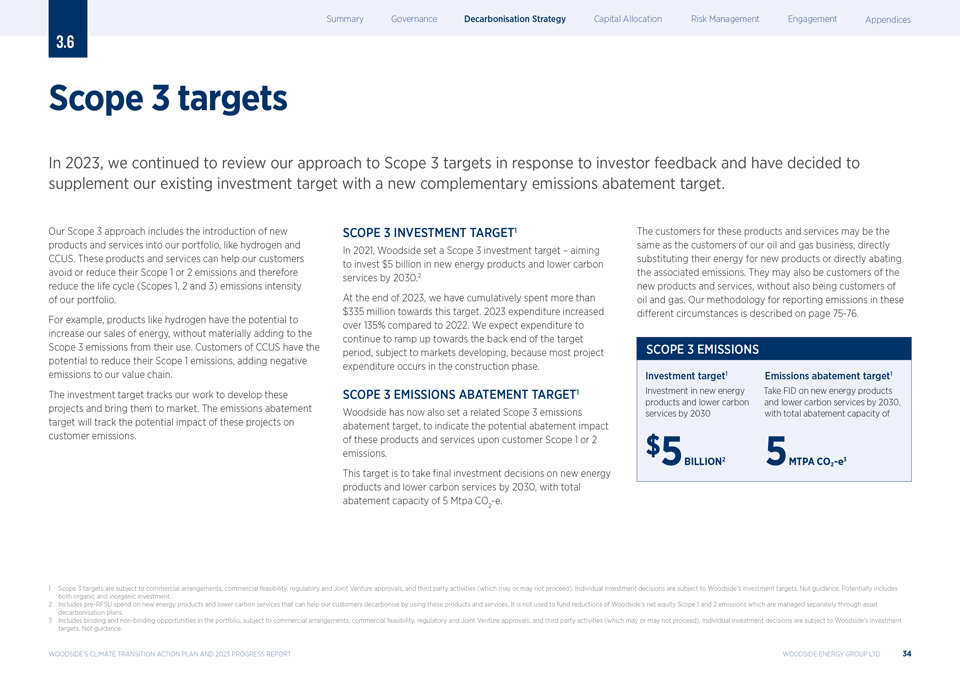 |
3.6 Scope 3 targets In 2023, we continued to review our approach to Scope 3 targets in response to investor feedback and have decided to supplement our existing investment target with a new complementary emissions abatement target. Our Scope 3 approach includes the introduction of new products and services into our portfolio, like hydrogen and CCUS. These products and services can help our customers avoid or reduce their Scope 1 or 2 emissions and therefore reduce the life cycle (Scopes 1, 2 and 3) emissions intensity of our portfolio. For example, products like hydrogen have the potential to increase our sales of energy, without materially adding to the Scope 3 emissions from their use. Customers of CCUS have the potential to reduce their Scope 1 emissions, adding negative emissions to our value chain. The investment target tracks our work to develop these projects and bring them to market. The emissions abatement target will track the potential impact of these projects on customer emissions. SCOPE 3 INVESTMENT TARGET1 In 2021, Woodside set a Scope 3 investment target ? aiming to invest $5 billion in new energy products and lower carbon services by 2030.2 At the end of 2023, we have cumulatively spent more than $335 million towards this target. 2023 expenditure increased over 135% compared to 2022. We expect expenditure to continue to ramp up towards the back end of the target period, subject to markets developing, because most project expenditure occurs in the construction phase. SCOPE 3 EMISSIONS ABATEMENT TARGET1 Woodside has now also set a related Scope 3 emissions abatement target, to indicate the potential abatement impact of these products and services upon customer Scope 1 or 2 emissions. This target is to take ?nal investment decisions on new energy products and lower carbon services by 2030, with total abatement capacity of 5 Mtpa CO -e. 2 The customers for these products and services may be the same as the customers of our oil and gas business, directly substituting their energy for new products or directly abating the associated emissions. They may also be customers of the new products and services, without also being customers of oil and gas. Our methodology for reporting emissions in these different circumstances is described on page 75-76. SCOPE 3 EMISSIONS Investment target1 Emissions abatement target1 Investment in new energy Take FID on new energy products products and lower carbon and lower carbon services by 2030, services by 2030 with total abatement capacity of $ 5BILLION2 5MTPA CO?-e3 1 Scope 3 targets are subject to commercial arrangements, commercial feasibility, regulatory and Joint Venture approvals, and third party activities (which may or may not proceed). Individual investment decisions are subject to Woodside?s investment targets. Not guidance. Potentially includes both organic and inorganic investment. 2 Includes pre-RFSU spend on new energy products and lower carbon services that can help our customers decarbonise by using these products and services. It is not used to fund reductions of Woodside?s net equity Scope 1 and 2 emissions which are managed separately through asset decarbonisation plans. 3 Includes binding and non-binding opportunities in the portfolio, subject to commercial arrangements, commercial feasibility, regulatory and Joint Venture approvals, and third party activities (which may or may not proceed). Individual investment decisions are subject to Woodside?s investment targets. Not guidance. WOODSIDE?S CLIMATE TRANSITION ACTION PLAN AND 2023 PROGRESS REPORT WOODSIDE ENERGY GROUP LTD 34
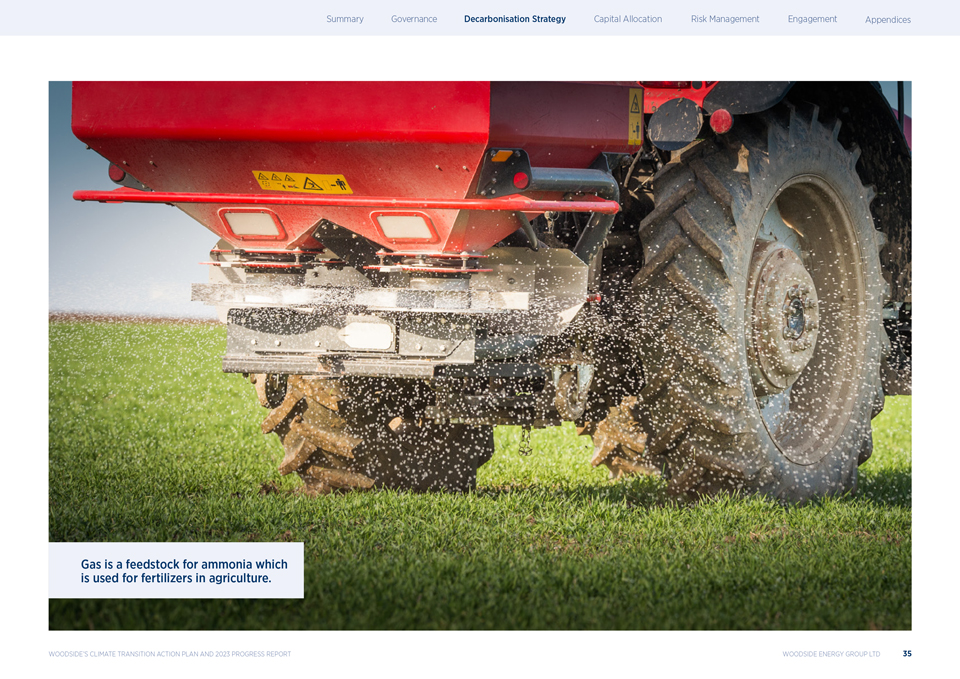 |
天然气是生产氨的原料,氨在农业中用于 化肥。伍德赛德?2023年全球气候变迁行动计划与进展报告Woodside Energy Group Limited 35
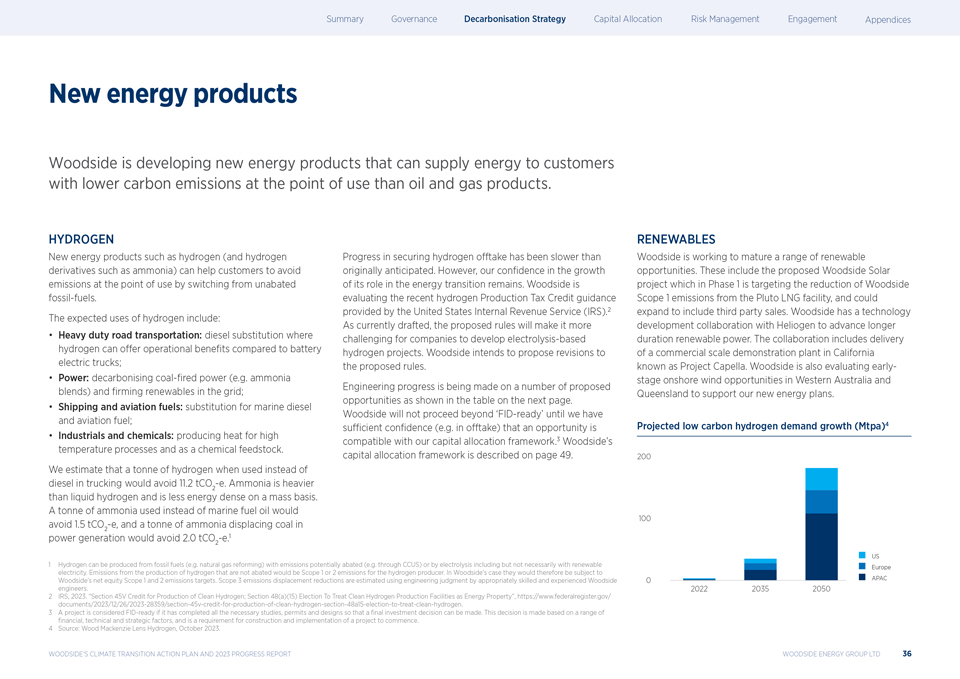 |
New energy products Woodside is developing new energy products that can supply energy to customers with lower carbon emissions at the point of use than oil and gas products. HYDROGEN New energy products such as hydrogen (and hydrogen derivatives such as ammonia) can help customers to avoid emissions at the point of use by switching from unabated fossil-fuels. The expected uses of hydrogen include: Heavy duty road transportation: diesel substitution where hydrogen can offer operational bene?ts compared to battery electric trucks; Power: decarbonising coal-?red power (e.g. ammonia blends) and ?rming renewables in the grid; Shipping and aviation fuels: substitution for marine diesel and aviation fuel; Industrials and chemicals: producing heat for high temperature processes and as a chemical feedstock. We estimate that a tonne of hydrogen when used instead of diesel in trucking would avoid 11.2 tCO -e. Ammonia is heavier than liquid hydrogen and is less energy 2 dense on a mass basis. A tonne of ammonia used instead of marine fuel oil would avoid 1.5 tCO -e, and a tonne of ammonia displacing coal in 2 power generation would avoid 2.0 tCO -e.1 2 Progress in securing hydrogen offtake has been slower than originally anticipated. However, our con?dence in the growth of its role in the energy transition remains. Woodside is evaluating the recent hydrogen Production Tax Credit guidance provided by the United States Internal Revenue Service (IRS).2 As currently drafted, the proposed rules will make it more challenging for companies to develop electrolysis-based hydrogen projects. Woodside intends to propose revisions to the proposed rules. Engineering progress is being made on a number of proposed opportunities as shown in the table on the next page. Woodside will not proceed beyond ?FID-ready? until we have sufficient confidence (e.g. in offtake) that an opportunity is compatible with our capital allocation framework.3 Woodside?s capital allocation framework is described on page 49. RENEWABLES Woodside is working to mature a range of renewable opportunities. These include the proposed Woodside Solar project which in Phase 1 is targeting the reduction of Woodside Scope 1 emissions from the Pluto LNG facility, and could expand to include third party sales. Woodside has a technology development collaboration with Heliogen to advance longer duration renewable power. The collaboration includes delivery of a commercial scale demonstration plant in California known as Project Capella. Woodside is also evaluating early-stage onshore wind opportunities in Western Australia and Queensland to support our new energy plans. Projected low carbon hydrogen demand growth (Mtpa)4 1 Hydrogen can be produced from fossil fuels (e.g. natural gas reforming) with emissions potentially abated (e.g. through CCUS) or by electrolysis including but not necessarily with renewable electricity. Emissions from the production of hydrogen that are not abated would be Scope 1 or 2 emissions for the hydrogen producer. In Woodside?s case they would therefore be subject to Woodside?s net equity Scope 1 and 2 emissions targets. Scope 3 emissions displacement reductions are estimated using engineering judgment by appropriately skilled and experienced Woodside engineers. 2 IRS, 2023. ?Section 45V Credit for Production of Clean Hydrogen; Section 48(a)(15) Election To Treat Clean Hydrogen Production Facilities as Energy Property?, https://www.federalregister.gov/ documents/2023/12/26/2023-28359/section-45v-credit-for-production-of-clean-hydrogen-section-48a15-election-to-treat-clean-hydrogen. 3 A project is considered FID-ready if it has completed all the necessary studies, permits and designs so that a ?nal investment decision can be made. This decision is made based on a range of ?nancial, technical and strategic factors, and is a requirement for construction and implementation of a project to commence. 4 Source: Wood Mackenzie Lens Hydrogen, October 2023. WOODSIDE?S CLIMATE TRANSITION ACTION PLAN AND 2023 PROGRESS REPORT WOODSIDE ENERGY GROUP LTD 36
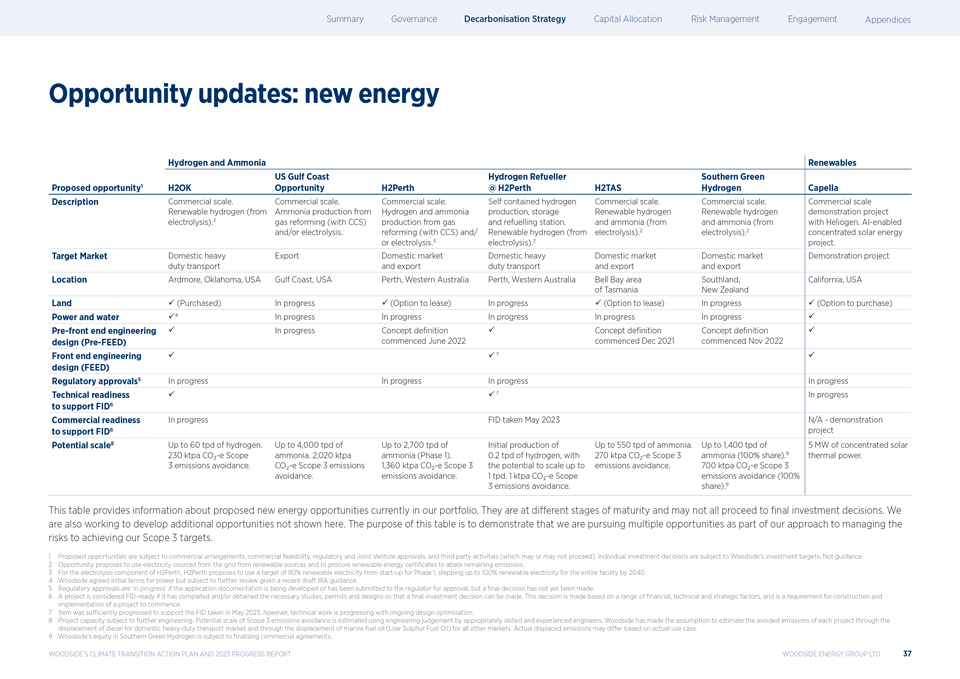 |
机会更新:新能源氢气和氨 可再生能源美国墨西哥湾沿岸氢气加油商Southern Green提议的机会1 H2 OK机会H2 Perth@H2 Perth H2 TAS氢Capella描述商业规模。商业规模。商业规模。自含式氢气商业规模。 商业规模。工业规模可再生氢(来自制氢制氨、储存可再生氢可再生氢示范项目电解)2.气体重整(带CCS)从天然气生产和加气站。和氨(来自)和氨(来自氦。人工智能启用和/或电解。重整(使用CCS)和/或可再生氢(来自电解).2.电解).2.集中太阳能或电解.3.电解).目标市场国内重型出口国内市场重型国内市场国内市场示范项目关税运输和出口关税运输以及出口和出口地点阿德莫尔,俄克拉何马州,美国墨西哥湾,美国珀斯,西澳大利亚州珀斯,西澳大利亚州贝尔湾区南区,加利福尼亚州,美国塔斯马尼亚州新西兰土地??(购买)正在进行??(选择租赁)正在进行??(选择租赁)正在进行??(选择购买)水电?4正在进行中?前端工程?正在进行的概念定义?概念定义?设计(进料前)2022年6月开始2021年12月开始2022年11月前端工程?7?设计(FEED)监管审批5正在进行技术准备??7正在进行以支持FID6正在进行的商业准备FID 2023年5月不适用演示以支持FID6项目的潜在规模8至60吨/日的氢气。日产量高达4,000吨,初期日产量高达2,700吨,氨日产量高达550吨。高达1,400吨/日的5兆瓦聚光太阳能230吨/年的CO?-E示踪器氨。2,020 ktpa氨(第一阶段)。每天0.2tpd的氢气,270ktpa的CO?-e示波器3氨(100%份额).9火力。3避免排放。CO?-E范围3排放1,360 ktpa CO?-E范围3扩大到避免排放的可能性。700 ktpa CO?-E范围3避让。避免排放 。1 tpd。1 ktpa CO?-E范围排放避免(100%3排放避免此表提供了有关我们目前投资组合中的拟议新能源机会的信息。它们处于不同的成熟阶段,可能不会全部进入投资决策阶段。我们还在努力开发这里没有显示的更多机会。此表的目的是展示我们正在寻求多个机会作为我们管理风险的方法的一部分 以实现我们的范围3目标。1建议的机会取决于商业安排、商业可行性、监管和合资企业的批准,以及第三方活动(可能进行也可能不进行)。个人投资 以伍德赛德?S的投资目标为准。而不是指导。机遇号建议使用来自可再生能源的电网电力,并采购可再生能源证书,以减少剩余的排放。3对于H2 Perth的电解组件,H2 Perth建议在第一阶段使用80%的可再生电力,到2040年整个设施的可再生电力逐步达到100%。4伍德赛德同意了权力的初步条款,但 根据最近的爱尔兰共和军指导草案进行了进一步审查。5监管审批正在进行中吗?申请文件正在编制或已提交监管机构审批,但尚未做出最终决定的 。6如果一个项目已经完成和/或获得了必要的研究、许可和设计,以便作出投资决定,则该项目被视为FID准备就绪。这一决定是基于一系列财务、技术和战略因素作出的,是项目开始建设和实施的要求。7项工作进展充分,足以支持2023年5月进行的FID,然而,技术工作正在进行设计优化。8项目 容量有待进一步设计。范围3排放避免的潜在规模是由具有适当技能和经验的工程师利用工程判断来估计的。伍德赛德假设通过为国内重型运输市场置换柴油和通过为所有其他市场置换船用燃料油(低硫燃料油)来估计每个项目的避免排放量。实际置换排放可能会根据实际使用案例而有所不同。 9伍德赛德?S在南方绿色氢气的股权有待最终敲定商业协议。伍德赛德?S气候转型行动计划和2023年进展报告伍德赛德能源集团有限公司37
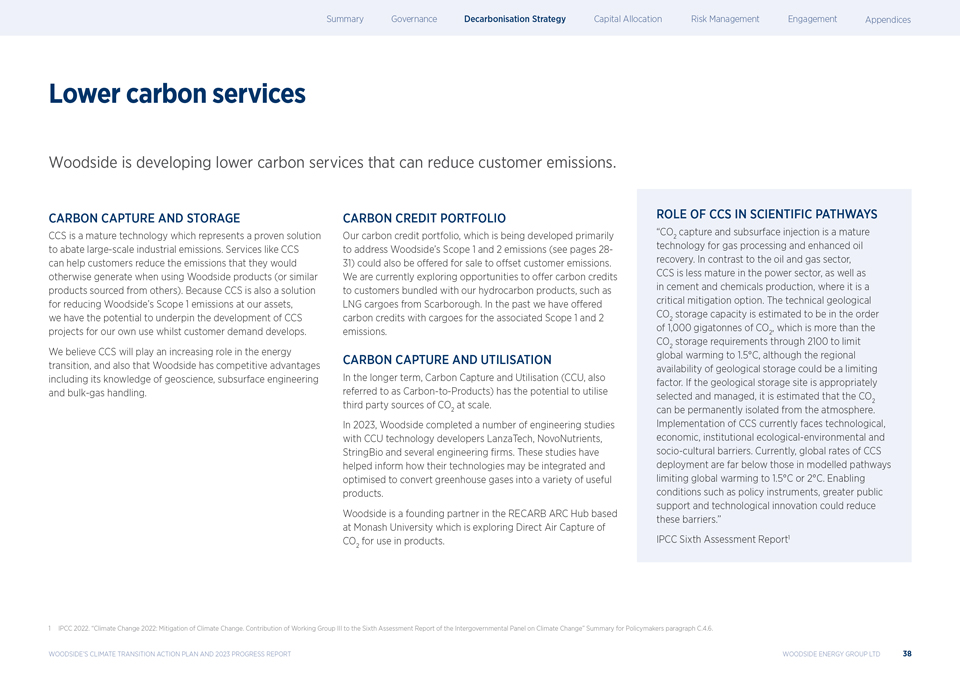 |
低碳服务伍德赛德正在开发可减少客户排放的低碳服务。碳捕获和储存CCS是一项成熟的技术,代表了一种经过验证的减少大规模工业排放的解决方案。像CCS这样的服务可以帮助客户减少他们在使用Woodside产品(或来自其他来源的类似产品)时会产生的排放。由于CCS也是减少我们资产中伍德赛德?S范围1排放的解决方案,因此我们有潜力在客户需求发展的同时支持我们自己使用的CCS项目的开发。我们相信CCS将在能源转型中发挥越来越大的作用,伍德赛德也拥有竞争优势,包括其在地球科学、地下工程和散装天然气处理方面的知识。碳信用组合我们的碳信用组合主要是为了解决伍德赛德?S范围1和2的排放问题而开发的(见第28-31页)也可以出售,以抵消客户的排放。我们目前正在探索向与我们的碳氢化合物产品捆绑在一起的客户提供碳信用的机会,例如来自斯卡伯勒的液化天然气货物。在过去,我们为相关的范围1和2的排放提供货物的碳信用。碳捕获和利用从长远来看,碳捕获和利用(CCU,也称为碳转化产品)有可能大规模利用第三方来源的CO。2 2023年,伍德赛德与CCU技术开发商LanzaTech、NovoNutrients、StringBio和几家工程公司一起完成了多项工程研究 。这些研究有助于了解如何整合和优化他们的技术,以将温室气体转化为各种有用的产品。 Woodside是莫纳什大学RECARB ARC Hub的创始合作伙伴,该中心正在探索直接空气捕获CO用于产品。2 CCS在科学途径中的作用?CO捕获和地下注入是一项成熟的天然气处理和提高石油采收率的技术2。与石油和天然气部门相比,CCS在电力部门以及水泥和化学品生产方面不那么成熟,在这些领域,CCS是一个关键的缓解选择。技术地质CO存储容量估计约为1,000~20亿吨CO,高于将全球变暖控制在1.5摄氏度以内的CO存储需求2到2100,尽管区域地质存储的可用性可能是一个限制因素 。如果适当地选择和管理地质储存地点,估计可以将CO与大气永久隔离2。CCS的实施目前面临技术、经济、体制、生态环境和社会文化障碍。目前,全球部署CCS的速度远远低于将全球变暖限制在1.5摄氏度或2摄氏度以内的模拟路径。政策手段、更大的公共支持和技术创新等有利条件可以减少这些障碍。气专委第六次评估报告1气专委2022年。《2022年气候变化:减缓气候变化》。第三工作组对政府间气候变化专门委员会第六次评估报告的贡献?供决策者参考的摘要,第C.4.6段。伍德赛德?S气候转型行动计划和2023年进展报告伍德赛德能源集团有限公司38
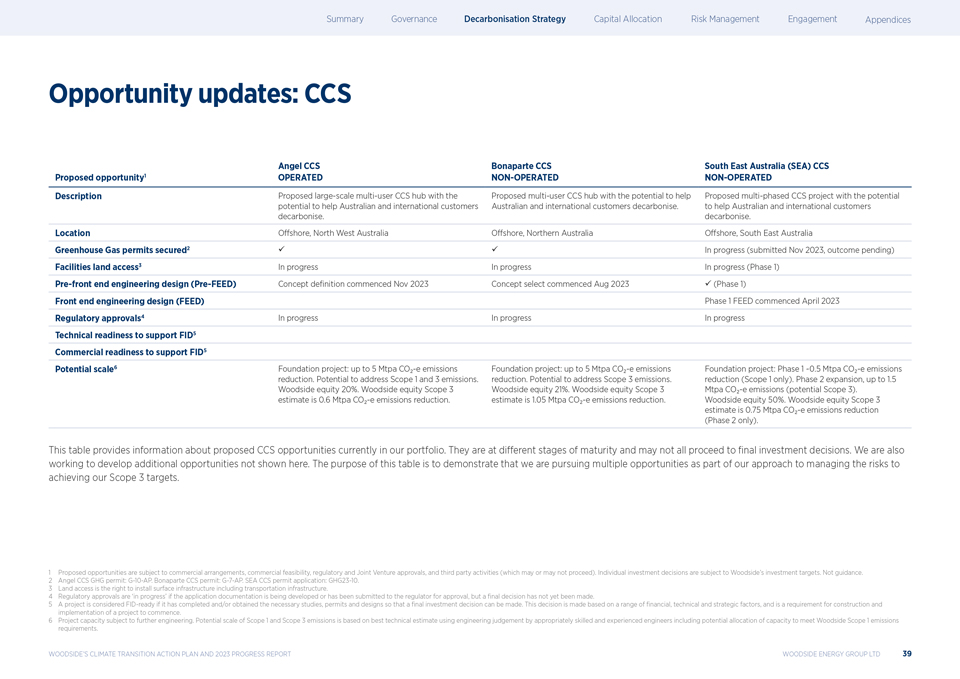 |
Opportunity updates: CCS Angel CCS Bonaparte CCS South East Australia (SEA) CCS Proposed opportunity(1) OPERATED NON-OPERATED NON-OPERATED Description Proposed large-scale multi-user CCS hub with the Proposed multi-user CCS hub with the potential to help Proposed multi-phased CCS project with the potential potential to help Australian and international customers Australian and international customers decarbonise. to help Australian and international customers decarbonise. decarbonise. Location Offshore, North West Australia Offshore, Northern Australia Offshore, South East Australia Greenhouse Gas permits secured(2) 9 9 In progress (submitted Nov 2023, outcome pending) Facilities land access(3) In progress In progress In progress (Phase 1) Pre-front end engineering design (Pre-FEED) Concept definition commenced Nov 2023 Concept select commenced Aug 2023 9 (Phase 1) Front end engineering design (FEED) Phase 1 FEED commenced April 2023 Regulatory approvals(4) In progress In progress In progress Technical readiness to support FID(5) Commercial readiness to support FID(5) Potential scale(6) Foundation project: up to 5 Mtpa CO -e emissions Foundation project: up to 5 Mtpa CO -e emissions Foundation project: Phase 1 ~0.5 Mtpa CO -e emissions reduction. Potential to address Scope 1 and 3 emissions. reduction. Potential to address Scope 3 emissions. reduction (Scope 1 only). Phase 2 expansion, up to 1.5 Woodside equity 20%. Woodside equity Scope 3 Woodside equity 21%. Woodside equity Scope 3 Mtpa CO -e emissions (potential Scope 3). estimate is 0.6 Mtpa CO -e emissions reduction. estimate is 1.05 Mtpa CO -e emissions reduction. Woodside equity 50%. Woodside equity Scope 3 estimate is 0.75 Mtpa CO -e emissions reduction (Phase 2 only). This table provides information about proposed CCS opportunities currently in our portfolio. They are at different stages of maturity and may not all proceed to ?nal investment decisions. We are also working to develop additional opportunities not shown here. The purpose of this table is to demonstrate that we are pursuing multiple opportunities as part of our approach to managing the risks to achieving our Scope 3 targets. 1 Proposed opportunities are subject to commercial arrangements, commercial feasibility, regulatory and Joint Venture approvals, and third party activities (which may or may not proceed). Individual investment decisions are subject to Woodside?s investment targets. Not guidance. 2 Angel CCS GHG permit: G-10-AP. Bonaparte CCS permit: G-7-AP. SEA CCS permit application: GHG23-10. 3 Land access is the right to install surface infrastructure including transportation infrastructure. 4 Regulatory approvals are ?in progress? if the application documentation is being developed or has been submitted to the regulator for approval, but a final decision has not yet been made. 5 A project is considered FID-ready if it has completed and/or obtained the necessary studies, permits and designs so that a ?nal investment decision can be made. This decision is made based on a range of ?nancial, technical and strategic factors, and is a requirement for construction and implementation of a project to commence. 6 Project capacity subject to further engineering. Potential scale of Scope 1 and Scope 3 emissions is based on best technical estimate using engineering judgement by appropriately skilled and experienced engineers including potential allocation of capacity to meet Woodside Scope 1 emissions requirements. WOODSIDE?S CLIMATE TRANSITION ACTION PLAN AND 2023 PROGRESS REPORT WOODSIDE ENERGY GROUP LTD 39
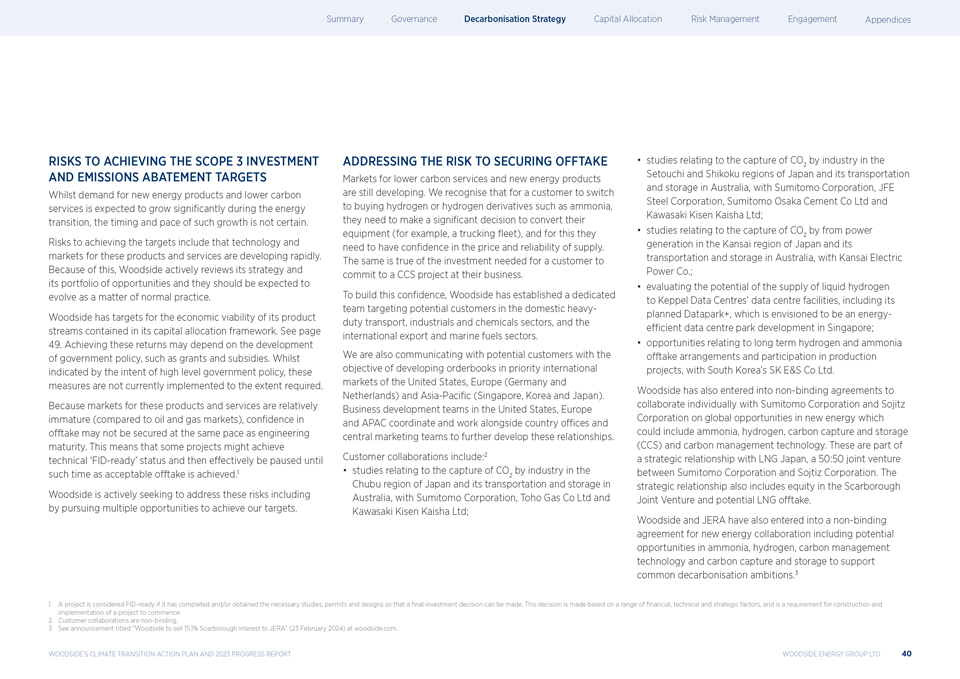 |
RISKS TO ACHIEVING THE SCOPE 3 INVESTMENT AND EMISSIONS ABATEMENT TARGETS Whilst demand for new energy products and lower carbon services is expected to grow signi?cantly during the energy transition, the timing and pace of such growth is not certain. Risks to achieving the targets include that technology and markets for these products and services are developing rapidly. Because of this, Woodside actively reviews its strategy and its portfolio of opportunities and they should be expected to evolve as a matter of normal practice. Woodside has targets for the economic viability of its product streams contained in its capital allocation framework. See page 49. Achieving these returns may depend on the development of government policy, such as grants and subsidies. Whilst indicated by the intent of high level government policy, these measures are not currently implemented to the extent required. Because markets for these products and services are relatively immature (compared to oil and gas markets), confidence in offtake may not be secured at the same pace as engineering maturity. This means that some projects might achieve technical ?FID-ready? status and then effectively be paused until such time as acceptable offtake is achieved.1 Woodside is actively seeking to address these risks including by pursuing multiple opportunities to achieve our targets. ADDRESSING THE RISK TO SECURING OFFTAKE Markets for lower carbon services and new energy products are still developing. We recognise that for a customer to switch to buying hydrogen or hydrogen derivatives such as ammonia, they need to make a signi?cant decision to convert their equipment (for example, a trucking ?eet), and for this they need to have con?dence in the price and reliability of supply. The same is true of the investment needed for a customer to commit to a CCS project at their business. To build this con?dence, Woodside has established a dedicated team targeting potential customers in the domestic heavy-duty transport, industrials and chemicals sectors, and the international export and marine fuels sectors. We are also communicating with potential customers with the objective of developing orderbooks in priority international markets of the United States, Europe (Germany and Netherlands) and Asia-Paci?c (Singapore, Korea and Japan). Business development teams in the United States, Europe and APAC coordinate and work alongside country offices and central marketing teams to further develop these relationships. Customer collaborations include:2 studies relating to the capture of CO by industry in the Chubu region of Japan and its transportation 2 and storage in Australia, with Sumitomo Corporation, Toho Gas Co Ltd and Kawasaki Kisen Kaisha Ltd; studies relating to the capture of CO by industry in the Setouchi and Shikoku regions of Japan 2 and its transportation and storage in Australia, with Sumitomo Corporation, JFE Steel Corporation, Sumitomo Osaka Cement Co Ltd and Kawasaki Kisen Kaisha Ltd; studies relating to the capture of CO by from power generation in the Kansai region of Japan 2 and its transportation and storage in Australia, with Kansai Electric Power Co.; evaluating the potential of the supply of liquid hydrogen to Keppel Data Centres? data centre facilities, including its planned Datapark+, which is envisioned to be an energy-efficient data centre park development in Singapore; opportunities relating to long term hydrogen and ammonia offtake arrangements and participation in production projects, with South Korea?s SK E&S Co Ltd. Woodside has also entered into non-binding agreements to collaborate individually with Sumitomo Corporation and Sojitz Corporation on global opportunities in new energy which could include ammonia, hydrogen, carbon capture and storage (CCS) and carbon management technology. These are part of a strategic relationship with LNG Japan, a 50:50 joint venture between Sumitomo Corporation and Sojtiz Corporation. The strategic relationship also includes equity in the Scarborough Joint Venture and potential LNG offtake. Woodside and JERA have also entered into a non-binding agreement for new energy collaboration including potential opportunities in ammonia, hydrogen, carbon management technology and carbon capture and storage to support common decarbonisation ambitions.3 1 A project is considered FID-ready if it has completed and/or obtained the necessary studies, permits and designs so that a ?nal investment decision can be made. This decision is made based on a range of ?nancial, technical and strategic factors, and is a requirement for construction and implementation of a project to commence. 2 Customer collaborations are non-binding. 3 See announcement titled ?Woodside to sell 15.1% Scarborough interest to JERA? (23 February 2024) at woodside.com. WOODSIDE?S CLIMATE TRANSITION ACTION PLAN AND 2023 PROGRESS REPORT WOODSIDE ENERGY GROUP LTD 40
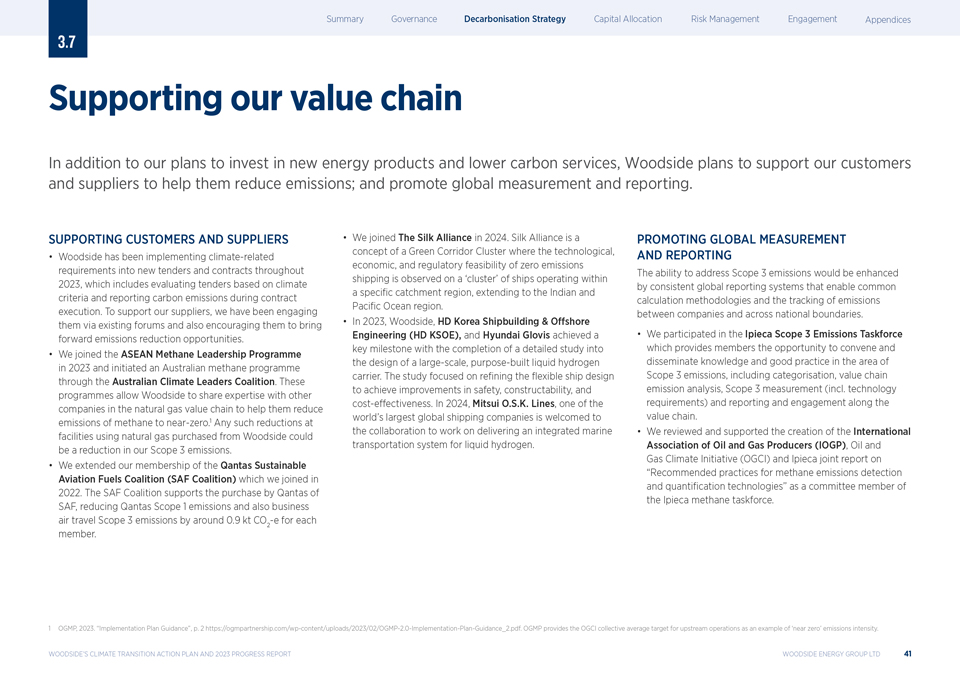 |
3.7 Supporting our value chain In addition to our plans to invest in new energy products and lower carbon services, Woodside plans to support our customers and suppliers to help them reduce emissions; and promote global measurement and reporting. SUPPORTING CUSTOMERS AND SUPPLIERS Woodside has been implementing climate-related requirements into new tenders and contracts throughout 2023, which includes evaluating tenders based on climate criteria and reporting carbon emissions during contract execution. To support our suppliers, we have been engaging them via existing forums and also encouraging them to bring forward emissions reduction opportunities. We joined the ASEAN Methane Leadership Programme in 2023 and initiated an Australian methane programme through the Australian Climate Leaders Coalition. These programmes allow Woodside to share expertise with other companies in the natural gas value chain to help them reduce emissions of methane to near-zero.1 Any such reductions at facilities using natural gas purchased from Woodside could be a reduction in our Scope 3 emissions. We extended our membership of the Qantas Sustainable Aviation Fuels Coalition (SAF Coalition) which we joined in 2022. The SAF Coalition supports the purchase by Qantas of SAF, reducing Qantas Scope 1 emissions and also business air travel Scope 3 emissions by around 0.9 kt CO -e for each member. 2 We joined The Silk Alliance in 2024. Silk Alliance is a concept of a Green Corridor Cluster where the technological, economic, and regulatory feasibility of zero emissions shipping is observed on a ?cluster? of ships operating within a specific catchment region, extending to the Indian and Pacific Ocean region. In 2023, Woodside, HD Korea Shipbuilding & Offshore Engineering (HD KSOE), and Hyundai Glovis achieved a key milestone with the completion of a detailed study into the design of a large-scale, purpose-built liquid hydrogen carrier. The study focused on re?ning the ?exible ship design to achieve improvements in safety, constructability, and cost-effectiveness.?In 2024, Mitsui O.S.K. Lines, one of the world?s largest global shipping companies is welcomed to the collaboration to work on delivering an integrated marine transportation system for liquid hydrogen. PROMOTING GLOBAL MEASUREMENT AND REPORTING The ability to address Scope 3 emissions would be enhanced by consistent global reporting systems that enable common calculation methodologies and the tracking of emissions between companies and across national boundaries. We participated in the Ipieca Scope 3 Emissions Taskforce which provides members the opportunity to convene and disseminate knowledge and good practice in the area of Scope 3 emissions, including categorisation, value chain emission analysis, Scope 3 measurement (incl. technology requirements) and reporting and engagement along the value chain. We reviewed and supported the creation of the International Association of Oil and Gas Producers (IOGP), Oil and Gas Climate Initiative (OGCI) and Ipieca joint report on ?Recommended practices for methane emissions detection and quantification technologies? as a committee member of the Ipieca methane taskforce. 1 OGMP, 2023. ?Implementation Plan Guidance?, p. 2 https://ogmpartnership.com/wp-content/uploads/2023/02/OGMP-2.0-Implementation-Plan-Guidance_2.pdf. OGMP provides the OGCI collective average target for upstream operations as an example of ?near zero? emissions intensity. WOODSIDE?S CLIMATE TRANSITION ACTION PLAN AND 2023 PROGRESS REPORT WOODSIDE ENERGY GROUP LTD 41
 |
4.0资本分配当用于发电 天然气通常产生煤炭排放量的一半。
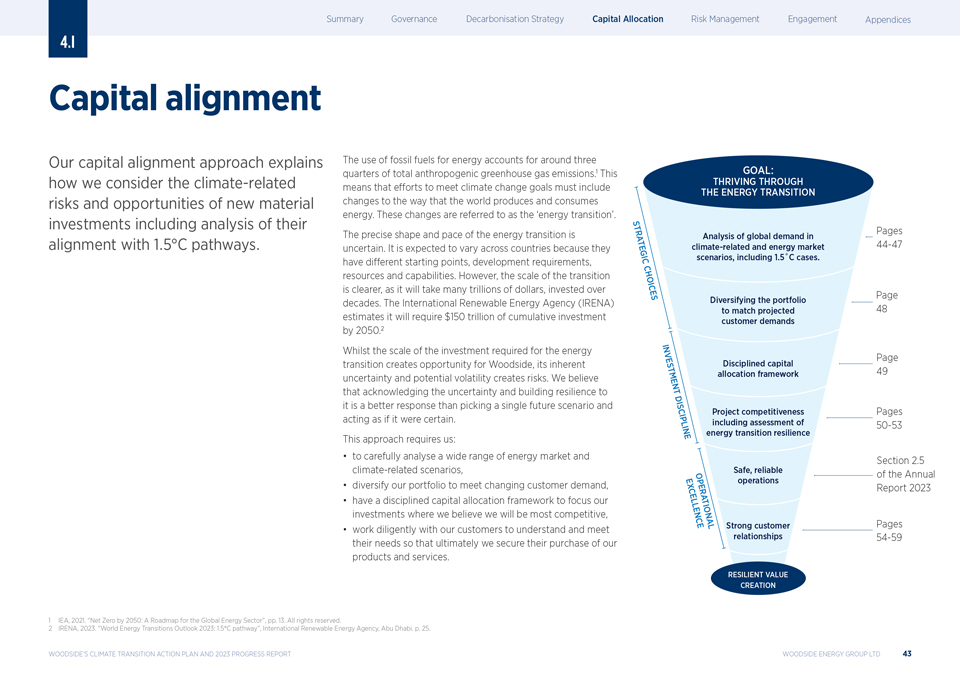 |
4.1资本调整我们的资本调整方法 解释了我们如何考虑新材料投资的气候相关风险和机遇,包括分析其与1.5C路径的一致性。化石燃料用于能源的使用约占人为 温室气体排放总量的四分之三。1这意味着实现气候变化目标的努力必须包括改变世界生产和消费能源的方式。这些变化被称为?能源转型?能量转换的确切形式和速度是不确定的。预计各国将有所不同,因为各国有不同的起点、发展要求、资源和能力。然而,过渡的规模更明确,因为它将需要数十年的投资数十亿美元。国际可再生能源机构(IRENA)估计,到2050年,它将需要150万亿美元的累计投资。2虽然能源转型所需的投资规模为Woodside创造了机会,但其固有的不确定性和潜在的波动性也会带来风险。我们认为,承认不确定性并建立对不确定性的适应能力,比选择一个单一的未来情景并采取行动, 是更好的应对措施。这一方针要求我们:仔细分析广泛的能源市场和气候相关方案,使我们的投资组合多样化以满足不断变化的客户需求,建立一个严格的资本分配框架,将我们的 投资集中在我们认为最具竞争力的地方,与客户通力合作以了解并满足他们的需求,从而最终确保他们购买我们的产品和服务。1国际能源机构,2021年。?到2050年实现净零: 全球能源部门的路线图?pp. 13. All rights reserved. 2 IRENA,2023年。?2023年世界能源转型展望:1.5C路径?国际可再生能源机构,阿布扎比。第25页。伍德赛德?气候变迁行动计划和2023年进展报告 Woodside Energy Group Ltd 43
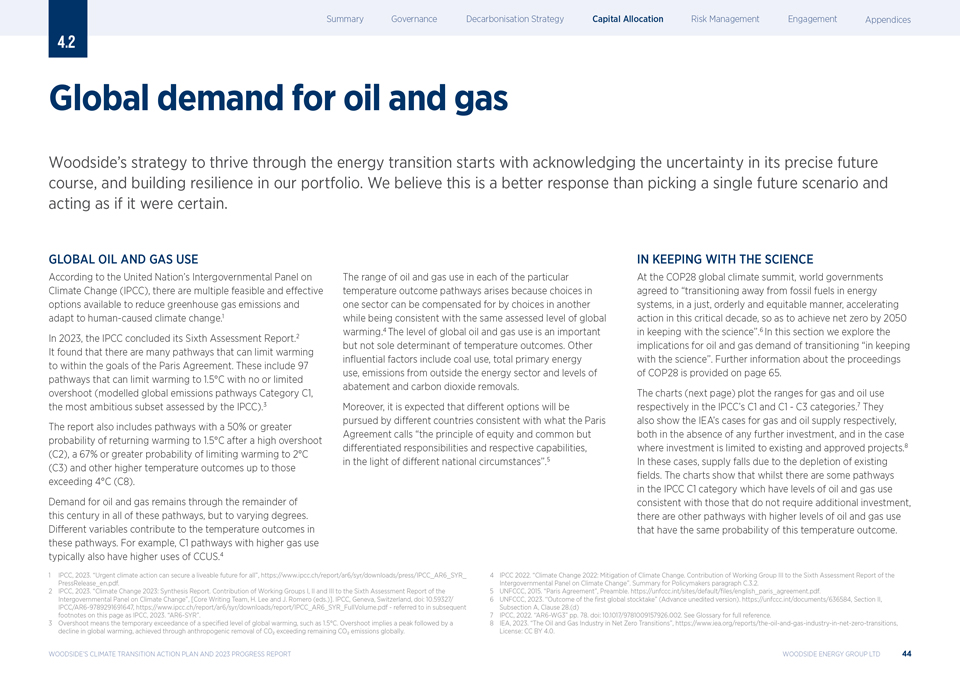 |
4.2全球对石油和天然气的需求伍德赛德?S 要想在能源转型中蓬勃发展,首先要认识到未来发展的不确定性,并在我们的投资组合中建立韧性。我们认为,这比选择一个单一的未来情景并表现得好像它是确定的 更好。全球石油和天然气使用根据联合国-S政府间气候变化专门委员会(政府间气候变化专门委员会),有多种可行和有效的选择来减少温室气体排放和适应人类造成的气候变化。1 2023年,政府间气候变化专门委员会结束了其第六次评估报告。2它发现,有许多途径可以将变暖限制在《巴黎协定》的目标范围内。这些路径包括97条可以在没有或 有限超调的情况下将变暖限制在1.5摄氏度的路径(建模的全球排放路径分类为C1,这是IPCC评估的最雄心勃勃的子集)。3报告还包括在高超调后将变暖返回1.5摄氏度的可能性为50%或更高的路径(C2)、将变暖限制在2摄氏度或更高的可能性(C3)或更高的路径,以及最高超过4摄氏度的其他更高温度结果(C8)。在本世纪余下的时间里,所有这些途径对石油和天然气的需求都将保持,但程度不同。不同的变量对这些途径的温度结果有影响。例如,天然气使用量较高的C1路径通常也有较高的CCU使用量。4每个特定温度结果路径的石油和天然气使用量范围之所以出现,是因为一个部门的选择可以通过在另一个部门的选择来补偿,同时与全球变暖的相同评估水平保持一致。4全球石油和天然气使用量是温度结果的一个重要但不是唯一的决定因素。其他不利因素包括煤炭使用量、一次能源总使用量、能源部门以外的排放量以及减排和二氧化碳清除量。此外,预计不同的国家将按照《巴黎协定》所称的公平和共同但有区别的责任和各自能力的原则,根据不同的国情,寻求不同的选择。5根据COP28全球气候首脑会议的科学,世界各国政府同意在能源系统中以公正、有序和公平的方式放弃化石燃料,在这个关键的十年加快行动,为了在2050年实现净零,以符合科学。6在本节中,我们将探讨转型对石油和天然气需求的影响。关于缔约方会议第二十八届会议议事程序的进一步信息见第65页。图表(下一页)分别列出了气专委S C1和C1C3类别中天然气和石油的使用范围。7图表还分别显示了在没有任何进一步投资的情况下以及在投资仅限于现有和批准的项目的情况下,国际能源署分别提供天然气和石油供应的情况。图表显示,虽然IPCC C1类别中有一些途径的石油和天然气使用量与那些不需要额外投资的途径一致,但还有一些石油和天然气使用量较高的途径出现这种温度结果的可能性相同。1政府间气候变化专门委员会,2023。?紧急气候行动可以确保所有人都有一个宜居的未来?, https://www.ipcc.ch/report/ar6/syr/downloads/press/IPCC_AR6_SYR_4 IPCC2022。《2022年气候变化:减缓气候变化》。第三工作组对新闻机构第六次评估报告的贡献政府间气候变化专门委员会?供决策者参考的摘要,第C.3.2段。2政府间气候变化专门委员会,2023。《2023年气候变化:综合报告》。第一、第二和第三工作组对2015年第五次《气候公约》第六次评估报告的贡献。?《巴黎协定》,Preamble. https://unfccc.int/sites/default/files/english_paris_agreement.pdf.政府间气候变化专门委员会?,[核心写作团队,H.Lee和J.Romero(编辑)]。气专委,日内瓦,瑞士,DOI:10.59327/6《气候公约》,2023年。?首次全球评估的结果 ?(未编辑的高级版本)。Https://unfccc.int/documents/636584,第二节,气专委/AR6-9789291691647,https://www.ipcc.ch/report/ar6/syr/downloads/report/IPCC_AR6_SYR_FullVolume.pdf—referred至随后的小节A,第28条。(D)本页脚注为气专委,2023年。?AR6-Syr?政府间气候变化专门委员会,2022年。?ar6-wg3?第78页。10.1017/9781009157926.002。有关完整参考,请参阅词汇表。3超调意味着暂时超过特定的全球变暖水平,如1.5摄氏度。 超调意味着一个峰值,随后是2023年的第8个IEA。?石油和天然气行业的净零过渡?,全球变暖的https://www.iea.org/reports/the-oil-and-gas-industry-in-net-zero-transitions,下降,通过人为清除CO?是否超过剩余CO?全球排放量。许可:CC至4.0。伍德赛德?S气候转型行动计划和2023年进展报告伍德赛德能源集团有限公司44
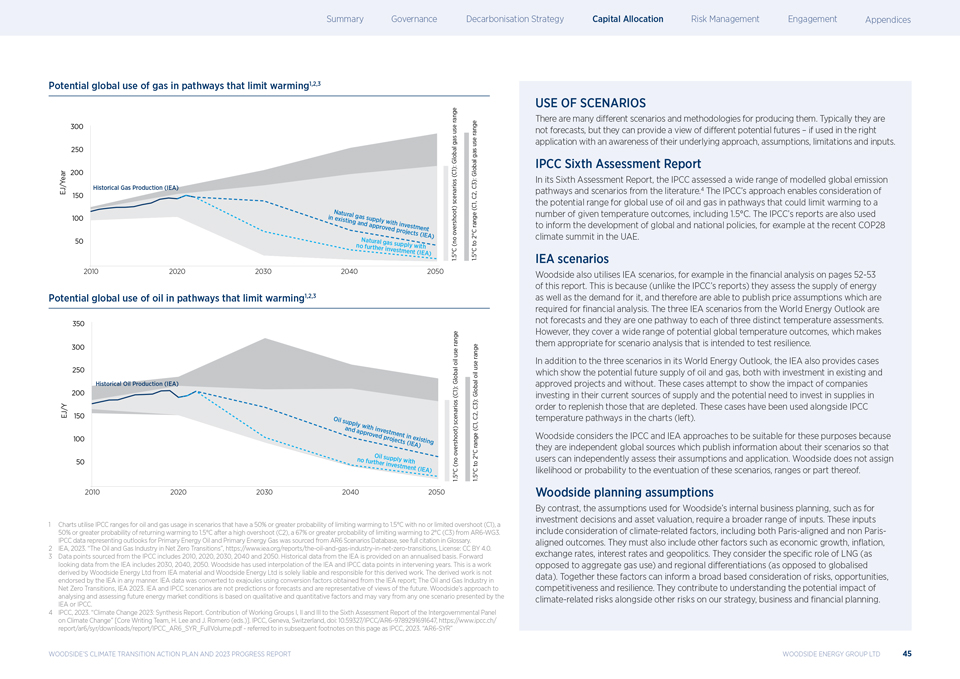 |
Potential global use of gas in pathways that limit warming1,2,3 Potential global use of oil in pathways that limit warming1,2,3 USE OF SCENARIOS There are many different scenarios and methodologies for producing them. Typically they are not forecasts, but they can provide a view of different potential futures ? if used in the right application with an awareness of their underlying approach, assumptions, limitations and inputs. IPCC Sixth Assessment Report In its Sixth Assessment Report, the IPCC assessed a wide range of modelled global emission pathways and scenarios from the literature.4 The IPCC?s approach enables consideration of the potential range for global use of oil and gas in pathways that could limit warming to a number of given temperature outcomes, including 1.5C. The IPCC?s reports are also used to inform the development of global and national policies, for example at the recent COP28 climate summit in the UAE. IEA scenarios Woodside also utilises IEA scenarios, for example in the financial analysis on pages 52-53 of this report. This is because (unlike the IPCC?s reports) they assess the supply of energy as well as the demand for it, and therefore are able to publish price assumptions which are required for financial analysis. The three IEA scenarios from the World Energy Outlook are not forecasts and they are one pathway to each of three distinct temperature assessments. However, they cover a wide range of potential global temperature outcomes, which makes them appropriate for scenario analysis that is intended to test resilience. In addition to the three scenarios in its World Energy Outlook, the IEA also provides cases which show the potential future supply of oil and gas, both with investment in existing and approved projects and without. These cases attempt to show the impact of companies investing in their current sources of supply and the potential need to invest in supplies in order to replenish those that are depleted. These cases have been used alongside IPCC temperature pathways in the charts (left). Woodside considers the IPCC and IEA approaches to be suitable for these purposes because they are independent global sources which publish information about their scenarios so that users can independently assess their assumptions and application. Woodside does not assign likelihood or probability to the eventuation of these scenarios, ranges or part thereof. Woodside planning assumptions By contrast, the assumptions used for Woodside?s internal business planning, such as for investment decisions and asset valuation, require a broader range of inputs. These inputs include consideration of climate-related factors, including both Paris-aligned and non Paris-aligned outcomes. They must also include other factors such as economic growth, inflation, exchange rates, interest rates and geopolitics. They consider the specific role of LNG (as opposed to aggregate gas use) and regional differentiations (as opposed to globalised data). Together these factors can inform a broad based consideration of risks, opportunities, competitiveness and resilience. They contribute to understanding the potential impact of climate-related risks alongside other risks on our strategy, business and financial planning. 1 Charts utilise IPCC ranges for oil and gas usage in scenarios that have a 50% or greater probability of limiting warming to 1.5C with no or limited overshoot (C1), a 50% or greater probability of returning warming to 1.5C after a high overshoot (C2), a 67% or greater probability of limiting warming to 2C (C3) from AR6-WG3. IPCC data representing outlooks for Primary Energy Oil and Primary Energy Gas was sourced from AR6 Scenarios Database, see full citation in Glossary. 2 IEA, 2023. ?The Oil and Gas Industry in Net Zero Transitions?, https://www.iea.org/reports/the-oil-and-gas-industry-in-net-zero-transitions, License: CC BY 4.0. 3 Data points sourced from the IPCC includes 2010, 2020, 2030, 2040 and 2050. Historical data from the IEA is provided on an annualised basis. Forward looking data from the IEA includes 2030, 2040, 2050. Woodside has used interpolation of the IEA and IPCC data points in intervening years. This is a work derived by Woodside Energy Ltd from IEA material and Woodside Energy Ltd is solely liable and responsible for this derived work. The derived work is not endorsed by the IEA in any manner. IEA data was converted to exajoules using conversion factors obtained from the IEA report; The Oil and Gas Industry in Net Zero Transitions, IEA 2023. IEA and IPCC scenarios are not predictions or forecasts and are representative of views of the future. Woodside?s approach to analysing and assessing future energy market conditions is based on qualitative and quantitative factors and may vary from any one scenario presented by the IEA or IPCC. 4 IPCC, 2023. ?Climate Change 2023: Synthesis Report. Contribution of Working Groups I, II and III to the Sixth Assessment Report of the Intergovernmental Panel on Climate Change? [核心写作团队,H。Lee and J. Romero(eds.)]. IPCC,Geneva,Switzerland,doi:10.59327/IPCC/AR6—9789291691647,https://www.ipcc.ch/ report/ar6/syr/downloads/report/IPCC_AR6_SYR_FullVol. pdf在本页后续脚注中被称为IPCC,2023。—?AR6—SYR?伍德赛德?2023年全球气候变迁行动计划与进展报告Woodside Energy Group Ltd 45
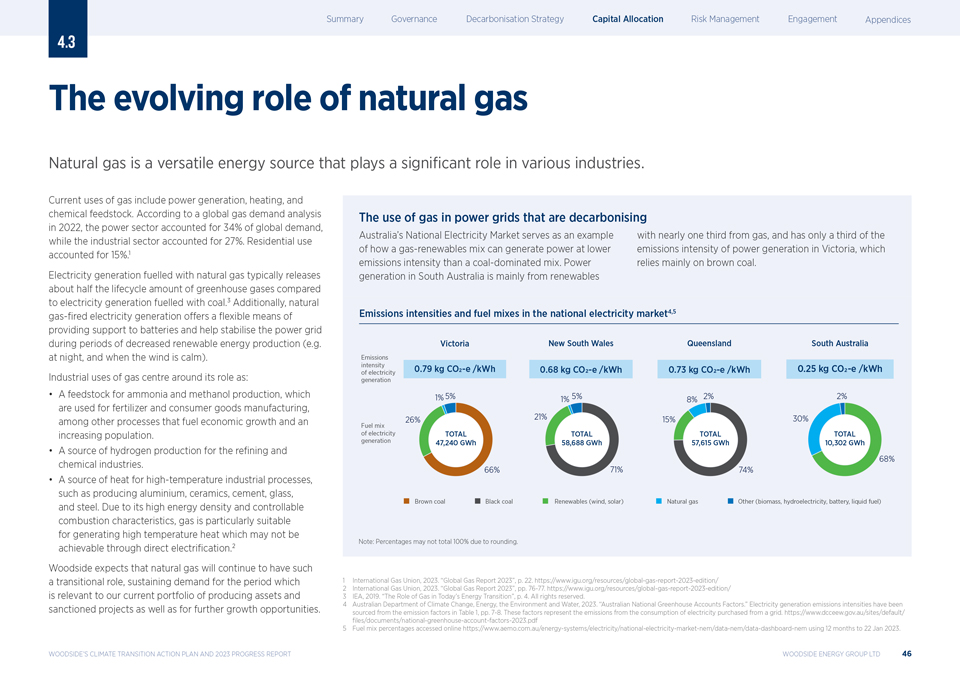 |
4.3 The evolving role of natural gas Natural gas is a versatile energy source that plays a signi?cant role in various industries. Current uses of gas include power generation, heating, and chemical feedstock. According to a global gas demand analysis in 2022, the power sector accounted for 34% of global demand, while the industrial sector accounted for 27%. Residential use accounted for 15%.1 Electricity generation fuelled with natural gas typically releases about half the lifecycle amount of greenhouse gases compared to electricity generation fuelled with coal.3 Additionally, natural gas-?red electricity generation offers a ?exible means of providing support to batteries and help stabilise the power grid during periods of decreased renewable energy production (e.g. at night, and when the wind is calm). Industrial uses of gas centre around its role as: A feedstock for ammonia and methanol production, which are used for fertilizer and consumer goods manufacturing, among other processes that fuel economic growth and an increasing population. A source of hydrogen production for the re?ning and chemical industries. A source of heat for high-temperature industrial processes, such as producing aluminium, ceramics, cement, glass, and steel. Due to its high energy density and controllable combustion characteristics, gas is particularly suitable for generating high temperature heat which may not be achievable through direct electri?cation.2 Woodside expects that natural gas will continue to have such a transitional role, sustaining demand for the period which is relevant to our current portfolio of producing assets and sanctioned projects as well as for further growth opportunities. The use of gas in power grids that are decarbonising Australia?s National Electricity Market serves as an example of how a gas-renewables mix can generate power at lower emissions intensity than a coal-dominated mix. Power generation in South Australia is mainly from renewables with nearly one third from gas, and has only a third of the emissions intensity of power generation in Victoria, which relies mainly on brown coal. Emissions intensities and fuel mixes in the national electricity market4,5 1 International Gas Union, 2023. ?Global Gas Report 2023?, p. 22. https://www.igu.org/resources/global-gas-report-2023-edition/ 2 International Gas Union, 2023. ?Global Gas Report 2023?, pp. 76-77. https://www.igu.org/resources/global-gas-report-2023-edition/ 3 IEA, 2019. ?The Role of Gas in Today?s Energy Transition?, p. 4. All rights reserved. 4 Australian Department of Climate Change, Energy, the Environment and Water, 2023. ?Australian National Greenhouse Accounts Factors.? Electricity generation emissions intensities have been sourced from the emission factors in Table 1, pp. 7-8. These factors represent the emissions from the consumption of electricity purchased from a grid. https://www.dcceew.gov.au/sites/default/ files/documents/national-greenhouse-account-factors-2023.pdf 5 Fuel mix percentages accessed online https://www.aemo.com.au/energy-systems/electricity/national-electricity-market-nem/data-nem/data-dashboard-nem using 12 months to 22 Jan 2023. WOODSIDE ENERGY GROUP LTD 46 WOODSIDE?S CLIMATE TRANSITION ACTION PLAN AND 2023 PROGRESS REPORT
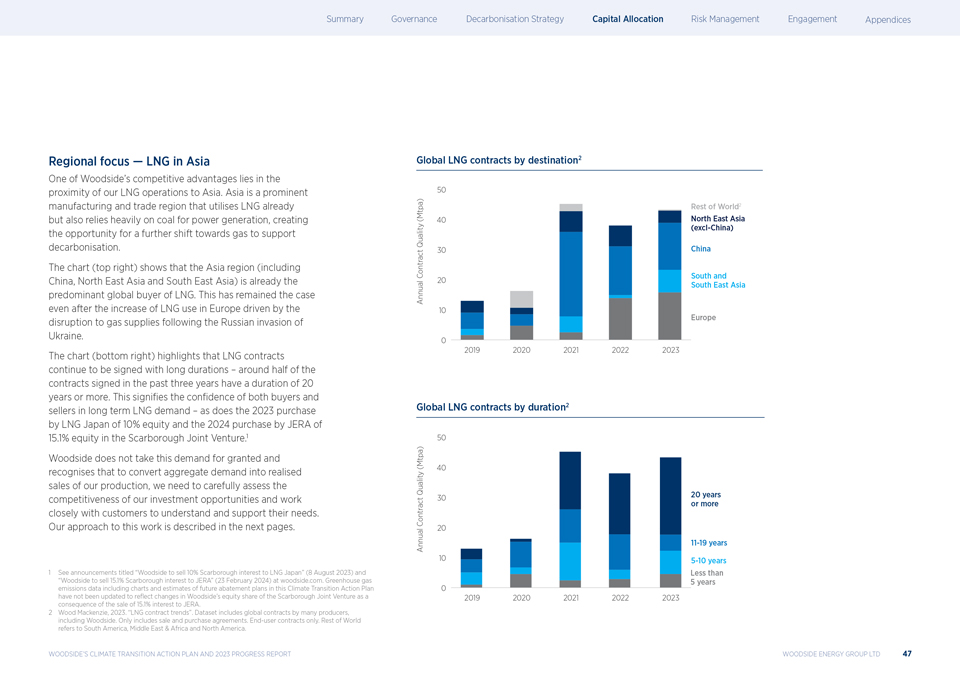 |
区域重点?液化天然气在伍德赛德亚洲一号? 我们的竞争优势在于我们的液化天然气业务靠近亚洲。亚洲是一个突出的制造业和贸易地区,已经使用液化天然气,但也严重依赖煤炭发电,为进一步转向天然气以支持脱碳创造了机会。图表(右上)显示,亚洲地区(包括中国、东北亚和东南亚)已经是全球液化天然气的主要买家。即使在俄罗斯入侵乌克兰后天然气供应中断导致欧洲液化天然气使用量增加之后,情况依然如此。图表(右下角)强调了LNG合同继续签署的期限很长?过去三年签订的合同中,约有一半的合同期限为20年或以上。这意味着买方和卖方对LNG长期需求的信心?LNG Japan于2023年收购10%股权以及JERA于2024年收购Scarborough合资企业15.1%股权。1 Woodside并不认为这一需求是理所当然的,并认识到,为了将总需求转化为我们生产的已实现销售额,我们需要仔细评估投资机会的竞争力,并 与客户密切合作,了解并支持他们的需求。我们对这项工作的方法将在下面几页中描述。按目的地分列的全球液化天然气合同2按期限分列的全球液化天然气合同2 1见标题为?伍德赛德将出售10% 斯卡伯勒股权给液化天然气日本?(2023年8月8日)和?伍德赛德将15.1%的斯卡伯勒股权出售给JERA?(23 2024年2月)在woodside.com。温室气体排放数据,包括本气候变化 过渡行动计划中未来减排计划的图表和估计数,尚未更新以反映伍德赛德的变化?由于出售15.1%权益予JERA,其于士嘉堡合资企业的股权份额。[2] Wood Mackenzie,2023年。?液化天然气合同的发展趋势?数据集包括 许多生产商的全球合同,包括Woodside。只包括买卖协议。仅限最终用户合同。世界其他地区是指南美洲、中东和非洲以及北美洲。伍德赛德?气候变迁行动 2023年进展报告Woodside Energy Group Ltd 47
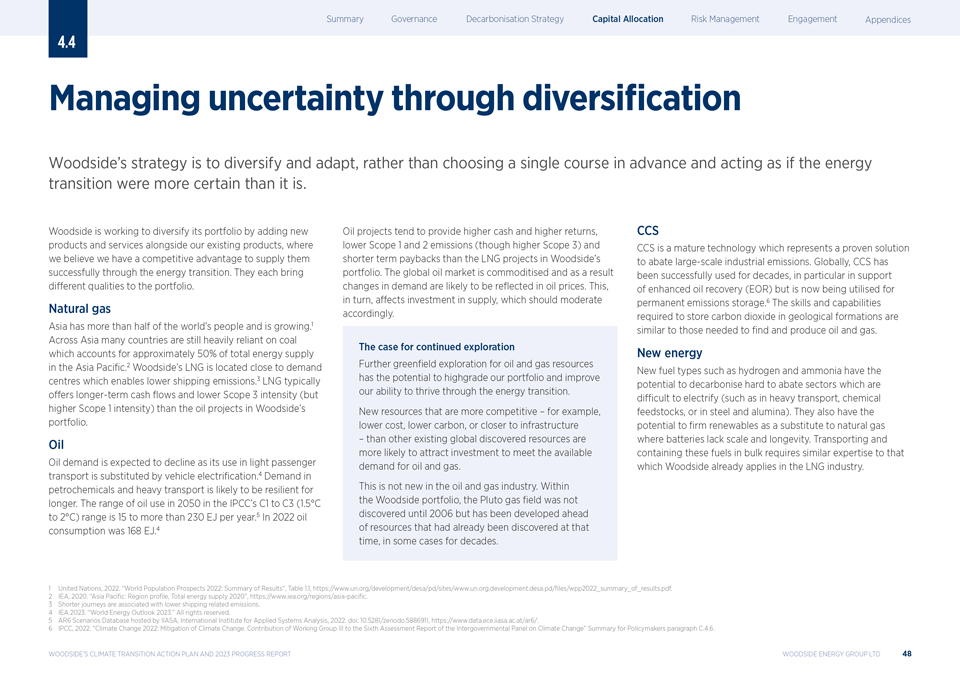 |
4.4 Managing uncertainty through diversi?cation Woodside?s strategy is to diversify and adapt, rather than choosing a single course in advance and acting as if the energy transition were more certain than it is. Woodside is working to diversify its portfolio by adding new products and services alongside our existing products, where we believe we have a competitive advantage to supply them successfully through the energy transition. They each bring different qualities to the portfolio. Natural gas Asia has more than half of the world?s people and is growing.1 Across Asia many countries are still heavily reliant on coal which accounts for approximately 50% of total energy supply in the Asia Paci?c.2 Woodside?s LNG is located close to demand centres which enables lower shipping emissions.3 LNG typically offers longer-term cash flows and lower Scope 3 intensity (but higher Scope 1 intensity) than the oil projects in Woodside?s portfolio. Oil Oil demand is expected to decline as its use in light passenger transport is substituted by vehicle electri?cation.4 Demand in petrochemicals and heavy transport is likely to be resilient for longer. The range of oil use in 2050 in the IPCC?s C1 to C3 (1.5C to 2C) range is 15 to more than 230 EJ per year.5 In 2022 oil consumption was 168 EJ.4 Oil projects tend to provide higher cash and higher returns, lower Scope 1 and 2 emissions (though higher Scope 3) and shorter term paybacks than the LNG projects in Woodside?s portfolio. The global oil market is commoditised and as a result changes in demand are likely to be reflected in oil prices. This, in turn, affects investment in supply, which should moderate accordingly. The case for continued exploration Further green?eld exploration for oil and gas resources has the potential to highgrade our portfolio and improve our ability to thrive through the energy transition. New resources that are more competitive ? for example, lower cost, lower carbon, or closer to infrastructure ? than other existing global discovered resources are more likely to attract investment to meet the available demand for oil and gas. This is not new in the oil and gas industry. Within the Woodside portfolio, the Pluto gas ?eld was not discovered until 2006 but has been developed ahead of resources that had already been discovered at that time, in some cases for decades. CCS CCS is a mature technology which represents a proven solution to abate large-scale industrial emissions. Globally, CCS has been successfully used for decades, in particular in support of enhanced oil recovery (EOR) but is now being utilised for permanent emissions storage.6 The skills and capabilities required to store carbon dioxide in geological formations are similar to those needed to ?nd and produce oil and gas. New energy New fuel types such as hydrogen and ammonia have the potential to decarbonise hard to abate sectors which are difficult to electrify (such as in heavy transport, chemical feedstocks, or in steel and alumina). They also have the potential to ?rm renewables as a substitute to natural gas where batteries lack scale and longevity. Transporting and containing these fuels in bulk requires similar expertise to that which Woodside already applies in the LNG industry. 1 United Nations, 2022. ?World Population Prospects 2022: Summary of Results?, Table 1.1, https://www.un.org/development/desa/pd/sites/www.un.org.development.desa.pd/files/wpp2022_summary_of_results.pdf. 2 IEA, 2020. ?Asia Pacific: Region profile, Total energy supply 2020?, https://www.iea.org/regions/asia-pacific. 3 Shorter journeys are associated with lower shipping related emissions. 4 IEA 2023. ?World Energy Outlook 2023.? All rights reserved. 5 AR6 Scenarios Database hosted by IIASA, International Institute for Applied Systems Analysis, 2022. doi: 10.5281/zenodo.5886911, https://www.data.ece.iiasa.ac.at/ar6/. 6 IPCC, 2022. ?Climate Change 2022: Mitigation of Climate Change. Contribution of Working Group III to the Sixth Assessment Report of the Intergovernmental Panel on Climate Change? Summary for Policymakers paragraph C.4.6. WOODSIDE?S CLIMATE TRANSITION ACTION PLAN AND 2023 PROGRESS REPORT WOODSIDE ENERGY GROUP LTD 48
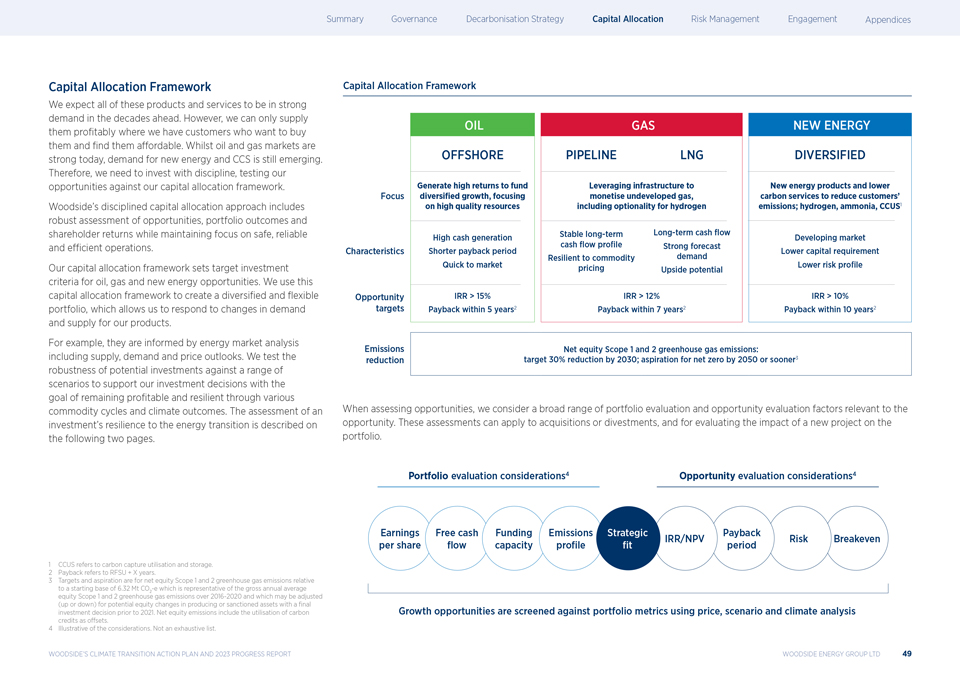 |
Capital Allocation Framework We expect all of these products and services to be in strong demand in the decades ahead. However, we can only supply them pro?tably where we have customers who want to buy them and ?nd them affordable. Whilst oil and gas markets are strong today, demand for new energy and CCS is still emerging. Therefore, we need to invest with discipline, testing our opportunities against our capital allocation framework. Woodside?s disciplined capital allocation approach includes robust assessment of opportunities, portfolio outcomes and shareholder returns while maintaining focus on safe, reliable and efficient operations. Our capital allocation framework sets target investment criteria for oil, gas and new energy opportunities. We use this capital allocation framework to create a diversi?ed and ?exible portfolio, which allows us to respond to changes in demand and supply for our products. For example, they are informed by energy market analysis including supply, demand and price outlooks. We test the robustness of potential investments against a range of scenarios to support our investment decisions with the goal of remaining profitable and resilient through various commodity cycles and climate outcomes. The assessment of an investment?s resilience to the energy transition is described on the following two pages. Capital Allocation Framework OIL GAS NEW ENERGY OFFSHORE PIPELINE LNG DIVERSIFIED Generate high returns to fund Leveraging infrastructure to New energy products and lower Focus diversi?ed growth, focusing monetise undeveloped gas, carbon services to reduce customers? on high quality resources including optionality for hydrogen emissions; hydrogen, ammonia, CCUS1 Stable long-term Long-term cash ?ow High cash generation Developing market cash ?ow pro?le Strong forecast Characteristics Shorter payback period Lower capital requirement Quick to market Resilient to commodity demand Lower risk pro?le pricing Upside potential Opportunity IRR > 15% IRR > 12% IRR > 10% targets Payback within 5 years2 Payback within 7 years2 Payback within 10 years2 Emissions Net equity Scope 1 and 2 greenhouse gas emissions: reduction target 30% reduction by 2030; aspiration for net zero by 2050 or sooner3 When assessing opportunities, we consider a broad range of portfolio evaluation and opportunity evaluation factors relevant to the opportunity. These assessments can apply to acquisitions or divestments, and for evaluating the impact of a new project on the portfolio. Portfolio evaluation considerations4 Opportunity evaluation considerations4 Earnings Free cash Funding Emissions Strategic Payback IRR/NPV Risk Breakeven per share ?ow capacity pro?le ?t period Growth opportunities are screened against portfolio metrics using price, scenario and climate analysis 1 CCUS refers to carbon capture utilisation and storage. 2 Payback refers to RFSU + X years. 3 Targets and aspiration are for net equity Scope 1 and 2 greenhouse gas emissions relative to a starting base of 6.32 Mt CO -e which is representative of the gross annual average 2 equity Scope 1 and 2 greenhouse gas emissions over 2016-2020 and which may be adjusted (up or down) for potential equity changes in producing or sanctioned assets with a ?nal investment decision prior to 2021. Net equity emissions include the utilisation of carbon credits as offsets. 4 Illustrative of the considerations. Not an exhaustive list. WOODSIDE?S CLIMATE TRANSITION ACTION PLAN AND 2023 PROGRESS REPORT WOODSIDE ENERGY GROUP LTD
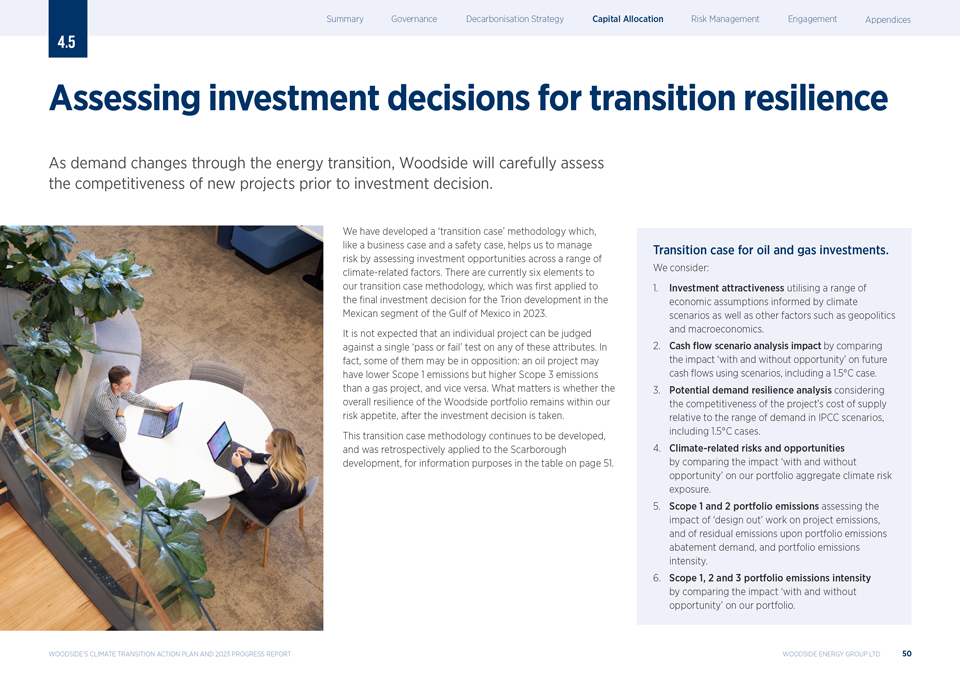 |
4.5评估投资决策的转型适应性 随着能源转型的需求发生变化,Woodside将在做出投资决策之前仔细评估新项目的竞争力。我们开发了一个?过渡案件?方法论,就像商业案例和安全案例,帮助我们通过评估一系列气候相关因素的投资机会来管理风险。目前,我们的过渡案例方法有六个要素,这些要素首次应用于2023年墨西哥湾墨西哥段Trion开发项目的最终投资决策。我们不希望一个单独的项目可以根据一个单独的项目来判断?通过还是失败?测试这些属性。事实上,他们中的一些人可能持反对意见:石油 项目的范围1排放量可能比天然气项目低,但范围3排放量更高,反之亦然。重要的是,在作出投资决定后,伍德赛德投资组合的整体弹性是否仍在我们的风险承受能力之内。此过渡个案方法将继续发展,并追溯应用于士嘉堡发展项目,供参考之用,详情载于第51页表格。石油和天然气投资的过渡案例。我们认为:1。 投资吸引力利用一系列经济假设,并根据气候情景以及地缘政治和宏观经济等其他因素进行分析。2.现金?通过比较影响来分析情景影响?有没有 机会?未来的现金?使用场景,包括1.5C的情况。3.考虑到项目竞争力的潜在需求弹性分析?在气专委设想方案中,包括1.5C情况下,相对于需求范围的供应成本。 4.通过比较影响来分析与气候有关的风险和机遇?有没有机会我们的投资组合总气候风险暴露。5.范围1和2组合排放评估影响?设计出?项目排放量、 和剩余排放量对组合排放量减少需求和组合排放强度的影响。6.范围1、2和3的组合排放强度通过比较的影响?有没有机会在我们的投资组合上。伍德赛德?S气候 过渡行动计划和2023年进展报告伍德赛德能源集团有限公司50
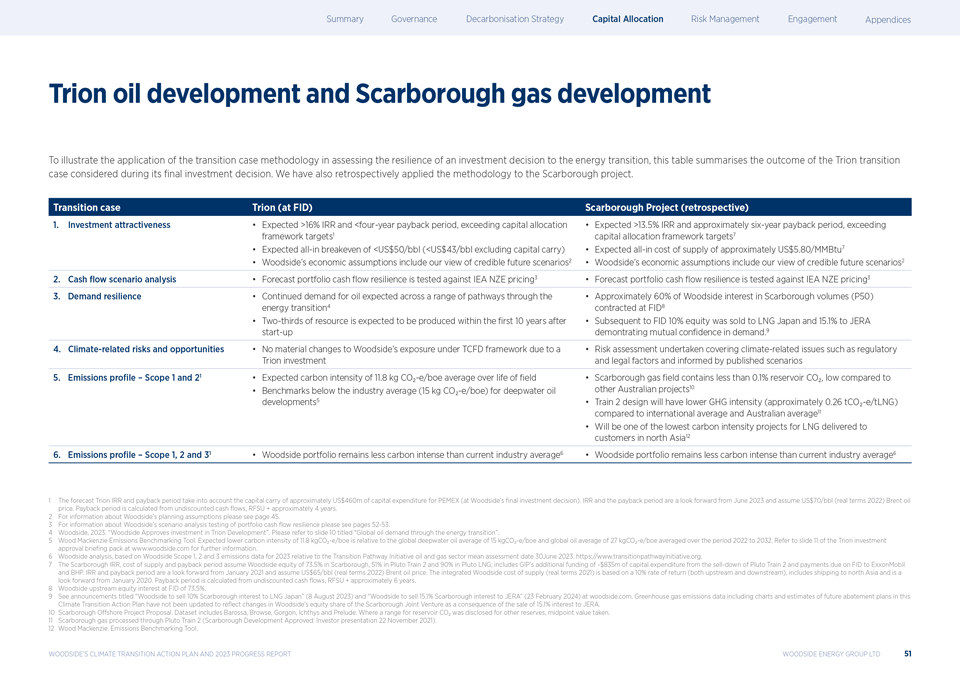 |
Trion石油开发和Scarborough天然气
开发为了说明过渡案例方法在评估投资决策对能源转型的适应性方面的应用,本表总结了在其?最终
投资决策我们亦已将该方法追溯应用于Scarborough项目。过渡案例Trion(在FID)Scarborough Project(回顾性)1.投资吸引力预期> 16%的IRR,
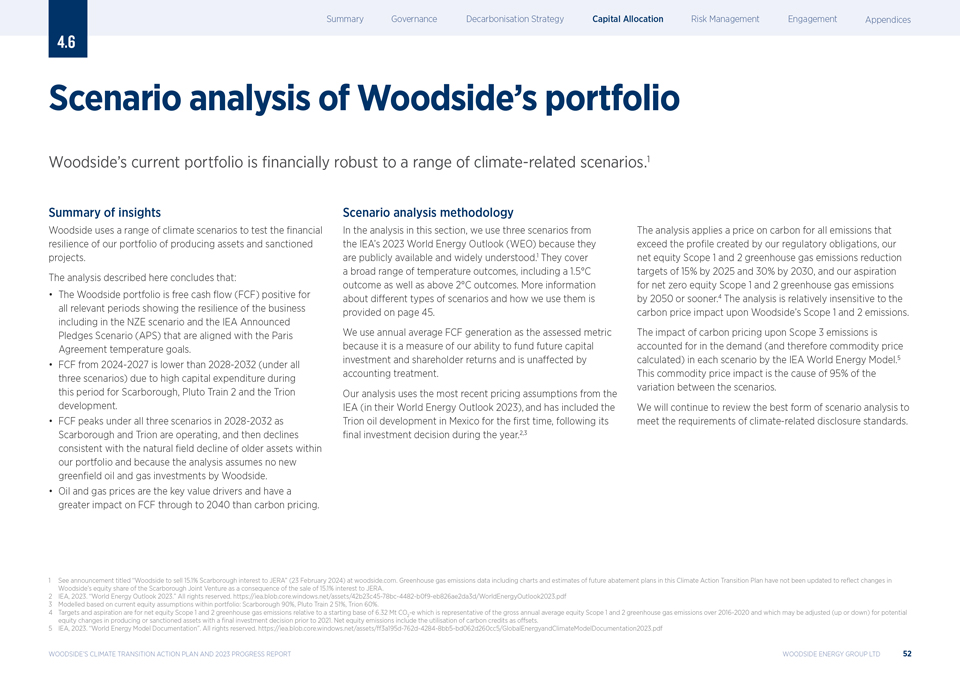 |
4.6 Scenario analysis of Woodside?s portfolio Woodside?s current portfolio is financially robust to a range of climate-related scenarios.1 Summary of insights Woodside uses a range of climate scenarios to test the ?nancial resilience of our portfolio of producing assets and sanctioned projects. The analysis described here concludes that: The Woodside portfolio is free cash ?ow (FCF) positive for all relevant periods showing the resilience of the business including in the NZE scenario and the IEA Announced Pledges Scenario (APS) that are aligned with the Paris Agreement temperature goals. FCF from 2024-2027 is lower than 2028-2032 (under all three scenarios) due to high capital expenditure during this period for Scarborough, Pluto Train 2 and the Trion development. FCF peaks under all three scenarios in 2028-2032 as Scarborough and Trion are operating, and then declines consistent with the natural ?eld decline of older assets within our portfolio and because the analysis assumes no new green?eld oil and gas investments by Woodside. Oil and gas prices are the key value drivers and have a greater impact on FCF through to 2040 than carbon pricing. Scenario analysis methodology In the analysis in this section, we use three scenarios from the IEA?s 2023 World Energy Outlook (WEO) because they are publicly available and widely understood.1 They cover a broad range of temperature outcomes, including a 1.5C outcome as well as above 2C outcomes. More information about different types of scenarios and how we use them is provided on page 45. We use annual average FCF generation as the assessed metric because it is a measure of our ability to fund future capital investment and shareholder returns and is unaffected by accounting treatment. Our analysis uses the most recent pricing assumptions from the IEA (in their World Energy Outlook 2023), and has included the Trion oil development in Mexico for the ?rst time, following its ?nal investment decision during the year.2,3 The analysis applies a price on carbon for all emissions that exceed the pro?le created by our regulatory obligations, our net equity Scope 1 and 2 greenhouse gas emissions reduction targets of 15% by 2025 and 30% by 2030, and our aspiration for net zero equity Scope 1 and 2 greenhouse gas emissions by 2050 or sooner.4 The analysis is relatively insensitive to the carbon price impact upon Woodside?s Scope 1 and 2 emissions. The impact of carbon pricing upon Scope 3 emissions is accounted for in the demand (and therefore commodity price calculated) in each scenario by the IEA World Energy Model.5 This commodity price impact is the cause of 95% of the variation between the scenarios. We will continue to review the best form of scenario analysis to meet the requirements of climate-related disclosure standards. 1 See announcement titled ?Woodside to sell 15.1% Scarborough interest to JERA? (23 February 2024) at woodside.com. Greenhouse gas emissions data including charts and estimates of future abatement plans in this Climate Action Transition Plan have not been updated to reflect changes in Woodside?s equity share of the Scarborough Joint Venture as a consequence of the sale of 15.1% interest to JERA. 2 IEA, 2023. ?World Energy Outlook 2023.? All rights reserved. https://iea.blob.core.windows.net/assets/42b23c45-78bc-4482-b0f9-eb826ae2da3d/WorldEnergyOutlook2023.pdf 3 Modelled based on current equity assumptions within portfolio: Scarborough 90%, Pluto Train 2 51%, Trion 60%. 4 Targets and aspiration are for net equity Scope 1 and 2 greenhouse gas emissions relative to a starting base of 6.32 Mt CO -e which is representative of the gross annual average equity Scope 1 and 2 greenhouse gas emissions over 2016-2020 and which may be adjusted (up or down) for potential 2 equity changes in producing or sanctioned assets with a ?nal investment decision prior to 2021. Net equity emissions include the utilisation of carbon credits as offsets. 5 IEA, 2023. ?World Energy Model Documentation?. All rights reserved. https://iea.blob.core.windows.net/assets/ff3a195d-762d-4284-8bb5-bd062d260cc5/GlobalEnergyandClimateModelDocumentation2023.pdf WOODSIDE?S CLIMATE TRANSITION ACTION PLAN AND 2023 PROGRESS REPORT WOODSIDE ENERGY GROUP LTD 52
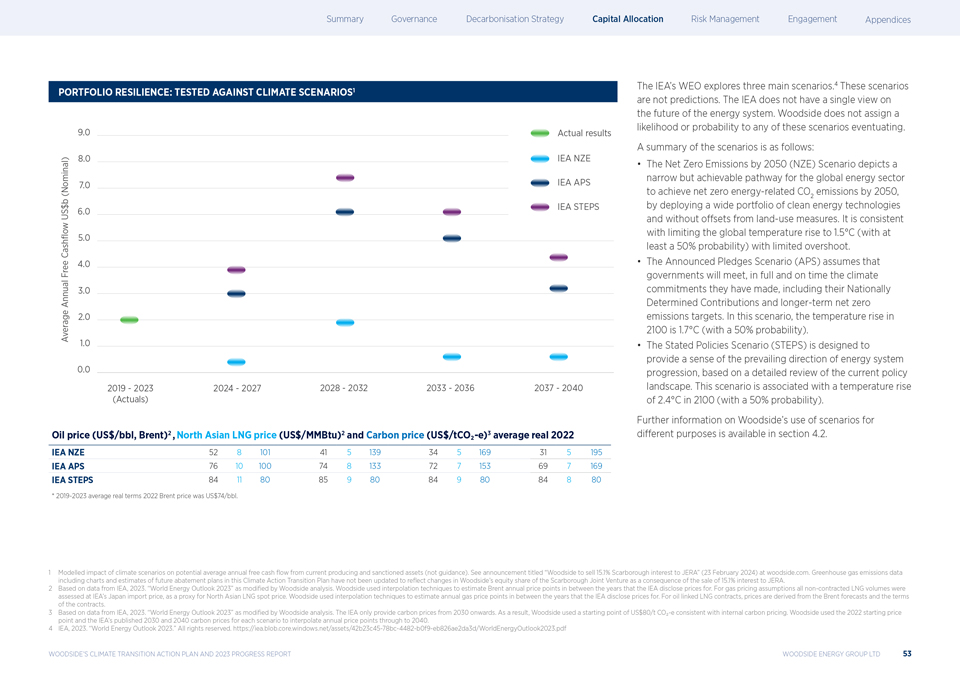 |
投资组合弹性:针对气候进行了测试 SCENARIOS1油价(美元/桶,布伦特)2,北亚液化天然气价格(美元/MMBtu)2和碳价格(美元/TCO?-e)3 2022年国际能源署NZE 52 8 101 41 5 139 34 5 169 31 5 195国际能源署APS 76 10 100 74 8 133 72 7 153 69 7 169国际能源署第84 11 80 85 9 84 9 80 84 8 80*2019-2023年平均实际2022年布伦特原油价格为74美元/桶。《国际能源署-S经济展望》探讨了三种主要情景。4这些情景不是预测。国际能源署对能源系统的未来并没有单一的看法。伍德赛德不会为这些情况中的任何一种指定最终发生的可能性或概率。情景总结如下:到2050年净零排放(NZE)情景描绘了一条狭窄但可实现的道路,全球能源部门通过部署广泛的清洁能源技术组合,在不抵消土地利用措施的情况下,到2050年实现与能源相关的净零排放。这与将全球气温上升限制在1.5摄氏度以内(至少有50%的可能性) 并限制超调是一致的。已宣布的承诺情景(APS)假定各国政府将按时足额兑现其作出的气候承诺,包括国家自主贡献和较长期的净零排放目标 。在这种情况下,2100年的温度上升是1.7摄氏度(有50%的可能性)。所述政策情景(步骤)旨在根据对当前政策格局的详细审查,提供对能源系统发展的主流方向的认识。这种情况与2100年气温上升2.4摄氏度有关(概率为50%)。有关伍德赛德?S为不同目的使用场景的更多信息,请参见第4.2节。1模拟了气候情景对当前生产和受制裁资产的潜在平均年自由现金流的影响(不是指导)。参见Woodside将15.1%的Scarborough权益出售给jera?(2024年2月23日)的公告。温室气体排放数据,包括本气候行动过渡计划中对未来减排计划的图表和估计,尚未更新,以反映由于向JERA出售 15.1%权益而导致的伍德赛德?S在斯卡伯勒合资企业中的股权份额的变化。2基于2023年国际能源署的数据。?《2023年世界能源展望》通过伍德赛德分析进行了修正。伍德赛德使用插值法估计了国际能源署披露价格的年份之间布伦特原油的年度价格点。对于天然气定价假设,所有非合同液化天然气产量都以国际能源署S日本进口价格进行评估,作为北亚液化天然气现货价格的替代。伍德赛德使用插值法估计了国际能源署披露价格的年份之间的年度天然气价格点。对于与石油挂钩的液化天然气合约,价格是根据布伦特原油的预测和合约条款得出的。3基于2023年国际能源署的数据。?《2023年世界能源展望》通过伍德赛德分析进行了修正。国际能源署只提供从2030年起的碳价格。因此,伍德赛德使用了与内部碳定价一致的80美元/吨CO?-E的起始价。伍德赛德使用2022年的起始价,国际能源署S发布了每个情景的2030年和2040年的碳价格 插入到2040年的年度价格点。国际能源署,2023年。?《2023年世界能源展望》。版权所有。Https://iea.blob.core.windows.net/assets/42b23c45-78bc-4482-b0f9-eb826ae2da3d/WorldEnergyOutlook2023.pdf伍德赛德?S气候转型行动计划和2023年进展报告伍德赛德能源集团有限公司53
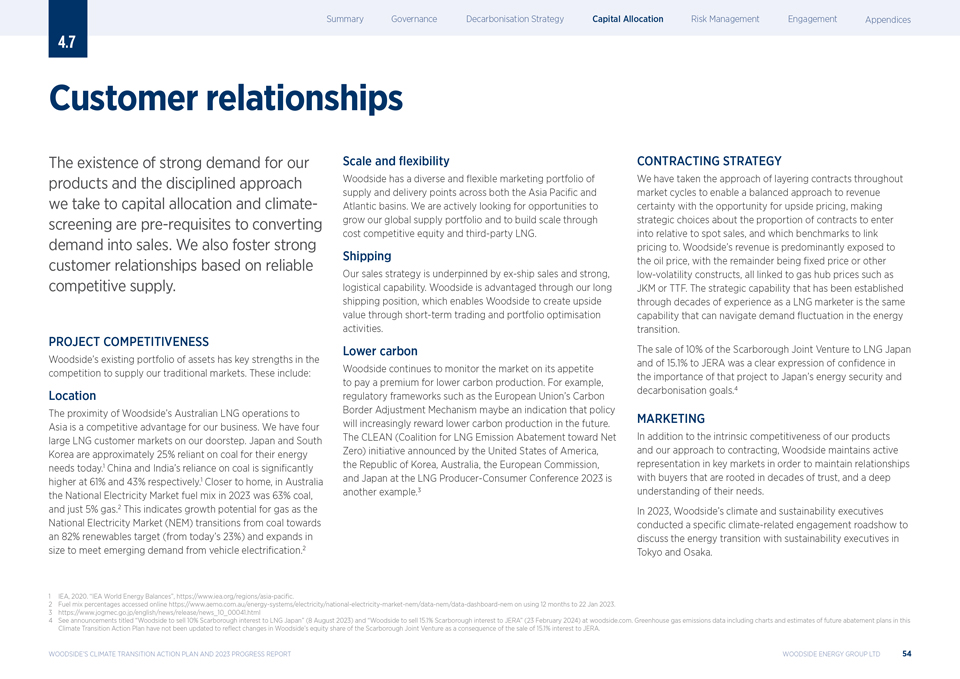 |
4.7 Customer relationships The existence of strong demand for our products and the disciplined approach we take to capital allocation and climate-screening are pre-requisites to converting demand into sales. We also foster strong customer relationships based on reliable competitive supply. PROJECT COMPETITIVENESS Woodside?s existing portfolio of assets has key strengths in the competition to supply our traditional markets. These include: Location The proximity of Woodside?s Australian LNG operations to Asia is a competitive advantage for our business. We have four large LNG customer markets on our doorstep. Japan and South Korea are approximately 25% reliant on coal for their energy needs today.1 China and India?s reliance on coal is significantly higher at 61% and 43% respectively.1 Closer to home, in Australia the National Electricity Market fuel mix in 2023 was 63% coal, and just 5% gas.2 This indicates growth potential for gas as the National Electricity Market (NEM) transitions from coal towards an 82% renewables target (from today?s 23%) and expands in size to meet emerging demand from vehicle electrification.2 Scale and ?exibility Woodside has a diverse and ?exible marketing portfolio of supply and delivery points across both the Asia Paci?c and Atlantic basins. We are actively looking for opportunities to grow our global supply portfolio and to build scale through cost competitive equity and third-party LNG. Shipping Our sales strategy is underpinned by ex-ship sales and strong, logistical capability. Woodside is advantaged through our long shipping position, which enables Woodside to create upside value through short-term trading and portfolio optimisation activities. Lower carbon Woodside continues to monitor the market on its appetite to pay a premium for lower carbon production. For example, regulatory frameworks such as the European Union?s Carbon Border Adjustment Mechanism maybe an indication that policy will increasingly reward lower carbon production in the future. The CLEAN (Coalition for LNG Emission Abatement toward Net Zero) initiative announced by the United States of America, the Republic of Korea, Australia, the European Commission, and Japan at the LNG Producer-Consumer Conference 2023 is another example.3 CONTRACTING STRATEGY We have taken the approach of layering contracts throughout market cycles to enable a balanced approach to revenue certainty with the opportunity for upside pricing, making strategic choices about the proportion of contracts to enter into relative to spot sales, and which benchmarks to link pricing to. Woodside?s revenue is predominantly exposed to the oil price, with the remainder being fixed price or other low-volatility constructs, all linked to gas hub prices such as JKM or TTF. The strategic capability that has been established through decades of experience as a LNG marketer is the same capability that can navigate demand fluctuation in the energy transition. The sale of 10% of the Scarborough Joint Venture to LNG Japan and of 15.1% to JERA was a clear expression of confidence in the importance of that project to Japan?s energy security and decarbonisation goals.4 MARKETING In addition to the intrinsic competitiveness of our products and our approach to contracting, Woodside maintains active representation in key markets in order to maintain relationships with buyers that are rooted in decades of trust, and a deep understanding of their needs. In 2023, Woodside?s climate and sustainability executives conducted a specific climate-related engagement roadshow to discuss the energy transition with sustainability executives in Tokyo and Osaka. 1 IEA, 2020. ?IEA World Energy Balances?, https://www.iea.org/regions/asia-pacific. 2 Fuel mix percentages accessed online https://www.aemo.com.au/energy-systems/electricity/national-electricity-market-nem/data-nem/data-dashboard-nem on using 12 months to 22 Jan 2023. 3 https://www.jogmec.go.jp/english/news/release/news_10_00041.html 4 See announcements titled ?Woodside to sell 10% Scarborough interest to LNG Japan? (8 August 2023) and ?Woodside to sell 15.1% Scarborough interest to JERA? (23 February 2024) at woodside.com. Greenhouse gas emissions data including charts and estimates of future abatement plans in this Climate Transition Action Plan have not been updated to reflect changes in Woodside?s equity share of the Scarborough Joint Venture as a consequence of the sale of 15.1% interest to JERA. WOODSIDE?S CLIMATE TRANSITION ACTION PLAN AND 2023 PROGRESS REPORT WOODSIDE ENERGY GROUP LTD 54
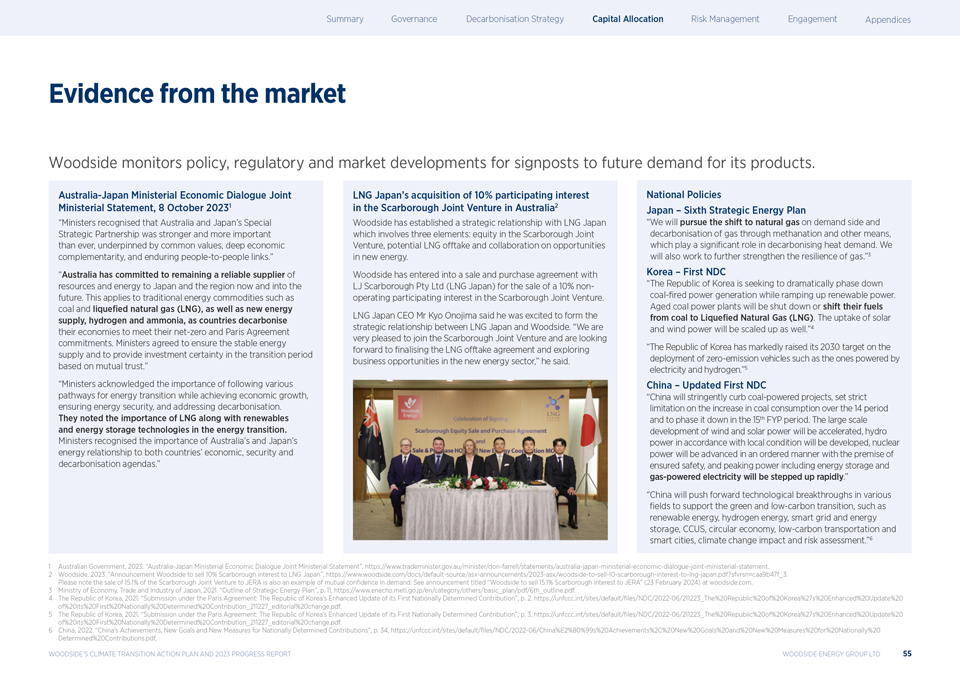 |
来自市场的证据伍德赛德监测政策、监管和市场发展,为未来对其产品的需求提供路标。20231 10月8日澳日部长级经济对话联合部长声明-部长们认识到,澳大利亚和日本的S特别战略伙伴关系比以往任何时候都更加强大和重要,其基础是共同的价值观、深度的经济互补性和持久的民间联系。澳大利亚承诺从现在到未来继续成为日本和该地区可靠的资源和能源供应国。这适用于煤炭和液化天然气(LNG)等传统能源大宗商品,以及新能源供应氢气和氨气,因为各国正在实现经济脱碳,以实现净零排放和《巴黎协定》承诺。部长们同意确保稳定的能源供应,并在相互信任的基础上在过渡期提供投资确定性。部长们认识到遵循各种能源过渡路径的重要性,同时实现经济增长,确保能源安全,并解决脱碳问题。他们指出了液化天然气以及可再生能源和储能技术在能源转型中的重要性。部长们认识到了澳大利亚?S和日本?S能源关系对两国的重要性?经济、安全和脱碳议程。液化天然气日本?S收购澳大利亚斯卡伯勒合资企业10%的权益2伍德赛德与液化天然气日本建立了战略关系,涉及三个要素:斯卡伯勒合资企业的股权、潜在的液化天然气承购以及在新能源机遇上的合作。Woodside已与LJ Scarborough Pty Ltd(LNG Japan)签订买卖协议,出售Scarborough合资公司10%的非经营性参股权益。LNG日本首席执行官Kyo Onojima先生表示,他很高兴能在LNG日本和伍德赛德之间建立战略合作关系。我们很高兴加入斯卡伯勒合资企业,并期待着敲定液化天然气承购协议,探索新能源领域的商机。他说。日本的国家政策?第六个战略能源计划?我们将在需求方面转向天然气,并通过甲烷化等方式对天然气进行脱碳,这对降低热需求具有重要作用。我们还将努力进一步加强天然气的弹性。第一个NDC?韩国正在寻求大幅减少燃煤发电,同时增加可再生能源。老化的燃煤电厂将被关闭或将燃料从煤炭转向液化天然气(LNG)。太阳能和风能的利用也将扩大。?4?韩国显著提高了2030年部署电力和氢能汽车等零排放汽车的目标。?5中国?更新:首届国家发改委中国将严格控制燃煤项目,严格限制十四期煤炭消费增长,并在十五期间逐步压低煤炭消费。加快风能和太阳能的规模化发展,因地制宜发展水电,在确保安全的前提下有序推进核电,加快储能、气电等调峰发电。中国将推动可再生能源、氢能、智能电网和储能、CCUS、循环经济、低碳交通和智慧城市、气候变化影响和风险评估等各领域的技术突破,支持绿色低碳转型。?澳日部长级经济对话联合部长声明?, https://www.trademinister.gov.au/minister/don-farrell/statements/australia-japan-ministerial-economic-dialogue-joint-ministerial-statement.伍德赛德2号,2023年。?宣布伍德赛德将斯卡伯勒10%的权益出售给液化天然气日本?, https://www.woodside.com/docs/default-source/asx-announcements/2023-asx/woodside-to-sell-10-scarborough-interest-to-lng-japan.pdf?sfvrsn=caa9b47f_3.请注意,将斯卡伯勒合资企业15.1%的股份出售给JERA也是双方对需求充满信心的一个例子。参见Woodside将15.1%的Scarborough权益出售给jera?(2024年2月23日)的公告。3日本经济产业省,2021年。?《战略能源规划纲要》,第11页, https://www.enecho.meti.go.jp/en/category/others/basic_plan/pdf/6th_outline.pdf.4大韩民国,2021年。?根据《巴黎协定》提交的材料:大韩民国?S加强更新其第一个国家确定的贡献?,第2页, https://unfccc.int/sites/default/files/NDC/2022-06/211223_The%20Republic%20of%20Korea%27s%20Enhanced%20Update%20 of%20its%20First%20Nationally%20Determined%20Contribution_211227_editorial%20change.pdf.。5大韩民国,2021年。?根据《巴黎协定》提交的材料:大韩民国?S加强更新其第一个国家确定的贡献?,第3页,https://unfccc.int/sites/default/files/NDC/2022-06/211223_The%20Republic%20of%20Korea%27s%20Enhanced%20Update%20 of%20its%20First%20Nationally%20Determined%20Contribution_211227_editorial%20change.pdf.。6中国,2022年。?中国?S的成就、国家自主贡献的新目标和新措施?,第34页, https://unfccc.int/sites/default/files/NDC/2022-06/China%E2%80%99s%20Achievements%2C%20New%20Goals%20and%20New%20Measures%20for%20Nationally%20确定%20贡献。pdf,伍德赛德?S气候转型行动计划和2023年进展报告
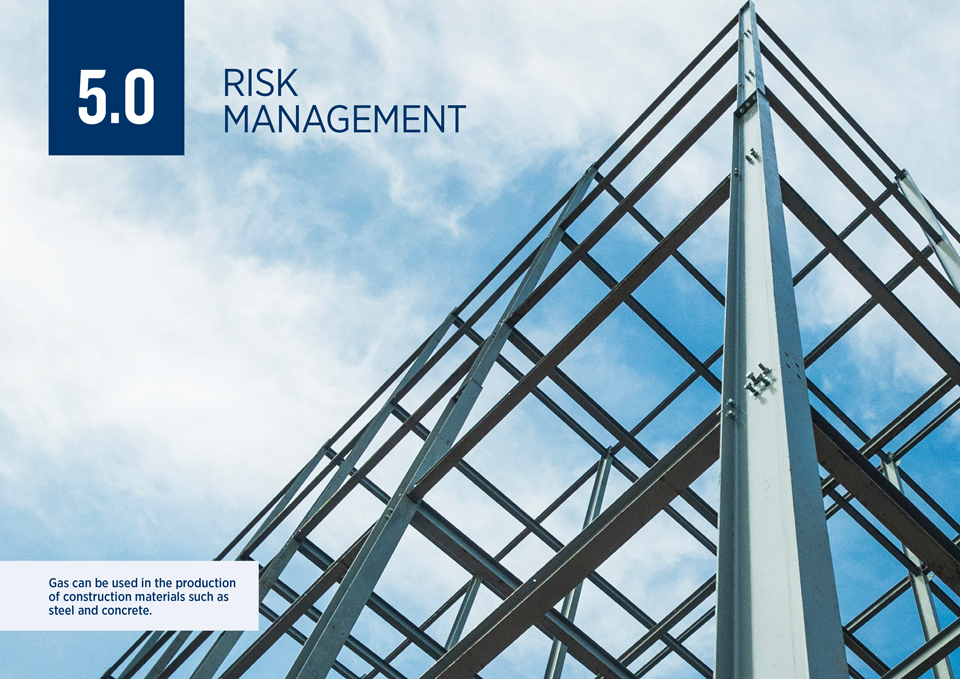 |
5.0风险管理气体可用于 建筑材料的生产,如钢材和混凝土。
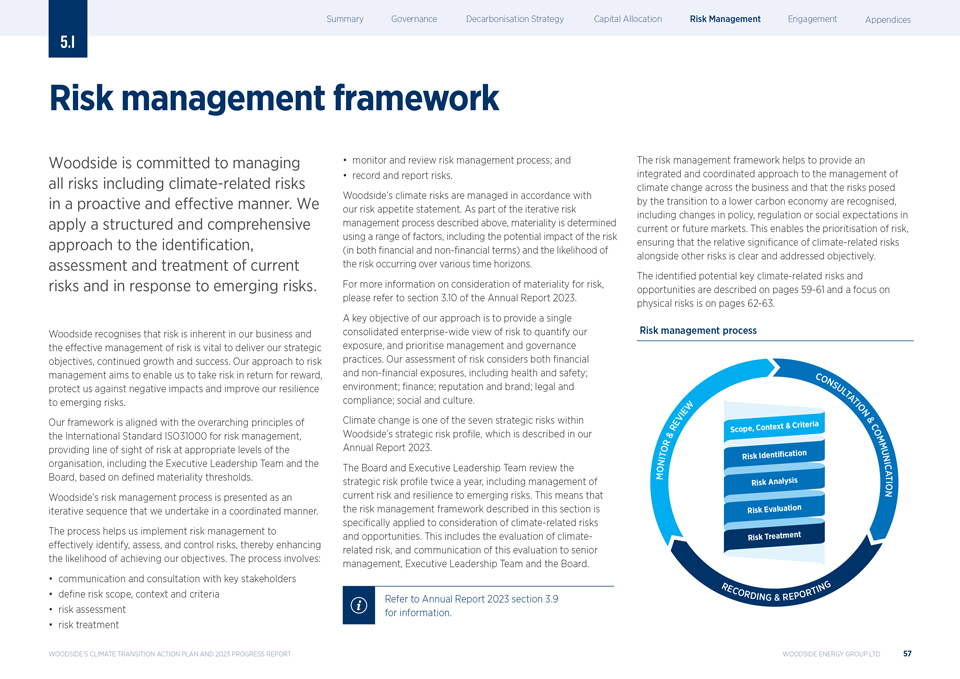 |
5.1 Risk management framework Woodside is committed to managing all risks including climate-related risks in a proactive and effective manner. We apply a structured and comprehensive approach to the identification, assessment and treatment of current risks and in response to emerging risks. Woodside recognises that risk is inherent in our business and the effective management of risk is vital to deliver our strategic objectives, continued growth and success. Our approach to risk management aims to enable us to take risk in return for reward, protect us against negative impacts and improve our resilience to emerging risks. Our framework is aligned with the overarching principles of the International Standard ISO31000 for risk management, providing line of sight of risk at appropriate levels of the organisation, including the Executive Leadership Team and the Board, based on defined materiality thresholds. Woodside?s risk management process is presented as an iterative sequence that we undertake in a coordinated manner. The process helps us implement risk management to effectively identify, assess, and control risks, thereby enhancing the likelihood of achieving our objectives. The process involves: communication and consultation with key stakeholders define risk scope, context and criteria risk assessment risk treatment monitor and review risk management process; and record and report risks. Woodside?s climate risks are managed in accordance with our risk appetite statement. As part of the iterative risk management process described above, materiality is determined using a range of factors, including the potential impact of the risk (in both ?nancial and non-?nancial terms) and the likelihood of the risk occurring over various time horizons. For more information on consideration of materiality for risk, please refer to section 3.10 of the Annual Report 2023. A key objective of our approach is to provide a single consolidated enterprise-wide view of risk to quantify our exposure, and prioritise management and governance practices. Our assessment of risk considers both ?nancial and non-?nancial exposures, including health and safety; environment; ?nance; reputation and brand; legal and compliance; social and culture. Climate change is one of the seven strategic risks within Woodside?s strategic risk profile, which is described in our Annual Report 2023. The Board and Executive Leadership Team review the strategic risk pro?le twice a year, including management of current risk and resilience to emerging risks. This means that the risk management framework described in this section is speci?cally applied to consideration of climate-related risks and opportunities. This includes the evaluation of climate-related risk, and communication of this evaluation to senior management, Executive Leadership Team and the Board. Refer to Annual Report 2023 section 3.9 for information. The risk management framework helps to provide an integrated and coordinated approach to the management of climate change across the business and that the risks posed by the transition to a lower carbon economy are recognised, including changes in policy, regulation or social expectations in current or future markets. This enables the prioritisation of risk, ensuring that the relative signi?cance of climate-related risks alongside other risks is clear and addressed objectively. The identi?ed potential key climate-related risks and opportunities are described on pages 59-61 and a focus on physical risks is on pages 62-63. Risk management process WOODSIDE?S CLIMATE TRANSITION ACTION PLAN AND 2023 PROGRESS REPORT WOODSIDE ENERGY GROUP LTD 57
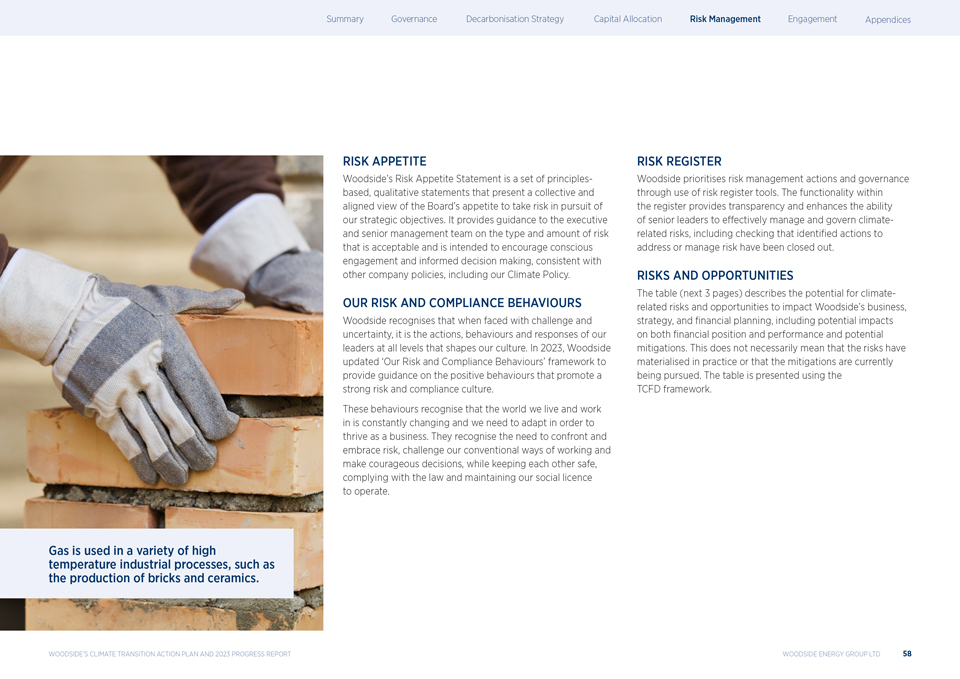 |
风险偏好伍德赛德?风险偏好表是 一套以原则为基础的定性表,以呈现董事会的集体一致观点?他愿意冒险追求我们的战略目标。它为高管和高级管理团队提供关于可接受风险类型 和数量的指导,旨在鼓励有意识的参与和知情的决策,与其他公司政策(包括我们的气候政策)保持一致。我们的风险和容忍行为Woodside认识到, 当面临挑战和不确定性时,正是我们各级领导人的行动、行为和反应塑造了我们的文化。2023年,伍德赛德更新了?我们的风险与合规行为?为促进强大风险和合规文化的积极 行为提供指导的框架。这些行为认识到,我们生活和工作的世界在不断变化,我们需要适应,以作为一个企业蓬勃发展。他们认识到有必要面对和拥抱风险,挑战我们传统的工作方式,做出勇敢的决定,同时确保彼此的安全,遵守法律,保持我们的社会经营许可。风险登记册Woodside通过使用风险登记册工具优先考虑风险管理行动和 治理。登记册内的功能提供了透明度,并增强了高级领导人有效管理和治理气候相关风险的能力,包括检查识别?解决或管理风险的行动 已关闭。风险和机遇下表(下3页)描述了潜在的气候相关风险和机遇影响伍德赛德?的业务、战略和财务规划,包括对财务状况和绩效的潜在影响以及潜在的缓解措施。这并不一定意味着风险已在实践中出现或目前正在采取缓解措施。该表使用TCFD 框架显示。气体用于各种高温工业过程,如砖和陶瓷的生产。伍德赛德?2023年全球气候变迁行动计划与进展报告Woodside Energy Group Limited 58
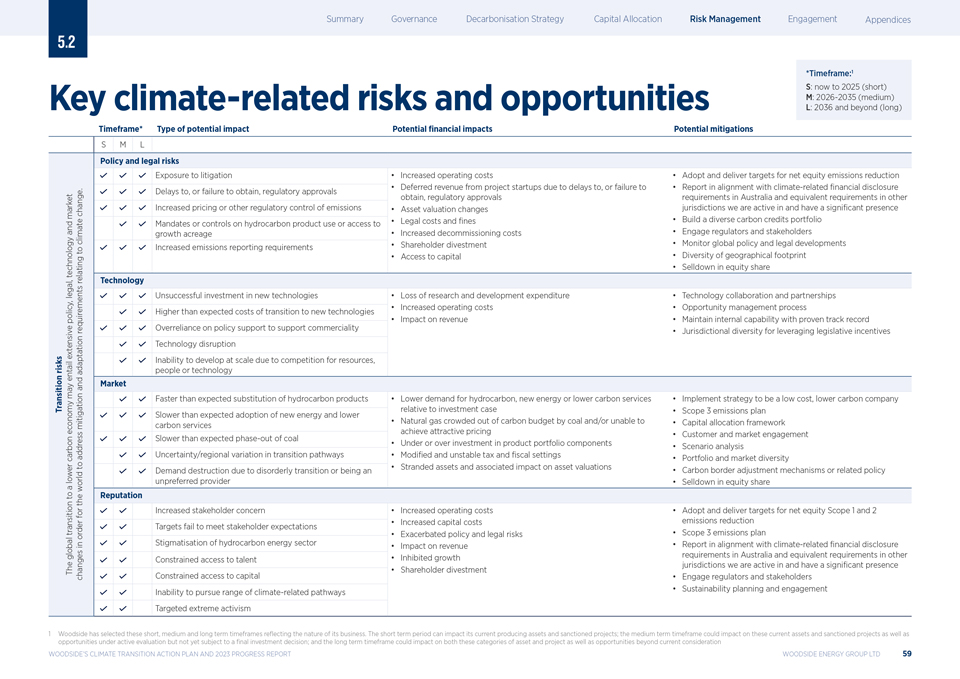 |
5.2 *Timeframe:1 S: now to 2025 (short) Key climate-related risks and opportunities M: 2026-2035 (medium) L: 2036 and beyond (long) Timeframe* Type of potential impact Potential ?nancial impacts Potential mitigations S M L Policy and legal risks Exposure to litigation Increased operating costs Adopt and deliver targets for net equity emissions reduction . Deferred revenue from project startups due to delays to, or failure to Report in alignment with climate-related ?nancial disclosure Delays to, or failure to obtain, regulatory approvals obtain, regulatory approvals requirements in Australia and equivalent requirements in other change Increased pricing or other regulatory control of emissions Asset valuation changes jurisdictions we are active in and have a significant presence market Mandates or controls on hydrocarbon product use or access to Legal costs and fines Build a diverse carbon credits portfolio and growth acreage Increased decommissioning costs Engage regulators and stakeholders climate Increased emissions reporting requirements Shareholder divestment Monitor global policy and legal developments to Diversity of geographical footprint Access to capital technology Selldown in equity share relating Technology legal, Unsuccessful investment in new technologies Loss of research and development expenditure Technology collaboration and partnerships Increased operating costs Opportunity management process Higher than expected costs of transition to new technologies policy, Impact on revenue Maintain internal capability with proven track record requirements Overreliance on policy support to support commerciality Jurisdictional diversity for leveraging legislative incentives extensive Technology disruption Inability to develop at scale due to competition for resources, risks adaptation people or technology entail and Market may Faster than expected substitution of hydrocarbon products Lower demand for hydrocarbon, new energy or lower carbon services Implement strategy to be a low cost, lower carbon company Transition relative to investment case Scope 3 emissions plan Slower than expected adoption of new energy and lower Natural gas crowded out of carbon budget by coal and/or unable to Capital allocation framework mitigation carbon services economy achieve attractive pricing Slower than expected phase-out of coal Customer and market engagement Under or over investment in product portfolio components Scenario analysis carbon address Uncertainty/regional variation in transition pathways Modified and unstable tax and fiscal settings Portfolio and market diversity to lower Demand destruction due to disorderly transition or being an Stranded assets and associated impact on asset valuations Carbon border adjustment mechanisms or related policy unpreferred provider Selldown in equity share a world to Reputation the for Increased stakeholder concern Increased operating costs Adopt and deliver targets for net equity Scope 1 and 2 Increased capital costs emissions reduction Targets fail to meet stakeholder expectations transition order Exacerbated policy and legal risks Scope 3 emissions plan in Stigmatisation of hydrocarbon energy sector Impact on revenue Report in alignment with climate-related ?nancial disclosure global requirements in Australia and equivalent requirements in other Inhibited growth Constrained access to talent jurisdictions we are active in and have a significant presence The Shareholder divestment changes Constrained access to capital Engage regulators and stakeholders Inability to pursue range of climate-related pathways Sustainability planning and engagement Targeted extreme activism 1 Woodside has selected these short, medium and long term timeframes re?ecting the nature of its business. The short term period can impact its current producing assets and sanctioned projects; the medium term timeframe could impact on these current assets and sanctioned projects as well as opportunities under active evaluation but not yet subject to a ?nal investment decision; and the long term timeframe could impact on both these categories of asset and project as well as opportunities beyond current consideration WOODSIDE?S CLIMATE TRANSITION ACTION PLAN AND 2023 PROGRESS REPORT WOODSIDE ENERGY GROUP LTD 59
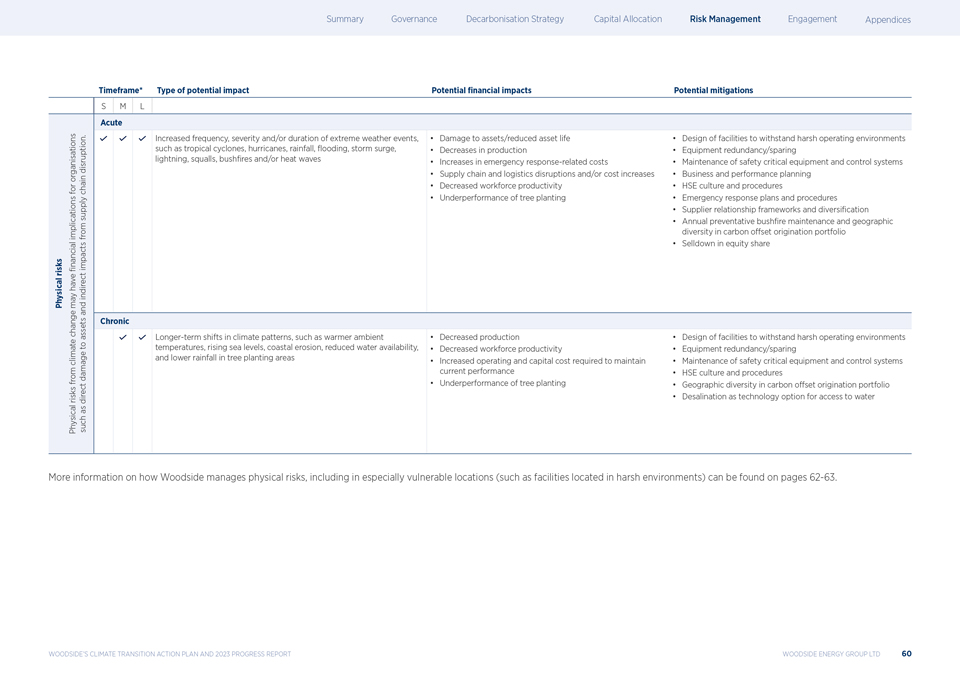 |
时间范围 * 潜在影响类型潜在 ?财务影响潜在缓解措施S M L急性。极端天气事件的频率、严重程度和/或持续时间增加,资产损坏/资产寿命缩短,设施设计可承受恶劣操作环境,如热带 旋风、飓风、降雨、洪水、风暴潮、生产减少设备冗余/避免中断闪电、狂风、防止火灾和/或热浪增加应急响应相关成本维持关键安全 设备和控制系统组织供应链和物流中断和/或成本增加供应链业务和绩效规划劳动力生产率下降HSE文化和程序植树表现不佳 应急响应计划和程序提供供应商关系框架和多样性?阳年度预防性火灾维护和碳抵消来源组合多样性带来的地理影响金融影响 股权出售风险具有间接的物理可能性和变化资产长期气候模式的变化,例如环境变暖生产减少设计设施以承受恶劣的操作环境,应对温度、海平面上升 、海岸侵蚀、水资源减少,劳动力生产率下降植树区设备冗余/气候减少和降雨量减少维护安全所需的运营和资本成本增加 关键设备和控制系统维护因植树表现不佳而损害当前绩效HSE文化和程序碳抵消来源组合的地理多样性风险直接将海水淡化作为获取技术选项 有关Woodside如何管理物理风险的更多信息,包括在特别脆弱的地点(如位于恶劣环境中的设施),请参阅第62—63页。伍德赛德?气候变迁行动计划 与2023年进展报告Woodside Energy Group Ltd 60
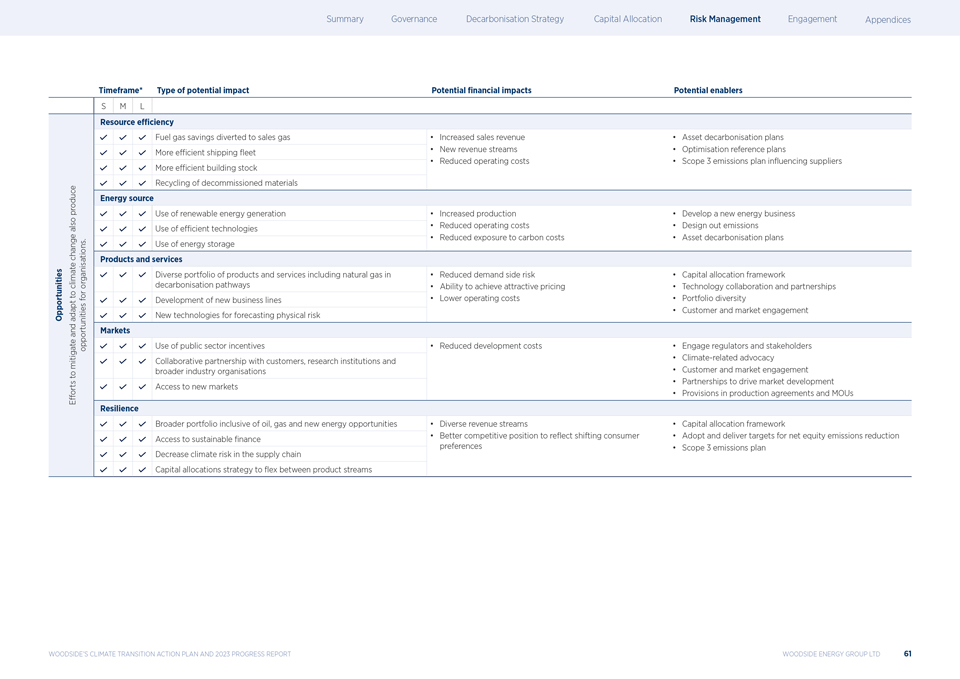 |
时间范围 * 潜在影响类型潜在 ?财务影响潜在推动因素S M L资源效率燃料气节省转移到销售气体增加销售收入资产脱碳计划更有效的运输船队新收入流优化参考计划降低运营 成本范围3排放计划在?供应商更高效的建筑库存回收废弃材料生产能源使用可再生能源发电增加产量同时开发新能源业务使用高效 技术降低运营成本设计排放减少碳成本风险资产脱碳计划变更。能源存储产品和服务多样化的产品和服务组合,包括天然气,减少需求侧风险 资本配置框架气候组织脱碳途径实现有吸引力的定价能力技术合作和伙伴关系,以开发新业务线更低的运营成本组合 多样性客户和市场参与机会适应新技术,用于预测实体风险和市场机会利用公共部门激励措施降低开发成本让监管机构参与,利益相关者减少与客户、研究机构和气候相关倡导的合作伙伴关系,扩大行业组织客户和市场参与进入新市场的合作伙伴关系,推动市场开发努力在生产协议和谅解备忘录中作出规定,包括石油,天然气和新能源机会多样化的收入来源资本分配框架获得可持续融资更好的竞争地位,以反映消费者的不断变化实现净权益减排目标降低供应链偏好中的气候风险范围3排放计划资本分配战略?产品流之间的ex Woodside?气候变迁行动计划与2023年进展 报告Woodside Energy Group Ltd 61
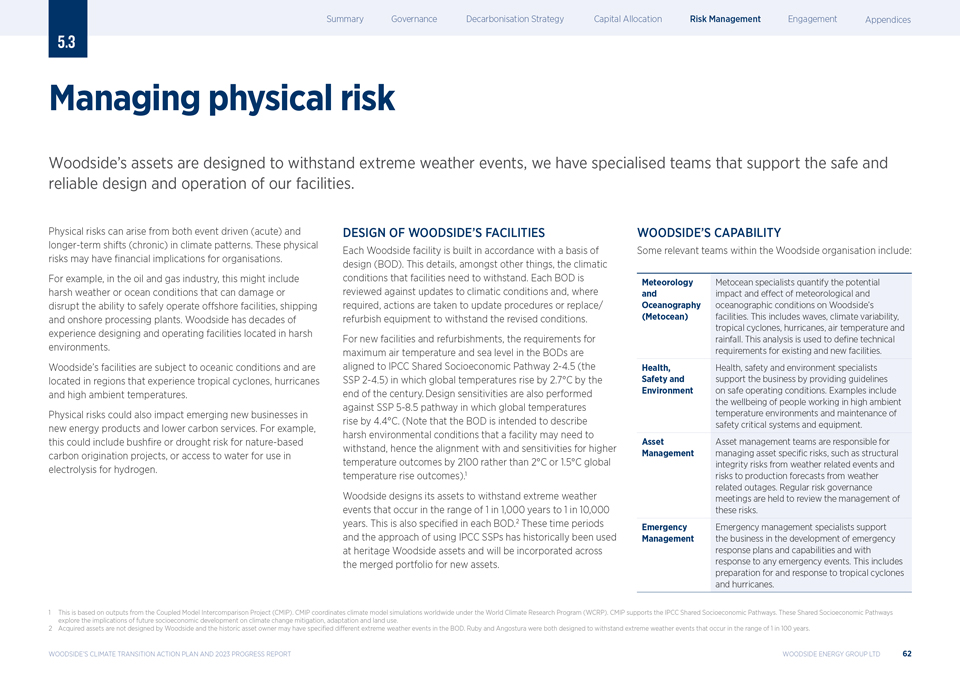 |
5.3 Managing physical risk Woodside?s assets are designed to withstand extreme weather events, we have specialised teams that support the safe and reliable design and operation of our facilities. Physical risks can arise from both event driven (acute) and longer-term shifts (chronic) in climate patterns. These physical risks may have ?nancial implications for organisations. For example, in the oil and gas industry, this might include harsh weather or ocean conditions that can damage or disrupt the ability to safely operate offshore facilities, shipping and onshore processing plants. Woodside has decades of experience designing and operating facilities located in harsh environments. Woodside?s facilities are subject to oceanic conditions and are located in regions that experience tropical cyclones, hurricanes and high ambient temperatures. Physical risks could also impact emerging new businesses in new energy products and lower carbon services. For example, this could include bush?re or drought risk for nature-based carbon origination projects, or access to water for use in electrolysis for hydrogen. DESIGN OF WOODSIDE?S FACILITIES Each Woodside facility is built in accordance with a basis of design (BOD). This details, amongst other things, the climatic conditions that facilities need to withstand. Each BOD is reviewed against updates to climatic conditions and, where required, actions are taken to update procedures or replace/ refurbish equipment to withstand the revised conditions. For new facilities and refurbishments, the requirements for maximum air temperature and sea level in the BODs are aligned to IPCC Shared Socioeconomic Pathway 2-4.5 (the SSP 2-4.5) in which global temperatures rise by 2.7C by the end of the century. Design sensitivities are also performed against SSP 5-8.5 pathway in which global temperatures rise by 4.4C. (Note that the BOD is intended to describe harsh environmental conditions that a facility may need to withstand, hence the alignment with and sensitivities for higher temperature outcomes by 2100 rather than 2C or 1.5C global temperature rise outcomes).1 Woodside designs its assets to withstand extreme weather events that occur in the range of 1 in 1,000 years to 1 in 10,000 years. This is also speci?ed in each BOD.2 These time periods and the approach of using IPCC SSPs has historically been used at heritage Woodside assets and will be incorporated across the merged portfolio for new assets. WOODSIDE?S CAPABILITY Some relevant teams within the Woodside organisation include: Meteorology Metocean specialists quantify the potential and impact and effect of meteorological and Oceanography oceanographic conditions on Woodside?s (Metocean) facilities. This includes waves, climate variability, tropical cyclones, hurricanes, air temperature and rainfall. This analysis is used to de?ne technical requirements for existing and new facilities. Health, Health, safety and environment specialists Safety and support the business by providing guidelines Environment on safe operating conditions. Examples include the wellbeing of people working in high ambient temperature environments and maintenance of safety critical systems and equipment. Asset Asset management teams are responsible for Management managing asset speci?c risks, such as structural integrity risks from weather related events and risks to production forecasts from weather related outages. Regular risk governance meetings are held to review the management of these risks. Emergency Emergency management specialists support Management the business in the development of emergency response plans and capabilities and with response to any emergency events. This includes preparation for and response to tropical cyclones and hurricanes. 1 This is based on outputs from the Coupled Model Intercomparison Project (CMIP). CMIP coordinates climate model simulations worldwide under the World Climate Research Program (WCRP). CMIP supports the IPCC Shared Socioeconomic Pathways. These Shared Socioeconomic Pathways explore the implications of future socioeconomic development on climate change mitigation, adaptation and land use. 2 Acquired assets are not designed by Woodside and the historic asset owner may have speci?ed different extreme weather events in the BOD. Ruby and Angostura were both designed to withstand extreme weather events that occur in the range of 1 in 100 years. WOODSIDE?S CLIMATE TRANSITION ACTION PLAN AND 2023 PROGRESS REPORT WOODSIDE ENERGY GROUP LTD 62
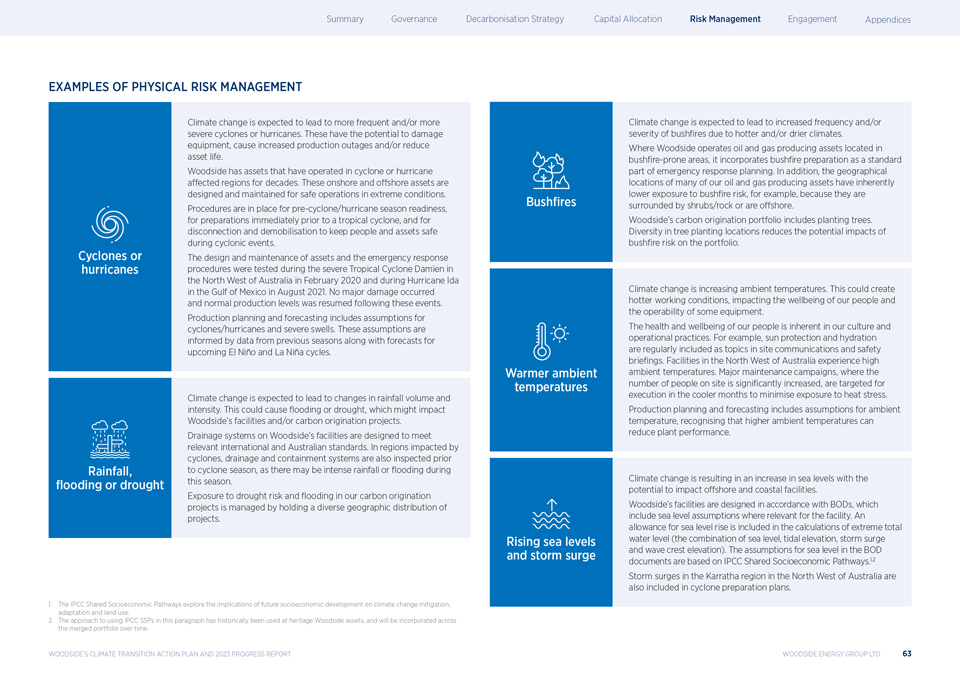 |
实际风险管理实例气候变化 预计将导致更频繁和/或更严重的气旋或飓风。这些问题有可能损坏设备、导致更多的生产中断和/或缩短资产寿命。伍德赛德拥有几十年来一直在受飓风或飓风影响的地区运营的资产。这些在岸和离岸资产的设计和维护是为了在极端条件下安全运营。已制定了气旋前/飓风季节准备、紧接热带气旋前的准备以及切断连接和遣散以在气旋期间保护人员和资产安全的程序。在2020年2月澳大利亚西北部的强热带气旋“达米恩”期间和2021年8月墨西哥湾的“艾达”飓风期间,对资产的设计和维护以及应急程序进行了测试。这些事件没有造成重大损害,恢复了正常的生产水平。生产计划和预测包括 对气旋/飓风和严重涌浪的假设。这些假设是由前几个季节的数据以及对即将到来的厄尔尼诺和拉尼娜周期的预测得出的。气候变化预计将导致降雨量和降雨量强度的变化。这可能会导致洪水或干旱,这可能会影响伍德赛德?S的设施和/或碳源项目。伍德赛德?S工厂的排水系统设计符合相关的国际和澳大利亚标准。在受气旋影响的地区,排水和围堵系统也会在气旋季节之前进行检查,因为这个季节可能会有强降雨或洪水。在我们的碳源项目中,面临干旱风险和污染的风险是通过持有不同地理分布的项目来管理的。气候变化预计将导致更热和/或更干燥的气候导致丛林退化的频率和/或严重性增加。在伍德赛德运营位于丛林易发地区的石油和天然气生产资产的地方,它将丛林准备作为应急计划的标准部分。此外,我们许多石油和天然气生产资产的地理位置天生就具有较低的丛林风险敞口,例如,因为它们被灌木/岩石包围或位于海上。伍德赛德?S的碳源投资组合包括植树。植树地点的多样性减少了森林火灾风险对投资组合的潜在影响。气候 变化正在提高环境温度。这可能会造成更热的工作条件,影响我们人民的福祉和一些设备的可操作性。我们人民的健康和福祉是我们的文化和运营实践中固有的 。例如,防晒和补水经常作为主题包括在现场交流和安全简介中。澳大利亚西北部的设施经历了高温环境。大型维护活动的现场人员数量明显增加,目标是在较凉爽的月份执行,以最大限度地减少暴露在热应激下。生产计划和预测包括对环境温度的假设,认识到较高的环境温度会降低工厂的绩效。气候变化正在导致海平面上升,有可能影响近海和沿海设施。伍德赛德?S工厂根据BOD进行设计,其中包括与工厂相关的海平面假设。在极端总水位(海平面、潮汐高度、风暴潮和波峰高度的组合)的计算中包括海平面上升的容许量。BOD文件中对海平面的假设 基于气专委共享的社会经济路径。澳大利亚西北部卡拉塔地区的1,2次风暴潮也包括在气旋准备计划中。1气专委的共同社会经济途径 探讨未来社会经济发展对气候变化缓解、适应和土地利用的影响。2本段中使用IPCC SSP的方法历来在伍德赛德遗产资产中使用,随着时间的推移将被并入合并后的投资组合中。伍德赛德?S气候转型行动计划和2023年进展报告伍德赛德能源集团有限公司63
 |
6.0参与度
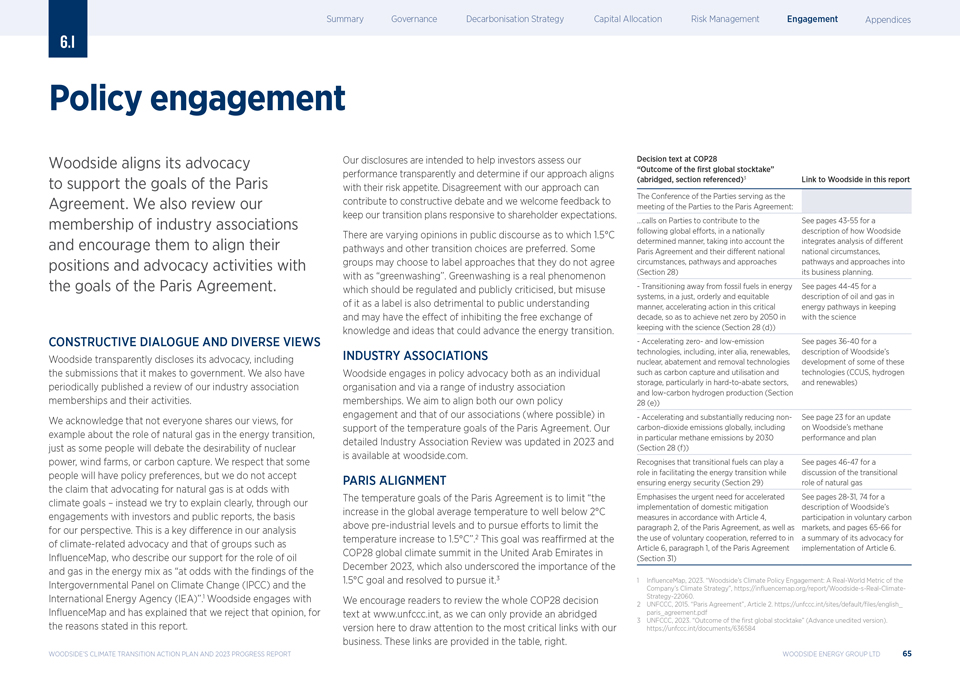 |
6.1政策参与Woodside将其宣传 调整为支持《巴黎协定》的目标。我们还审查了行业协会的会员资格,并鼓励它们将其立场和宣传活动与《巴黎协定》的目标保持一致。协商性对话和不同的观点 伍德赛德透明地披露了其倡导,包括它向政府提交的意见。我们还定期发布行业协会会员资格及其活动的回顾。我们承认并不是每个人都同意我们的观点,例如,关于天然气在能源转型中的作用,就像有些人会辩论核能、风力发电场或碳捕获的可取性一样。我们尊重一些人会有政策偏好,但我们不接受主张天然气与气候目标不一致的说法?相反,我们会透过与投资者的接触和公开报告,清楚解释我们的观点的基础。这是我们对 气候相关倡导的分析与InfluenceMap等团体的分析的一个关键区别,后者将我们对石油和天然气在能源结构中作用的支持描述为?与政府间气候变化专门委员会(IPCC)和国际能源署(IEA)的研究结果不一致?#21431;?uenceMap并解释说,基于本报告所述的理由,我们拒绝接受这一意见。伍德赛德?气候转变行动计划及2023年进展报告我们的披露旨在帮助 投资者透明地评估我们的表现,并确定我们的方法是否符合他们的风险偏好。对我们的方法的分歧可能有助于进行建设性的辩论,我们欢迎反馈,以保持我们的过渡计划响应 股东的期望。在公众讨论中,有不同的意见1。一些团体可能会选择将他们不同意的方法贴上“洗绿”的标签。绿色清洗是一种真实的现象,应该受到监管和公开批评,但滥用它作为标签也不利于公众的理解,可能会抑制知识和思想的自由交流,从而促进能源转型 。行业协会伍德赛德作为一个单独的组织和通过一系列行业协会成员参与政策宣传。我们的目标是使我们自己的政策参与和我们协会的政策参与(在可能的情况下)保持一致,以支持《巴黎协定》的温度目标。我们的详细行业协会评估于2023年更新,可在Wood side.com上查阅。2.2023年12月在阿拉伯联合酋长国举行的COP28全球气候峰会重申了这一目标,强调了1.5摄氏度目标的重要性,并决心实现这一目标。3我们鼓励读者在www.unfcc.int上查看整个COP28决定文本,因为我们在这里只能提供一个节略版本,以引起人们对与我们业务最关键的联系的关注。表中提供了这些链接,对吧。缔约方会议第二十八届会议的决定文本--第一次全球评估的结果?3本报告中伍德赛德缔约方会议作为《巴黎协定》缔约方会议的链接:呼吁缔约方考虑到《巴黎协定》及其不同的国情,以国家自主的方式为下列全球努力作出贡献(第28节),见第43-55页,说明伍德赛德如何将对不同国家情况、途径和办法的分析纳入其业务规划。 影响地图,2023年。?伍德赛德?气候政策参与:公司的现实衡量标准?气候战略?https://influencemap.org/report/Woodside-s-Real-Climate- Strategy-22060.《气候公约》,2015年。?巴黎协定?第2条. https://unfccc.int/sites/default/files/english_ ?第一次全球盘点的结果?(未经编辑的预发稿)。https://unfccc.int/documents/636584
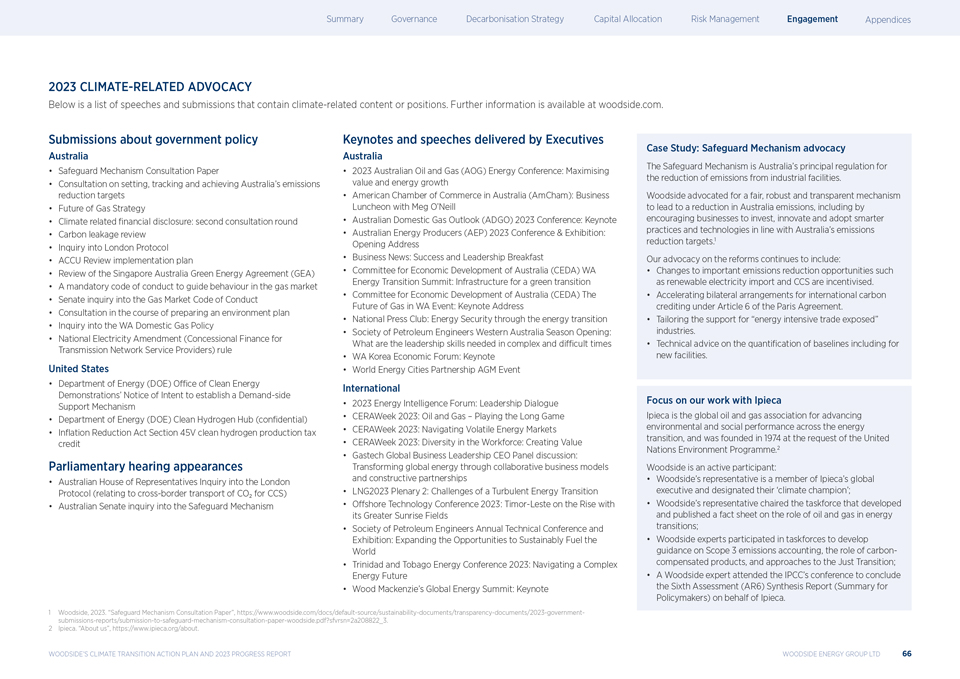 |
2023年与气候有关的倡导以下是包含与气候有关的内容或立场的演讲和意见书的列表。欲了解更多信息,请访问伍德赛德网站。关于政府政策的意见书澳大利亚保障机制咨询文件关于制定、跟踪和实现澳大利亚?S减排目标的咨询天然气战略的未来气候相关?财务披露:第二轮咨询碳泄漏审查对伦敦议定书的调查ACCU审查执行计划新加坡的审查 澳大利亚绿色能源协议(GEA)指导天然气市场行为的强制性行为守则参议院对天然气市场行为守则的调查在编制环境计划的过程中对行为守则的咨询调查西澳国内天然气 政策国家电力修正案(针对传输网络服务提供商的优惠融资)规则美国能源部清洁能源示范办公室?建立需求方支持机制的意向通知 能源部(DOE)清洁氢气枢纽(持续)在削减法案第45v条清洁氢气生产税收抵免议会听证会澳大利亚众议院调查伦敦议定书 (与跨境运输CO?对于CCS)澳大利亚参议院对保障机制的调查澳大利亚2023年澳大利亚石油和天然气(AOG)能源会议:最大化价值和能源增长 澳大利亚美国商会(AmCham):与Meg O?Neill澳大利亚国内天然气展望(ADGO)2023年会议:主旨演讲澳大利亚能源生产商(AEP)2023年会议和展览:开幕词 澳大利亚经济发展早餐委员会(CEDA)西澳能源过渡峰会:澳大利亚经济发展的绿色过渡基础设施委员会(CEDA)澳大利亚天然气的未来Wa 活动:主旨演讲国家记者俱乐部:通过石油工程师协会的能源转型实现能源安全西澳大利亚州季节开幕:在复杂和困难的时期需要哪些领导技能Wa Korea经济论坛: 主旨演讲世界能源城市伙伴关系AGM活动国际2023年能源情报论坛:领导力对话CERAWeek 2023:石油和天然气?2023年CERAWeek:驾驭动荡的能源市场CERAWeek 2023:劳动力的多样性:创造价值Gastech全球商业领袖首席执行官小组讨论:通过协作的商业模式和建设性的合作伙伴关系转变全球能源LNG2023全体会议2:动荡的能源转型的挑战离岸技术会议2023年:东帝汶崛起,其更大的朝阳油田石油工程师学会年度技术会议和展览:扩大机会,可持续地为世界特立尼达和多巴哥能源提供燃料 2023年会议:导航复杂的能源未来Wood Mackenzie?S全球能源峰会:主旨案例研究:保障机制倡导保障机制是澳大利亚S对工业设施减排的主要规定 。伍德赛德倡导建立一个公平、稳健和透明的机制来减少澳大利亚的排放量,包括鼓励企业根据澳大利亚S的减排目标进行投资、创新和采用更智能的做法和技术。1我们对改革的倡导继续包括:鼓励改变重要的减排机会,如可再生电力进口和CCS。加快《巴黎协定》第六条规定的国际碳信用的双边安排。量身定做对能源密集型贸易的支持?工业。关于基线量化的技术咨询,包括新设施的技术咨询。重点关注我们与国际石油和天然气协会的合作国际石油和天然气协会是全球石油和天然气协会,旨在推动能源转型中的环境和社会绩效,是应联合国环境规划署的要求于1974年成立的。2伍德赛德是积极的参与者:伍德赛德?S代表是国际能源政策与政策研究所?S的全球执行成员,并被指定为他们的?气候冠军?;伍德赛德?S代表主持了编写和出版了关于石油和天然气在能源转型中的作用的情况说明书的工作队;伍德赛德专家参加了工作组,就范围3的排放核算、碳补偿产品的作用和刚刚过渡的方法制定了指导方针;伍德塞德的一位专家出席了政府间气候变化专门委员会?S会议,代表国际政策研究所完成了第六次评估(第六次评估)综合报告(政策制定者摘要)。伍德赛德,2023年。?保障机制咨询文件?, https://www.woodside.com/docs/default-source/sustainability-documents/transparency-documents/2023-government-submissions-reports/submission-to-safeguard-mechanism-consultation-paper-woodside.pdf?sfvrsn=2a208822_3.IPIECA。?关于我们?, https://www.ipieca.org/about.伍德赛德?S气候转型行动计划和2023年进展报告伍德赛德能源集团有限公司66
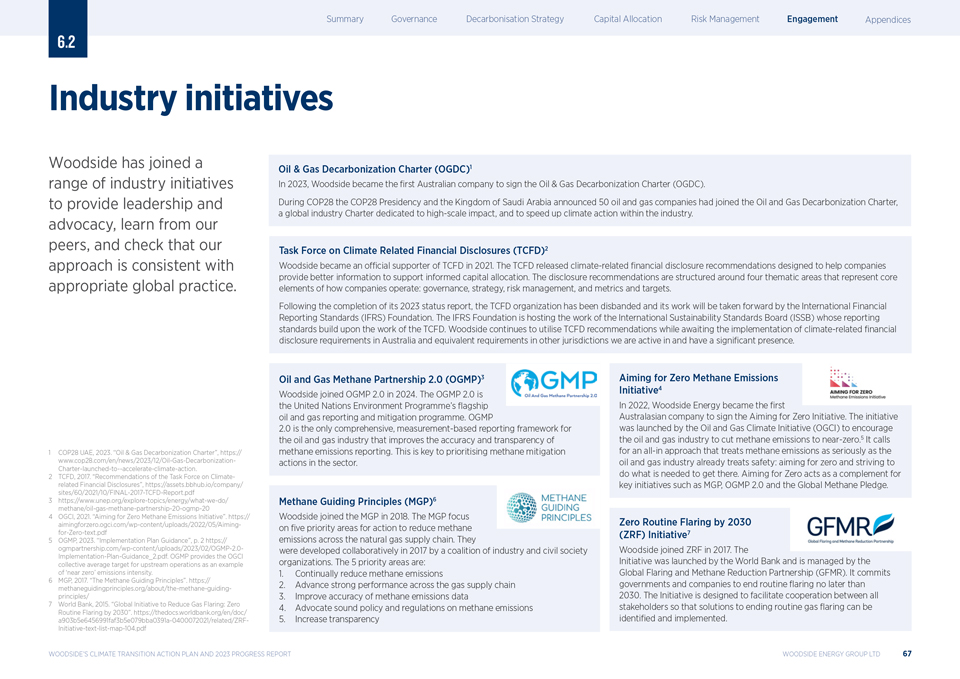 |
6.2行业倡议伍德赛德加入了一系列行业倡议,以提供领导和倡导,向同行学习,并检查我们的方法是否符合适当的全球实践。1 COP28阿联酋,2023年。?《石油和天然气脱碳宪章》,https:// www.cop28.com/en/news/2023/12/Oil-Gas-Decarbonization-Charter-launched-to—accelerate-climate-action.2 TCFD,2017。?与气候有关的财务披露工作队的建议?,https://assets.bbhub.io/company/ sites/60/2021/10/FINAL-2017-TCFD-Report.pdf 3 https://www.unep.org/explore-topics/energy/what-we-do/methane/oil-gas-methane-partnership-20-ogmp-20 4 OGCI,2021年。?旨在实现甲烷零排放倡议?Https:// aimingforzero.ogci.com/wp-content/uploads/2022/05/Aiming-for-Zero-text.pdf 5 OGMP,2023年。《实施计划指南》,第2页,http://ogmpartnership.com/wp-content/uploads/2023/02/OGMP-2.0-Implementation-Plan-Guidance_2.pdf.OGMP提供了OGCI 上游作业的集体平均目标,作为接近零的例子。排放强度。6 MGP,2017。甲烷指导原则?Methaneguidingprinciples.org/about/the-methane-guiding-principles/7世界银行,2015年。减少天然气燃烧的全球倡议:到2030年实现零常规燃烧?2023年,https://thedocs.worldbank.org/en/doc/a903b5e6456991faf3b5e079bba0391a-0400072021/related/ZRF-Initiative-text-list-map-104.pdf成为第一家签署《石油和天然气脱碳宪章》的澳大利亚公司。在缔约方会议第二十八届会议期间,第二十八届缔约方会议主席和沙特阿拉伯王国宣布,已有50家石油和天然气公司加入了《石油和天然气脱碳宪章》,这是一份致力于大规模影响和加快行业内气候行动的全球行业宪章。气候相关财务披露特别工作组(TCFD)2伍德赛德于2021年成为TCFD的官方支持者。 TCFD发布了与气候相关的财务披露建议,旨在帮助公司提供更好的信息,以支持知情的资本配置。披露建议围绕四个主题领域构建,这四个主题领域代表了公司运营方式的核心要素:治理、战略、风险管理以及指标和目标。在完成《2023年状况报告》后,TCFD组织已解散,其工作将由国际财务报告准则(IFRS)基金会推进。国际财务报告准则基金会正在主持国际可持续发展标准委员会(ISSB)的工作,该委员会的报告标准建立在TCFD工作的基础上。伍德赛德继续使用TCFD的建议,同时等待澳大利亚实施与气候有关的财务披露要求,以及我们积极参与并具有显著影响力的其他司法管辖区的同等要求。石油和天然气甲烷 合作伙伴2.0(OGMP)3伍德赛德于2024年加入OGMP 2.0。OGMP 2.0是联合国环境规划署-S的旗舰油气报告和缓解方案。OGMP 2.0是石油和天然气行业唯一一个全面的、基于测量的报告框架,可提高甲烷排放报告的准确性和透明度。这是确定该部门甲烷缓解行动优先顺序的关键。甲烷指导原则(MGP)6伍德赛德于2018年加入MGP。MGP 重点关注减少整个天然气供应链甲烷排放的优先行动领域。它们是由行业和民间社会组织联盟于2017年合作开发的。5个优先领域是:1.持续减少甲烷排放2.推动整个天然气供应链的强劲表现3.提高甲烷排放数据的准确性4.倡导健全的甲烷排放政策和法规5.提高透明度以实现甲烷零排放 倡议4.伍德赛德能源公司成为签署目标为零倡议的第一家澳大利亚公司。该倡议由石油和天然气气候倡议(OGCI)发起,旨在鼓励石油和天然气行业将甲烷排放削减到接近零的水平。5它呼吁采取全员参与的方法,像石油和天然气行业已经对待安全的那样认真对待甲烷排放:目标是零,并努力实现这一目标所需的一切。目标为零是对MGP、OGMP 2.0和全球甲烷承诺等关键举措的补充。2030年前零常规燃烧(ZRF)倡议7伍德赛德于2017年加入ZRF。该倡议由世界银行发起,由全球燃烧和减少甲烷伙伴关系(GFMR)管理。它要求各国政府和企业不迟于2030年结束常规做法。该倡议旨在促进所有利益攸关方之间的合作,以便确定并实施结束常规天然气开采的解决方案。伍德赛德?S气候转型行动计划和2023年进展报告伍德赛德能源集团有限公司67
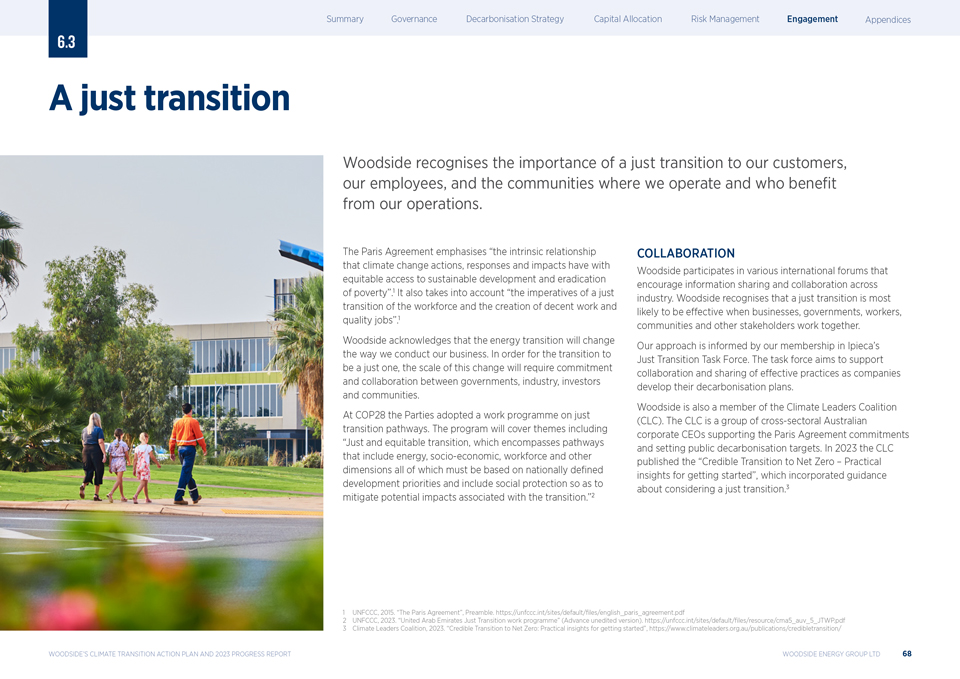 |
6.3刚刚过渡伍德赛德认识到公正过渡对我们的客户、我们的员工和我们运营所在的社区以及从我们的运营中受益的人的重要性。《巴黎协定》强调气候变化行动、应对措施和影响与公平获得可持续发展和消除贫困之间的内在关系?1它还考虑到劳动力的公正转型以及创造体面工作和高质量就业的必要性?1伍德赛德承认,能源转型将改变我们开展业务的方式。为了实现公正的过渡,这一变化的规模将需要政府、行业、投资者和社区之间的承诺和合作。在缔约方会议第二十八届会议上,缔约方通过了一项关于公正过渡途径的工作方案。该计划将涵盖的主题包括公正和公平的过渡,其中包括能源、社会经济、劳动力和其他方面的途径,所有这些方面都必须基于国家定义的发展优先事项,并包括社会保护,以减轻与过渡相关的潜在影响。?2协作伍德赛德参与各种国际论坛,鼓励跨行业信息共享和协作。伍德赛德认识到,当企业、政府、工人、社区和其他利益相关者共同努力时,公正的过渡最有可能是有效的。我们的做法是由我们在IPIECA-S刚刚过渡特别工作组的成员 提供的。该工作组的目标是在企业制定脱碳计划时支持合作和分享有效的做法。伍德赛德也是气候领袖联盟(CLC)的成员。CLC是由跨行业的澳大利亚企业首席执行官组成的组织,支持《巴黎协定》的承诺并设定公共脱碳目标。2023年,《中图法》发表了《向净零的可信过渡》。入门的实际见解?,其中 包含了考虑刚刚过渡的指导。3《联合国气候变化框架公约》,2015。?《巴黎协定》,序言。《联合国气候变化框架公约》,2023年。?阿拉伯联合酋长国刚刚过渡工作方案? (未经编辑的预览版)。Https://unfccc.int/sites/default/files/resource/cma5_auv_5_JTWP.pdf气候领袖联盟,2023年。?向净零的可信过渡:开始的实践见解?, https://www.climateleaders.org.au/publications/credibletransition/伍德赛德?S气候过渡行动计划和2023年进展报告伍德赛德能源集团有限公司68
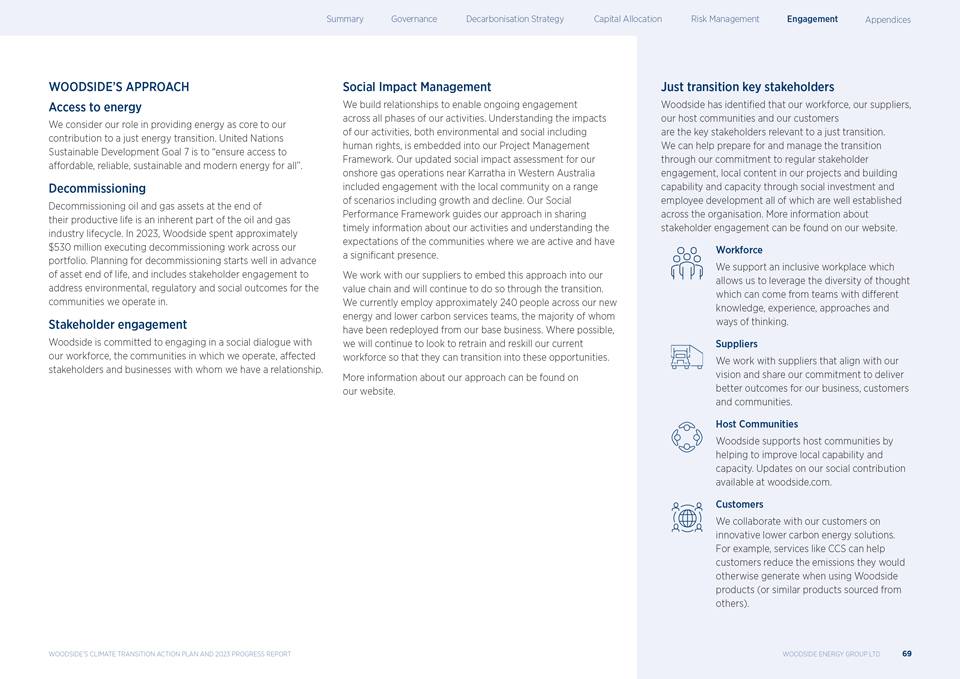 |
伍德赛德?S接近获得能源我们认为我们在提供能源方面的作用是我们对公正能源过渡的贡献的核心。联合国可持续发展目标7是“确保所有人都能获得负担得起、可靠、可持续和现代化的能源”。石油和天然气资产在其生产寿命结束时退役是石油和天然气行业生命周期的固有部分。2023年,伍德赛德在我们的投资组合中花费了约5.3亿美元执行退役工作。退役规划早在资产使用寿命结束之前就开始了,包括利益相关者的参与,以解决我们所在社区的环境、法规和社会后果。利益相关者参与伍德赛德致力于与我们的员工、我们运营的社区、受影响的利益相关者和与我们有关系的企业进行社会对话。社会影响管理我们建立关系,以便在我们活动的所有阶段持续参与。 了解我们活动的环境和社会影响,包括人权,嵌入到我们的项目管理框架中。我们对西澳大利亚卡拉塔附近陆上天然气业务的最新社会影响评估包括与当地社区就一系列情景进行接触,包括增长和下降。我们的社会绩效框架指导我们分享有关我们活动的及时信息,并了解我们活跃并具有重要影响力的社区的期望。我们与供应商合作,将这种方法嵌入到我们的价值链中,并将在过渡期间继续这样做。我们目前在新能源和低碳服务团队中雇佣了大约240名员工,其中大多数人已经从我们的基础业务中重新部署。在可能的情况下,我们将继续寻求对现有员工进行再培训和重新培训,以便他们能够过渡到这些机会。 有关我们方法的更多信息,请访问我们的网站。刚刚过渡的关键利益相关者伍德赛德认识到,我们的员工、供应商、东道国社区和客户是与刚刚过渡相关的关键利益相关者。我们可以通过承诺定期让利益相关者参与、在我们的项目中包含本地内容,以及通过社会投资和员工发展来建设能力和能力,来帮助准备和管理过渡,所有这些都在整个组织内得到了很好的确立。关于利益相关者参与的更多信息可以在我们的网站上找到。员工队伍我们支持包容性的工作场所,使我们能够利用拥有不同知识、经验、方法和思维方式的团队 提供的多元化思维。供应商我们与与我们的愿景一致的供应商合作,并分享我们的承诺,为我们的业务、客户和社区提供更好的结果。东道主社区 伍德赛德通过帮助提高当地的能力和能力为东道主社区提供支持。有关我们的社会贡献的最新信息,请访问Woodside.com。[图形显示在此处]客户我们与客户就创新的低碳 能源解决方案开展合作。例如,CCS等服务可以帮助客户减少使用Woodside产品(或其他产品的类似产品)时产生的排放。伍德赛德?2023年全球气候变迁行动计划与进展报告Woodside Energy Group Ltd 69
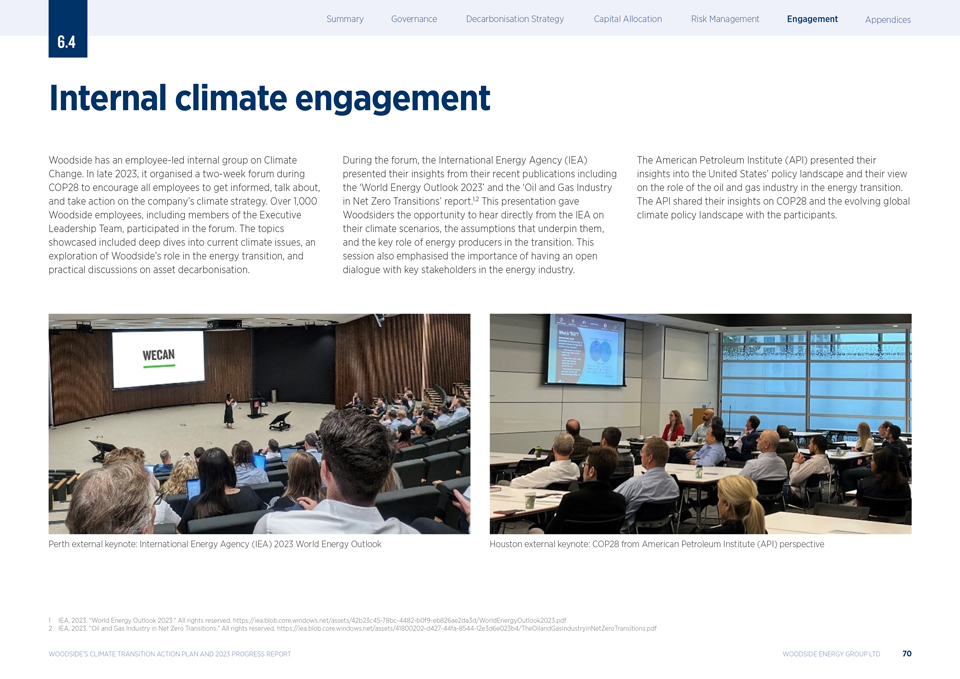 |
6.4内部气候参与伍德赛德有一个 领导的气候变化内部小组。2023年底,该公司在COP28期间组织了为期两周的论坛,鼓励所有员工了解、谈论公司的情况并采取行动。的气候战略。超过1000名Woodside员工,包括行政领导团队成员,参加了论坛。展示的主题包括深入研究当前的气候问题,探索伍德赛德?在能源转型中的作用,以及资产脱碳的实际讨论。在论坛期间,国际能源署(IEA)介绍了他们最近出版物的见解,包括?2023年世界能源展望?那呢?石油和天然气行业在净零转型?report.1,2本次 演讲让Woodsiders有机会直接听取IEA关于他们的气候情景、支撑这些情景的假设以及能源生产商在转型中的关键作用。本次会议还强调了 与能源行业的主要利益相关者进行公开对话的重要性。美国石油学会(API)介绍了他们对美国的见解?政策格局及其对石油和天然气行业在能源转型中的作用的看法。 API与与会者分享了他们对COP28和不断演变的全球气候政策格局的见解。珀斯外部基调:国际能源署(IEA)2023年世界能源展望休斯顿外部基调:COP28从美国石油研究所(API)的视角IEA,2023年。?2023年世界能源展望All rights reserved. https://iea.blob.core.windows.net/assets/42b23c45-78bc-4482-b0f9-eb826ae2da3d/WorldEnergyOutlook2023.pdf ?石油和天然气行业在净零转型。All rights reserved. https://iea.blob.core.windows.net/assets/41800202-d427-44fa-8544-12e3d6e023b4/TheOilandGasIndustryinNetZeroTransitions.pdf S气候变迁行动计划和2023年进展报告Woodside Energy Group LTD 70
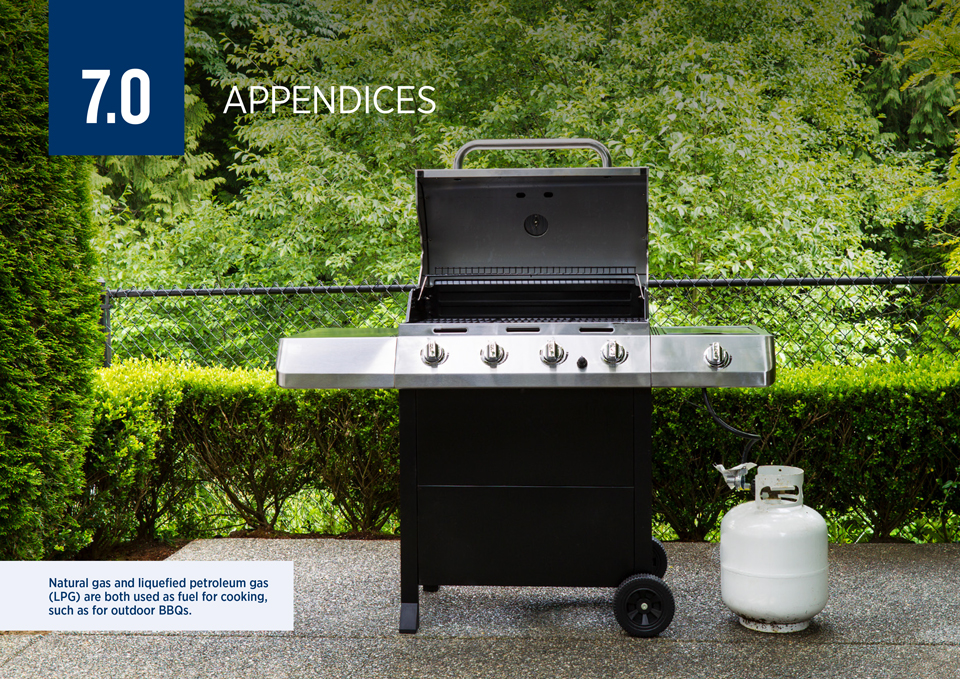 |
7.0附录天然气和lique?液化石油气(LPG)都被用作烹饪的燃料,例如户外烧烤。
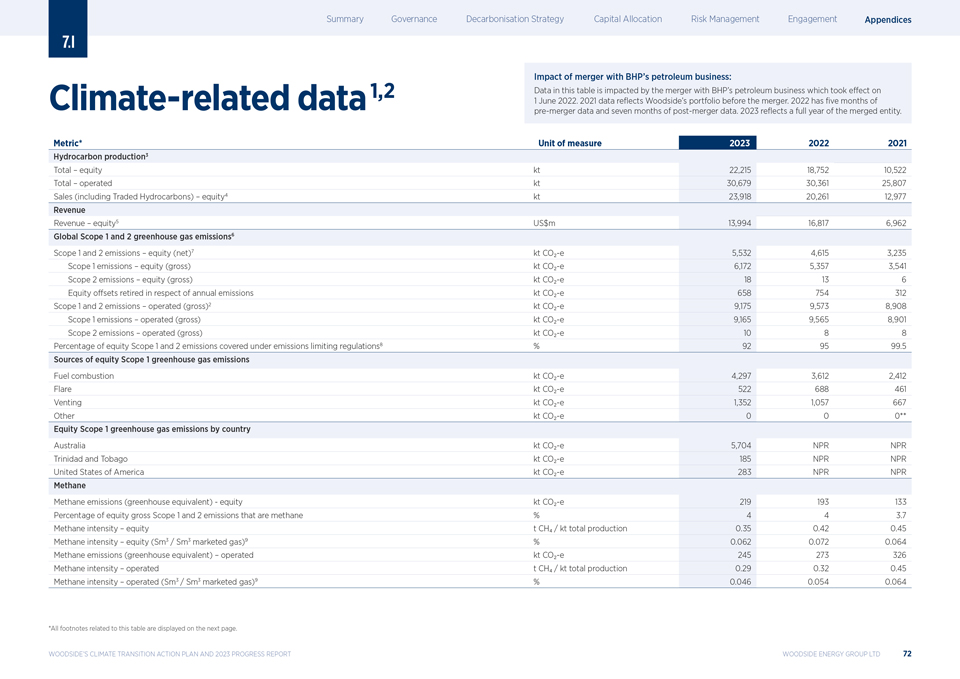 |
7.1气候相关数据1,2与 必和必拓合并的影响?石油业务:本表中的数据受到与必和必拓合并的影响?于二零二二年六月一日生效。2021年的数据反映了伍德赛德?合并前的投资组合。2022年有5个月的合并前数据和7个 个月的合并后数据。2023 re?合并后的实体全年。度量 * 计量单位2023 2022 2021碳氢化合物产量3合计?股本kt 22,215 18,752 10,522合计?经营kt 30,679 30,361 25,807销售(包括贸易 碳氢化合物)?股票4 kt 23,918 20,261 12,977收入?全球范围1和2温室气体排放6范围1和2排放?股本(净额)7kt CO?—e 5,532 4,615 3,235范围1排放量?股本(毛额) kt CO?—e 6,172 5,357 3,541范围2排放量?股本(毛额)kt CO?—e 18 13 6关于年度排放量kt CO?e 658 754 312范围1和2排放?操作(总)2kt CO?—e 9,175 9,573 8,908范围1排放量? 操作(总)kt CO?—e 9,165 9,565 8,901范围2排放量?操作(总)kt CO?—e 10 8 8权益百分比排放限制法规涵盖的范围1和2排放量8% 92 95 99.5权益来源范围1温室气体 排放燃料燃烧kt CO?—e 4,297 3,612 2,412 Flare kt CO?—e 522 688 461排气口CO?—e 1,352 1,057 667其他kt CO?—e 0 0 0 **按国家分列的权益范围1温室气体排放澳大利亚kt CO?NPR NPR特立尼达和多巴哥kt CO?—e 185 NPR NPR美利坚合众国kt CO?—e 283 NPR NPR甲烷甲烷排放量(温室当量)—e 219 193 133范围1和范围2中甲烷排放量的百分比% 4 4 3. 7甲烷密度?股权t CH?/kt总产量0.35 0.42 0.45甲烷浓度?公平值(Sm3/Sm3销售天然气)9% 0.062 0.072 0.064甲烷排放量(温室当量)?经营kt CO?—245 273 326甲烷强度?做了T CH?/kt总产量0.29 0.32 0.45甲烷浓度?操作(Sm3/Sm3市售气体)9% 0.046 0.054 0.064 * 与此表相关的所有脚注见下一页。伍德赛德?2023年全球气候变迁行动计划与进展报告Woodside Energy Group Ltd 72
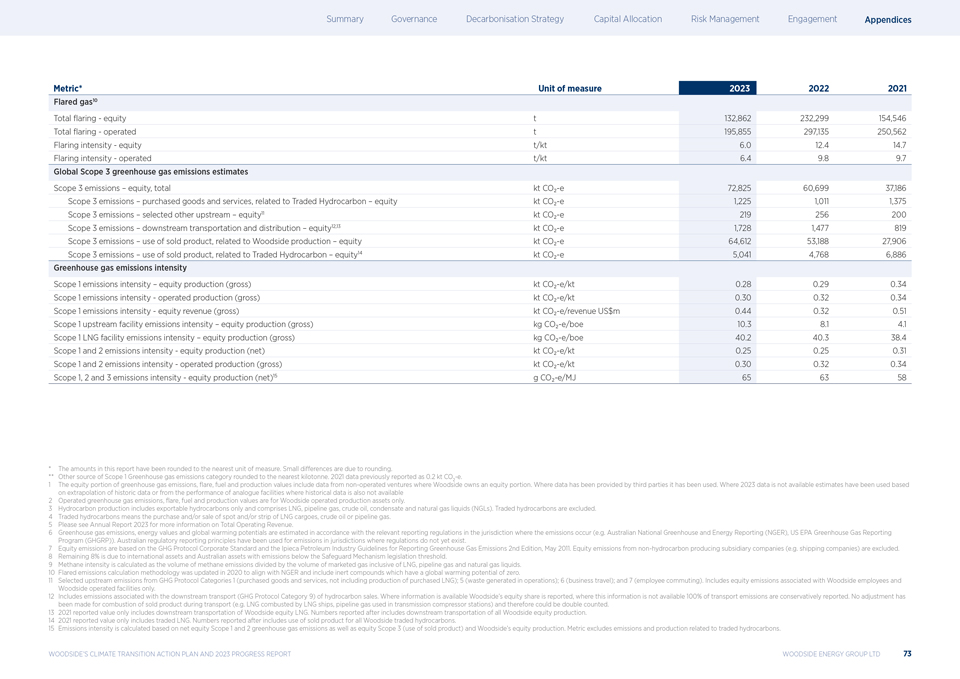 |
公制*计量单位2023 2022 2021燃料气10总量?燃料量t 132,862 232,299 154,546总量?燃料量t 195,855 297 135 250,562燃料量t权益t/kt 6.0 12.4 14.7燃料量t/kt 6.4 9.8 9.7全球范围3温室气体排放量 估计范围3排放量?公平,总kt CO?-e 72,825 60,699 37,186范围3排放?购买了与碳氢化合物交易有关的商品和服务?股权kt CO?-e 1,225 1,011 1,375范围3排放?选择了其他上游的?等值11 kt CO?-e 219 256 200范围3排放?下游运输和配送?当量12,13 kt CO?-e 1,728 1,477 819范围3排放?销售产品的使用情况,与伍德赛德的生产有关?股权kt CO?-e 64,612 53,188 27,906范围3排放 ?销售产品的使用,与交易的碳氢化合物有关?等值14 kt CO?-e 5,041 4,768 6,886温室气体排放强度范围1排放强度?权益生产(总量)kt CO?-e/kt 0.28 0.29 0.34范围1排放 强度调整运营产量(总量)kt CO?-e/kt 0.30 0.32 0.34范围1排放强度权益收入(总量)kt CO?-e/收入美元$m 0.44 0.32 0.51范围1上游设施排放强度?权益产量(毛重)千克CO?-e/boe 10.3 8.1 4.1范围1液化天然气设施排放强度?权益生产量(总量)千克CO?-e/boe 40.2 40.3 38.4范围1和2排放强度(净额)kt CO?-e/kt 0.25 0.25 0.31范围1和2排放强度运行 生产量(总量)kt CO?-e/kt 0.30 0.32 0.34范围1、2和3排放强度(净额)15克CO?-e/kt 65 63 58*本报告中的数额已四舍五入为最接近的计量单位。微小差异是由于 舍入造成的。**范围1温室气体排放的其他来源类别四舍五入为最接近的千吨。2021年的数据之前报告为0.2kt CO-e。2 1温室气体排放量、燃料和产值的权益部分包括来自伍德赛德拥有权益部分的非经营企业的数据。在第三方提供数据的情况下,该数据已被使用。在没有2023年数据的情况下,根据历史数据的外推或根据历史数据也没有历史数据的模拟设施的性能使用估计2运行的温室气体排放,燃料和生产值仅针对伍德赛德运行的生产资产。3碳氢化合物生产仅包括可出口的碳氢化合物,包括液化天然气、管道天然气、原油、凝析油和天然气液体(NGL)。交易的碳氢化合物不包括在内。4.交易碳氢化合物是指购买和/或出售液化天然气货物、原油或管道天然气的现货和/或带状货物。5有关总营业收入的更多信息,请参阅2023年年度报告。6温室气体排放量、能源值和全球变暖潜力是根据排放发生的司法管辖区的相关报告规定(例如,澳大利亚国家温室气体报告和能源报告(NGER)、美国环保局温室气体报告计划(GHGRP))估计的。澳大利亚监管报告原则已被用于尚不存在监管规定的司法管辖区的排放。7股权排放基于《温室气体议定书》企业标准和IPIECA石油行业报告温室气体排放指南,2011年5月第二版。不包括生产非碳氢化合物的子公司(如航运公司)的权益排放量。8剩余8%是由于国际资产和澳大利亚资产的排放量低于保障机制立法门槛。9甲烷强度的计算方法是将甲烷排放量除以市场上销售的天然气体积,包括液化天然气、管道气体和天然气液体。10.2020年更新了10个火炬排放计算方法,以与nger保持一致,并将全球变暖潜力为零的惰性化合物包括在内。11.《温室气体议定书》第1类(购买的商品和服务,不包括购买的液化天然气的生产)、5类(运营中产生的废物)、6类(商务旅行)和7类(员工通勤)中选定的上游排放。仅包括与伍德赛德员工和伍德赛德运营设施相关的权益排放。12包括与碳氢化合物销售的下游运输(温室气体议定书第9类)有关的排放量。林德赛德从哪里获得信息?S股权份额报告,没有此信息的地方100%保守报告交通排放。销售产品在运输过程中的燃烧没有进行调整(例如,LNG船舶燃烧的LNG,传输压缩机站使用的管道天然气),因此可以重复计算。132021年报告的价值仅包括伍德赛德股权液化天然气的下游运输。之后报告的数字包括所有伍德赛德股权生产的下游运输。142021年报告的价值仅包括交易的液化天然气。之后报告的数字包括所有伍德赛德交易的碳氢化合物的销售产品的使用。15排放强度是根据净权益范围1和2温室气体排放量以及权益范围3(销售产品的使用)和伍德赛德?S权益产量计算的。指标不包括与交易碳氢化合物相关的排放量和产量。伍德赛德?S气候转型行动计划和2023年进展报告 伍德赛德能源集团有限公司73
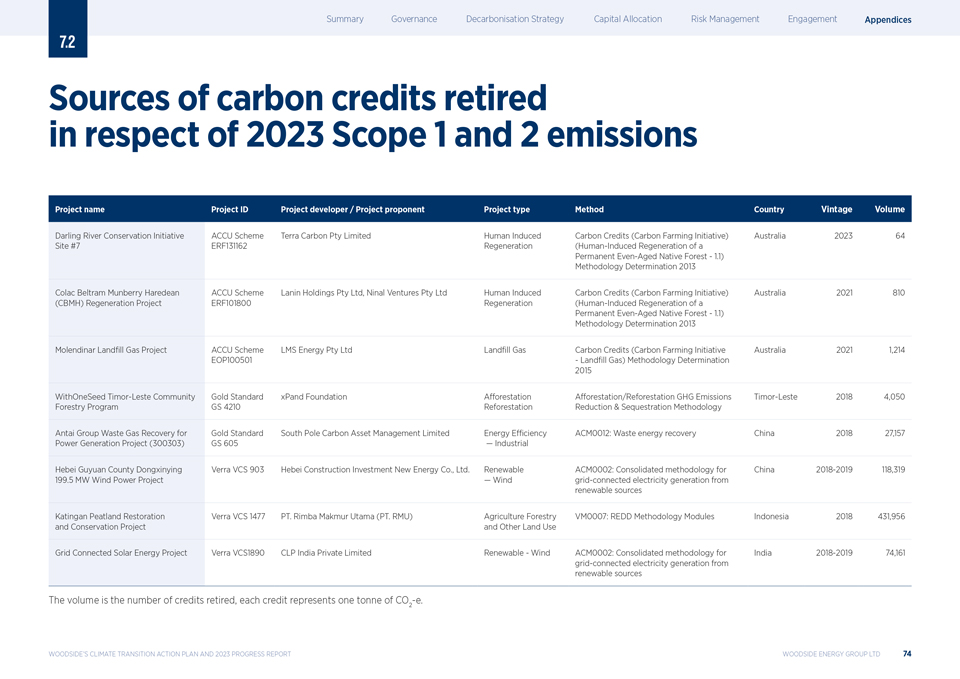 |
7.2关于碳2023信用额度的来源 范围1退役和2排放项目名称项目ID项目开发商/项目倡导者项目类型方法国家古董量达令河保护倡议ACCU计划Terra Carbon Pty Limited人工诱导碳信用额度(Carbon 农业倡议)澳大利亚2023 64站点#7 ERF131162再生(永久偶数原生林的人为再生:1.1)方法确定2013 Colac Beltram Munberry Haredian ACCU计划Lanin Holdings Pty Ltd,[br}Ninal Ventures Pty Ltd人工诱导碳信用(碳农业倡议)澳大利亚2021 810(CBMH)再生项目ERF101800再生(永久偶年龄段原生森林的人工再生)方法论 确定2013 Molendina土地?LL天然气项目ACCU计划LMS Energy Pty Ltd土地?LL气体碳信用(碳农业倡议澳大利亚2021,214 EOP100501/陆地?LL天然气)方法确定2015年一个东帝汶社区 金牌标准XPand基金会植树造林/重新造林温室气体排放-东帝汶4,050林业项目GS 4210重新造林与封存方法学安泰集团废气回收金标南方 极碳资产管理有限公司能效ACM0012:废能回收中国2018年27,157发电项目(300303)GS 605?河北固原县东新营实业VCS903河北建投新能源有限公司可再生能源ACM0002:中国2018年-2019年118,319 199.5兆瓦风电项目综合方法论?风电并网发电,可再生能源,卡丁根泥炭地恢复,VCS 1477 PT。Rimba Makmur Utama(PT. RMU)农林VM0007:RED方法模块印度尼西亚2018年431,956和保护项目和其他土地使用并网太阳能项目Verra VCS1890中电印度私人有限公司可再生风能ACM0002:印度2018-2019年74,161可再生能源并网发电的综合方法体积是报废的信用额度,每个信用额度代表一吨CO-e。2伍德赛德?S气候过渡行动计划和2023年进展 报告伍德赛德能源集团有限公司74
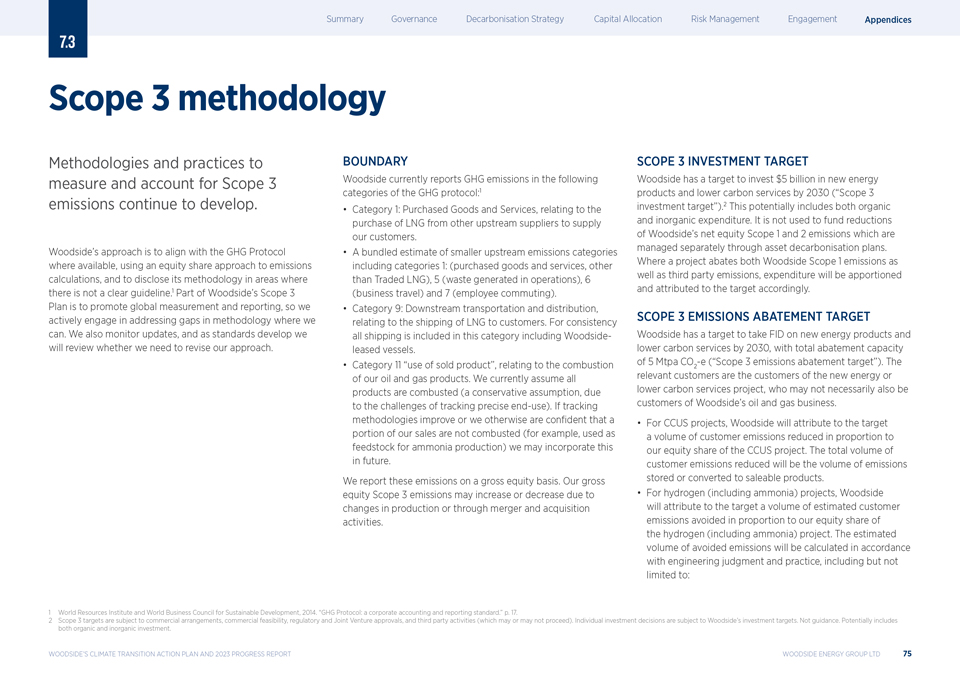 |
7.3范围3的方法、方法和做法 继续发展,以衡量和核算范围3的排放。伍德赛德?S的方法是在可用情况下与《温室气体议定书》保持一致,使用股权份额方法计算排放量,并在没有明确指导方针的领域披露其方法。1伍德赛德?S范围3计划的一部分是促进全球测量和报告,因此我们在力所能及的地方积极参与解决方法空白的问题。我们还监控更新,随着标准的制定,我们将审查是否需要修改我们的方法。边界伍德赛德目前报告了以下温室气体协议类别的温室气体排放量:1类别1:采购的商品和服务,与从其他上游供应商购买液化天然气以供应我们的客户有关。对上游较小排放类别的捆绑估计,包括第1类(购买的商品和服务,交易液化天然气除外)、第5类(运营中产生的废物)、第6类(商务旅行)和第7类(员工通勤)。第9类: 下游运输和分配,与向客户运输液化天然气有关。第11类?销售产品的使用?与我们的石油和天然气产品的燃烧有关。我们目前假设所有产品都被烧毁了(这是一个保守的假设,因为跟踪准确的最终用途存在挑战)。如果跟踪方法有所改进,或者我们确信我们的销售中有一部分没有燃烧(例如,用作合成氨生产的原料),我们可能会在未来将其纳入其中。我们的总权益范围3排放量可能会因产量变化或通过合并和收购活动而增加或减少。范围3投资目标伍德赛德的目标是到2030年在新能源产品和低碳服务上投资50亿美元(范围3投资目标?)2这可能包括有机和无机支出。这笔资金不用于为减少伍德赛德?S净股本范围1和2的排放提供资金,这两个范围通过资产脱碳计划单独管理。如果一个项目既减少了伍德赛德范围1的排放,也减少了第三方的排放,支出将相应地分摊并归入目标。范围3减排目标伍德赛德的目标是到2030年在新能源产品和低碳服务上采用FID,总减排能力为5 Mtpa CO-e(范围3排放削减目标?)。相关客户2为新能源或低碳服务项目的客户,不一定也是伍德赛德?S油气业务的客户。对于CCUS项目,伍德赛德将根据我们在CCUS项目中的股权份额将客户排放量按比例减少到目标。客户减少的排放总量将是存储或转换为可销售产品的排放量。对于氢气(包括氨气)项目,伍德赛德将根据我们在氢气(包括氨气)项目中的股权份额,将避免的估计客户排放量归因于目标。避免排放量的估计量将根据工程判断和实践进行计算,包括但不限于:1世界资源研究所和世界可持续发展商业理事会,2014年。17.2范围3的目标取决于商业安排、商业可行性、监管和合资企业的批准,以及第三方活动(可能进行也可能不进行)。而不是指导。可能既包括有机投资,也包括无机投资。
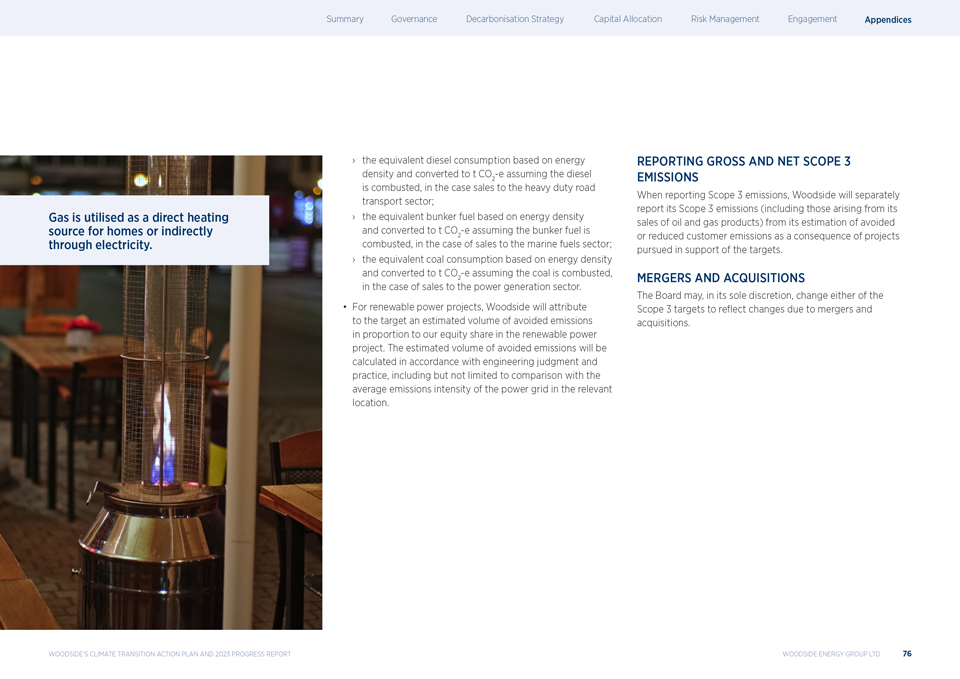 |
天然气被用作家庭的直接供暖来源,或通过电力间接使用。基于能源密度的当量柴油消耗量,在假设柴油燃烧的情况下,转换为t CO-e,在销售给重型公路运输部门的情况下;基于能量密度的当量船用燃料消耗量,在假设船用燃料燃烧的情况下,转换为t CO-e;在销售给2发电部门的情况下,根据能源密度计算的当量煤炭消耗量,并转换为假设煤炭燃烧的当量煤炭消耗量。对于可再生能源项目,伍德赛德将根据我们在可再生能源项目中的股权份额,将避免排放量的估计数量归因于目标。预计的避免排放量将根据工程判断和实践进行计算,包括但不限于与相关地点电网的平均排放强度进行比较。报告范围3排放总量和净排放量在报告范围3排放时,Woodside将单独报告其范围3排放(包括因石油和天然气产品销售而产生的排放量),这是由于实施支持目标的项目而避免或减少了客户排放。合并和收购董事会可自行决定更改范围3的任一目标,以应对因合并和收购而发生的变化。伍德赛德?S气候转型行动计划和2023年进展报告伍德赛德能源集团有限公司76
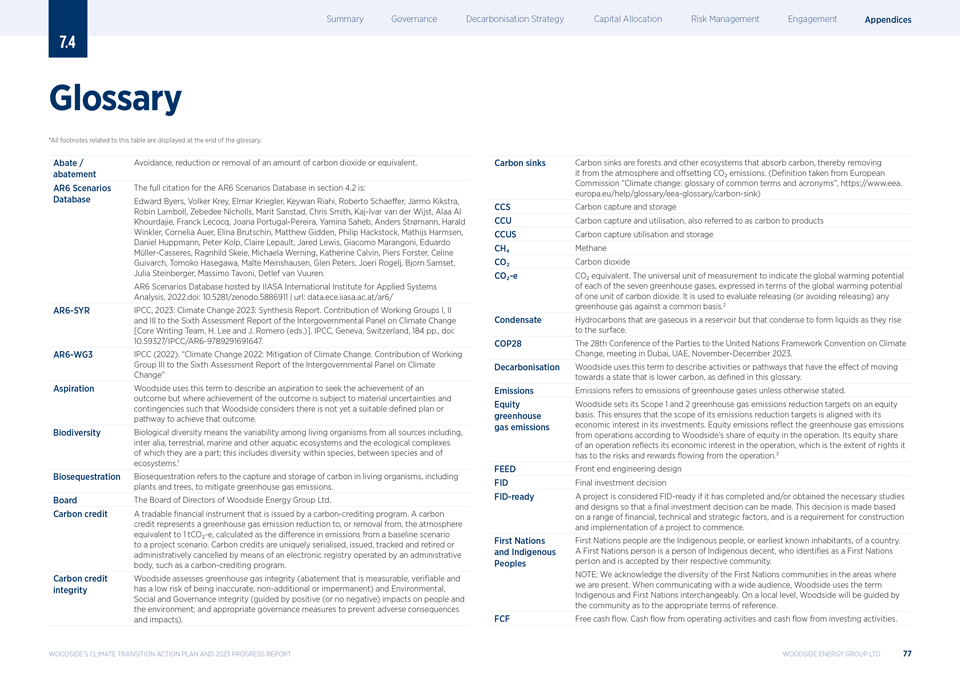 |
7.4术语表 * 与此表相关的所有脚注 都显示在术语表的末尾。减少/避免、减少或去除一定量的二氧化碳或等同物。第4.2节中AR6场景数据库的完整引用是:数据库Edward Byers,Volker Krey,Elmar Kriegler,Keywan Riahi,Roberto Schaeffer,Jarmo Kikstra,Robin Lamboll,Zebedee Nicholls,Marit Sanstad,Chris Smith,Kaj—Ivar van der Wijst,Alaa Al Khourdajie,Franck Lecocq,Joana Portugal—Pereira,Yamina Saheb,Anders Str?曼,哈拉尔·温克勒,科妮莉亚·奥尔,埃琳娜·布鲁津,马修·吉登,菲利普·哈克斯托克,马蒂吉斯·哈姆森,丹尼尔·胡普曼,彼得·科尔普,克莱尔·勒波特,贾里德·刘易斯,贾科莫·马朗戈尼,爱德华多·M?ller—Casseres,Ragnhild Skeie,Michaela Werning,Katherine Calvin,Piers Forster,Celine Guivarch,Tomoko Hasegawa,Malte Meinshausen,Glen Peters,Joeri Rogelj,Bjorn Samset,Julia Steinberger,Massimo Tavoni,Detlef van Vuuren. AR6场景数据库由IIASA国际应用系统分析研究所托管 ,2022.doi:10.5281/zenodo.5886911| AR6—SYR IPCC,2023:气候变化2023:综合报告。第一、二和三工作组对政府间气候变化专门委员会第六次评估报告的贡献 [核心写作团队,H。Lee and J. Romero(eds.)]。气专委,瑞士日内瓦,第184页,DOI:10.59327/IPCC/AR6-9789291691647。Ar6-wg3政府间气候变化专门委员会(2022年)。《2022年气候变化:减缓气候变化》。第三工作组对政府间气候变化专门委员会第六次评估报告的贡献?抱负伍德赛德使用这一术语来描述寻求实现结果的抱负,但实现结果受到重大不确定性和意外情况的影响,因此伍德赛德认为目前还没有实现该结果的适当计划或途径。生物多样性是指所有来源的生物体之间的变异性,除其他外,包括陆地、海洋和其他水生生态系统及其所属的生态复合体;这包括物种内、物种间和生态系统的多样性。1生物排序生物序列是指捕获和储存生物体内的碳,包括植物和树木,以减少温室气体排放。伍德赛德能源集团有限公司董事会碳信用由碳信用计划发行的可交易金融工具。碳信用是指温室气体减少到大气或从大气中清除的温室气体,相当于1 TCO?-e,计算方法是基线情景与项目情景的排放量之差。碳信用是通过行政机构运营的电子登记系统(如碳信用计划)以独特的方式进行序列化、发放、跟踪和报废或行政取消的。碳信用伍德赛德评估温室气体完整性(消除可测量、可核实且诚信不准确、非额外或非永久性的低风险)以及环境、社会和治理完整性(以对人和环境的积极(或无负面)影响为指导;以及适当的 治理措施,以防止不利后果和影响)。碳汇碳汇是森林和其他生态系统吸收碳,从而将其从大气中移除并抵消CO?排放。(定义取自欧洲 委员会?气候变化:常用术语和缩略语词汇表?,https://www.eea.Europa.eu/help/glossary/eea-glossary/carbon-sink)碳捕获和封存CCU碳捕获和利用,也称为碳到产品CCU 碳捕获和封存CH?甲烷一氧化碳?二氧化碳CO?-E CO?等价物。表示七种温室气体中每种气体的全球变暖潜势的通用单位,以一单位二氧化碳的全球变暖潜势表示。它被用来评估在共同的基础上释放(或避免释放)任何温室气体。2凝析碳氢化合物在储藏层中是气态的,但当它们上升到地表时会凝结成液体。COP28《联合国气候变化框架公约》第28次缔约方大会,2023年11月至12月在阿联酋迪拜举行。脱碳伍德赛德使用这个术语来描述具有向低碳状态转变的效果的活动或途径,如本词汇表中所述。排放是指温室气体的排放,除非另有说明。Equity Woodside在股权温室气体基础上设定了范围1和范围2温室气体减排目标 。这确保了其减排目标的范围与其投资中的气体排放经济利益保持一致。股权排放反映的是运营产生的温室气体排放。 根据伍德赛德?S在运营中的股权份额。它在运营中的股权份额反映了它在运营中的经济利益,这是它对运营中流动的风险和回报的权利的程度。3 Feed前端 工程设计FID最终投资决策如果项目已经完成和/或获得了必要的研究和设计,以便做出最终投资决策,则被视为FID准备就绪。这一决定是基于一系列财务、技术和战略因素作出的,是项目开始建设和实施的要求。原住民是一个国家的土著人民,或已知的最早的居民。原住民原住民是土著体面的人,被认为是原住民,并被他们各自的社区所接受。注:我们承认我们所在地区原住民社区的多样性。在与广泛的听众交流时,伍德赛德交替使用土著和第一民族这两个词。在地方层面上,伍德赛德将接受社区的指导,以确定适当的职权范围。Fcf自由现金?哦。来自经营活动的现金和来自投资活动的现金。伍德赛德?S气候转型行动计划和2023年进展报告伍德赛德能源集团有限公司77
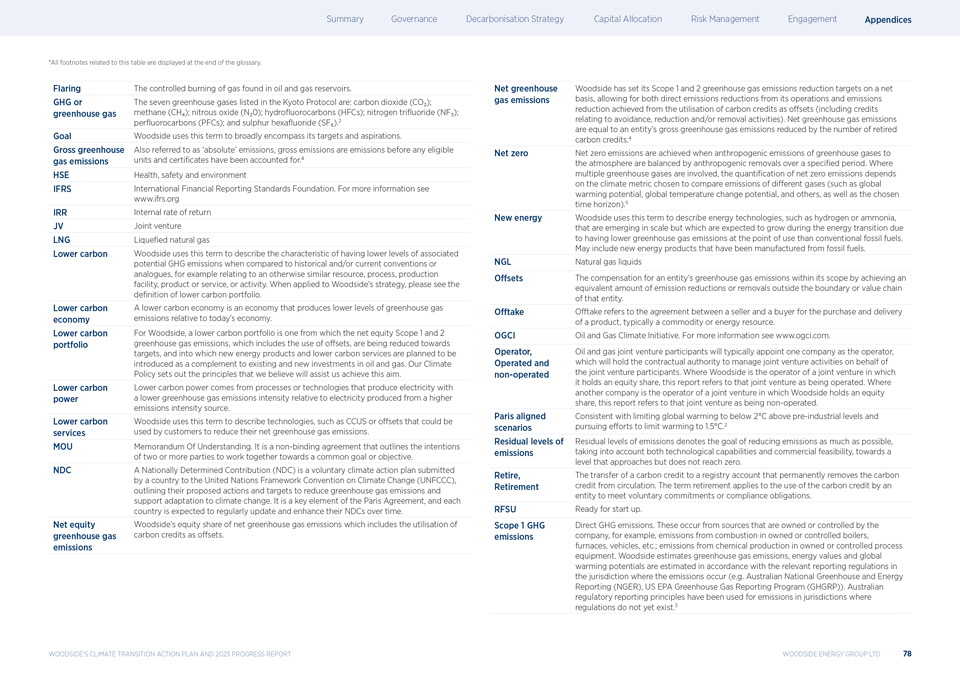 |
* 与此表相关的所有脚注都显示在词汇表的末尾 。燃烧在油气藏中发现的气体的控制燃烧。《京都议定书》所列的七种温室气体是:二氧化碳;温室气体甲烷(CH?);一氧化二氮(N?0); Hydro?氢氟碳化合物(HFCs);氮三?氟化物(NF?);per?氟化碳(PFCs);和硫六?氟化物(SF?)。2 Goal Woodside使用这个词广泛涵盖其目标和愿望。温室气体也被称为?绝对?排放量, 总排放量是在任何合格气体排放单位和证书之前的排放量?4 HSE健康、安全与环境IFRS国际财务报告准则基础。欲了解更多信息,请参见www.example.com IRR 内部回报率合资企业LNG液化天然气?伍德赛德使用该术语来描述与历史和/或当前公约 或类似物相比,相关潜在温室气体排放水平较低的特征,例如与其他类似的资源、工艺、生产设施、产品或服务或活动有关。当应用于Woodside?关于低碳投资组合的定义,请参见低碳投资组合的定义。低碳低碳 经济是指与今天相比,温室气体排放量更低的经济?的经济。低碳对于Woodside而言,低碳投资组合是指净权益范围1和2投资组合温室气体排放(包括使用抵消)正逐步减少至目标,并计划引入新能源产品和低碳服务,以补充现有和新的石油和天然气投资。我们的气候政策 制定了我们认为将有助于我们实现这一目标的原则。 低碳伍德赛德使用这个术语来描述技术,如CCUS或抵消,这些技术可能是客户用于减少其净温室气体排放的服务。谅解备忘录。 这是一项不具约束力的协议,概述了双方或多方为实现共同目标或目标而共同努力的意图。国家自主贡献(NDC)是一个国家向《联合国气候变化框架公约》(UNFCCC)提交的自愿气候行动计划,概述了他们为减少温室气体排放和支持适应气候变化而提出的行动和目标。这是《巴黎协定》的一个关键要素, 预计每个国家都将定期更新和加强其国家数据中心。 伍德赛德的净资产其在温室气体净排放中的权益份额,包括使用温室气体碳信用额作为抵销。净温室气体排放量Woodside已根据净气体排放量设定了 范围1和2温室气体减排目标,既考虑到其运营的直接减排量,也考虑到利用碳信用额作为抵消量实现的减排量 (包括与避免、减少和/或清除活动有关的信用额)。温室气体净排放量等于一个实体?s温室气体总排放量减去报废碳信用额的数量。4净零当向大气层的温室气体人为排放量与特定碳排放量之间的人为清除量相平衡时, 实现净零排放量。ed时期。在涉及多种温室气体的情况下,量化?净零排放量的阳离子取决于选择比较不同气体排放量的气候指标 (如全球变暖潜势、全球温度变化潜势和其他,以及选定的时间范围)。5新能源伍德赛德使用这个术语来描述能源技术,如氢或氨,这些能源正在出现规模,但由于在使用点的温室气体排放量低于传统化石燃料,预计将在能源转型期间增长。可能包括 用化石燃料制造的新能源产品。NGL天然气液体补偿实体的赔偿?通过在该实体的边界或价值链之外实现等量的减排量或清除量,从而减少其范围内的温室气体排放量 。承购承购是指买卖双方就购买和交付产品(通常是商品或能源)达成的协议。OGCI油气气候倡议。ogci.com. 运营商,油气合资企业参与者通常会指定一家公司作为运营商,运营商将拥有代表非运营合资企业参与者管理合资企业活动的合同权力。 如果Woodside是一家合资企业的经营者,且其持有股权,则本报告将该合资企业称为正在经营中。如果另一家公司是伍德赛德持有股权的合资企业的运营商,本 报告将该合资企业称为非运营。巴黎与将全球升温限制在工业化前水平以上2摄氏度以下以及努力将升温限制在1. 5摄氏度的设想相一致。2残留水平残留排放水平表示尽可能减少排放量的目标,排放量考虑到技术能力和商业可行性,使其达到接近但不达到零的水平。报废,将碳信用转账至登记账户,永久将碳报废信用从流通中移除。退役一词适用于一个实体为履行自愿承诺或履约义务而使用碳信用额度。RFSU已准备好 启动。范围1温室气体直接温室气体排放。这些排放来自排放公司拥有或控制的来源,例如,在拥有或控制的锅炉、熔炉、车辆等中燃烧产生的排放;在拥有或控制的工艺设备中进行化学生产所产生的排放。伍德赛德估计温室气体排放量、能值和全球变暖潜力是根据发生排放的司法管辖区的相关报告法规进行估计的(例如,澳大利亚国家温室气体报告和能源报告(NGER)、美国环保局温室气体报告计划(GHGRP))。澳大利亚监管报告原则已被用于尚不存在法规的司法管辖区的排放。3伍德赛德?S气候过渡行动计划和2023年进展报告伍德赛德能源集团有限公司78
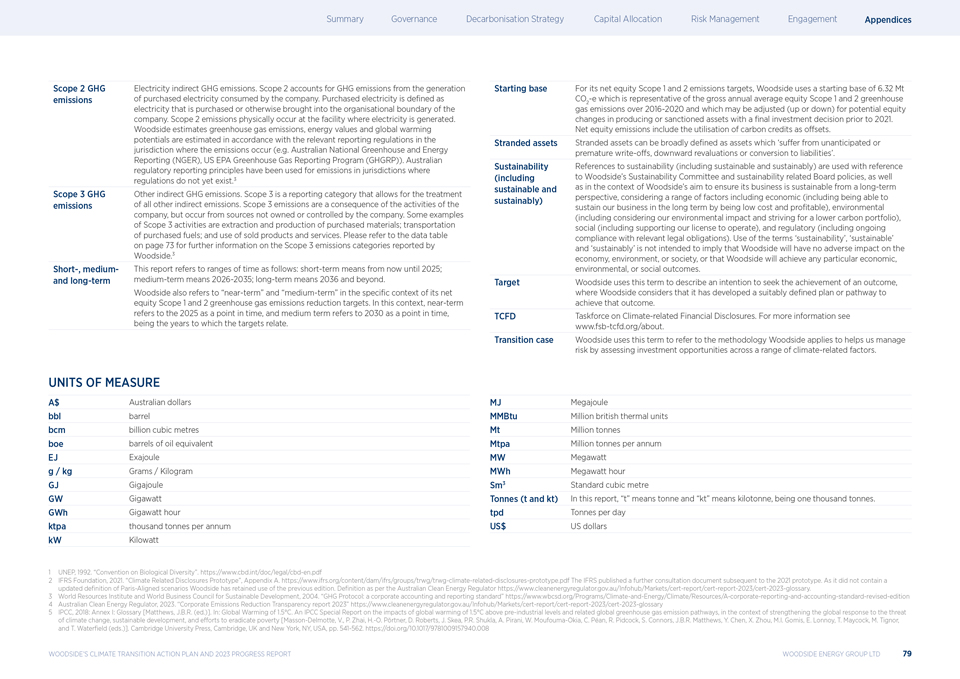 |
Scope 2 GHG Electricity indirect GHG emissions. Scope 2 accounts for GHG emissions from the generation emissions of purchased electricity consumed by the company. Purchased electricity is de?ned as electricity that is purchased or otherwise brought into the organisational boundary of the company. Scope 2 emissions physically occur at the facility where electricity is generated. Woodside estimates greenhouse gas emissions, energy values and global warming potentials are estimated in accordance with the relevant reporting regulations in the jurisdiction where the emissions occur (e.g. Australian National Greenhouse and Energy Reporting (NGER), US EPA Greenhouse Gas Reporting Program (GHGRP)). Australian regulatory reporting principles have been used for emissions in jurisdictions where regulations do not yet exist.3 Scope 3 GHG Other indirect GHG emissions. Scope 3 is a reporting category that allows for the treatment emissions of all other indirect emissions. Scope 3 emissions are a consequence of the activities of the company, but occur from sources not owned or controlled by the company. Some examples of Scope 3 activities are extraction and production of purchased materials; transportation of purchased fuels; and use of sold products and services. Please refer to the data table on page 73 for further information on the Scope 3 emissions categories reported by Woodside.3 Short-, medium- This report refers to ranges of time as follows: short-term means from now until 2025; and long-term medium-term means 2026-2035; long-term means 2036 and beyond. Woodside also refers to ?near-term? and ?medium-term? in the specific context of its net equity Scope 1 and 2 greenhouse gas emissions reduction targets. In this context, near-term refers to the 2025 as a point in time, and medium term refers to 2030 as a point in time, being the years to which the targets relate. Starting base For its net equity Scope 1 and 2 emissions targets, Woodside uses a starting base of 6.32 Mt CO -e which is representative of the gross annual average equity Scope 1 and 2 greenhouse 2 gas emissions over 2016-2020 and which may be adjusted (up or down) for potential equity changes in producing or sanctioned assets with a ?nal investment decision prior to 2021. Net equity emissions include the utilisation of carbon credits as offsets. Stranded assets Stranded assets can be broadly defined as assets which ?suffer from unanticipated or premature write-offs, downward revaluations or conversion to liabilities?. Sustainability References to sustainability (including sustainable and sustainably) are used with reference (including to Woodside?s Sustainability Committee and sustainability related Board policies, as well sustainable and as in the context of Woodside?s aim to ensure its business is sustainable from a long-term sustainably) perspective, considering a range of factors including economic (including being able to sustain our business in the long term by being low cost and profitable), environmental (including considering our environmental impact and striving for a lower carbon portfolio), social (including supporting our license to operate), and regulatory (including ongoing compliance with relevant legal obligations). Use of the terms ?sustainability?, ?sustainable? and ?sustainably? is not intended to imply that Woodside will have no adverse impact on the economy, environment, or society, or that Woodside will achieve any particular economic, environmental, or social outcomes. Target Woodside uses this term to describe an intention to seek the achievement of an outcome, where Woodside considers that it has developed a suitably de?ned plan or pathway to achieve that outcome. TCFD Taskforce on Climate-related Financial Disclosures. For more information see www.fsb-tcfd.org/about. Transition case Woodside uses this term to refer to the methodology Woodside applies to helps us manage risk by assessing investment opportunities across a range of climate-related factors. UNITS OF MEASURE A$ Australian dollars MJ Megajoule bbl barrel MMBtu Million british thermal units bcm billion cubic metres Mt Million tonnes boe barrels of oil equivalent Mtpa Million tonnes per annum EJ Exajoule MW Megawatt g / kg Grams / Kilogram MWh Megawatt hour GJ Gigajoule Sm3 Standard cubic metre GW Gigawatt Tonnes (t and kt) In this report, ?t? means tonne and ?kt? means kilotonne, being one thousand tonnes. GWh Gigawatt hour tpd Tonnes per day ktpa thousand tonnes per annum US$ US dollars kW Kilowatt 1 UNEP, 1992. ?Convention on Biological Diversity?. https://www.cbd.int/doc/legal/cbd-en.pdf 2 IFRS Foundation, 2021. ?Climate Related Disclosures Prototype?, Appendix A. https://www.ifrs.org/content/dam/ifrs/groups/trwg/trwg-climate-related-disclosures-prototype.pdf The IFRS published a further consultation document subsequent to the 2021 prototype. As it did not contain a updated definition of Paris-Aligned scenarios Woodside has retained use of the previous edition. Definition as per the Australian Clean Energy Regulator https://www.cleanenergyregulator.gov.au/Infohub/Markets/cert-report/cert-report-2023/cert-2023-glossary. 3 World Resources Institute and World Business Council for Sustainable Development, 2004. ?GHG Protocol: a corporate accounting and reporting standard? https://www.wbcsd.org/Programs/Climate-and-Energy/Climate/Resources/A-corporate-reporting-and-accounting-standard-revised-edition 4 Australian Clean Energy Regulator, 2023. ?Corporate Emissions Reduction Transparency report 2023? https://www.cleanenergyregulator.gov.au/Infohub/Markets/cert-report/cert-report-2023/cert-2023-glossary 5 IPCC, 2018: Annex I: Glossary [马修斯,J.B.R.(编辑)].全球变暖1.5C。IPCC关于全球变暖 高于工业化前水平 1.5C的影响和相关全球温室气体排放路径的特别报告,在加强全球应对气候变化威胁、可持续发展和努力消除贫困的背景下 [梅森—德莫特, V.,翟平,H.—O. P?rtner,D. Roberts,J. Skea,P.R. Shukla,A. Pirani,W. Moufouma—Okia角P?an,R. Pidcock,S.康纳斯,J.B.R. Matthews,Y. Chen,X.周先生,M.I. Gomis,E. Lonnoy,T.梅考克M. Tigor和T.水?Ed(eds.)].剑桥 大学出版社,英国剑桥和纽约,美国纽约,pp. 541-562. https://doi.org/10.1017/9781009157940.008 2023年全球气候变迁行动计划与进展报告Woodside Energy Group Ltd 79
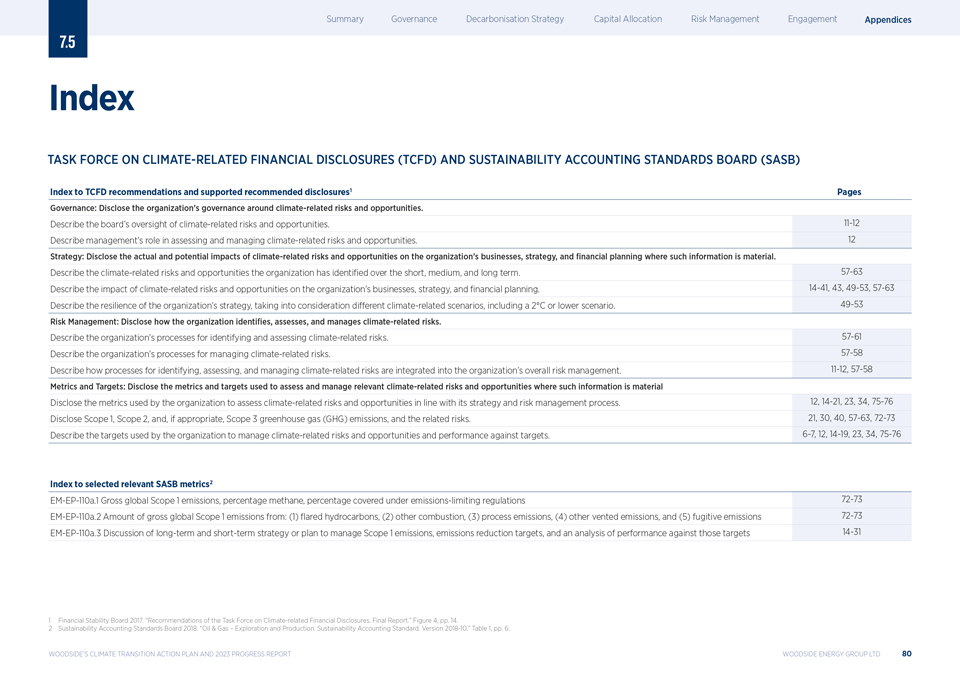 |
7.5 Index TASK FORCE ON CLIMATE-RELATED FINANCIAL DISCLOSURES (TCFD) AND SUSTAINABILITY ACCOUNTING STANDARDS BOARD (SASB) Index to TCFD recommendations and supported recommended disclosures1 Pages Governance: Disclose the organization?s governance around climate-related risks and opportunities. Describe the board?s oversight of climate-related risks and opportunities. 11-12 Describe management?s role in assessing and managing climate-related risks and opportunities. 12 Strategy: Disclose the actual and potential impacts of climate-related risks and opportunities on the organization?s businesses, strategy, and financial planning where such information is material. Describe the climate-related risks and opportunities the organization has identified over the short, medium, and long term. 57-63 Describe the impact of climate-related risks and opportunities on the organization?s businesses, strategy, and financial planning. 14-41, 43, 49-53, 57-63 Describe the resilience of the organization?s strategy, taking into consideration different climate-related scenarios, including a 2C or lower scenario. 49-53 Risk Management: Disclose how the organization identi?es, assesses, and manages climate-related risks. Describe the organization?s processes for identifying and assessing climate-related risks. 57-61 Describe the organization?s processes for managing climate-related risks. 57-58 Describe how processes for identifying, assessing, and managing climate-related risks are integrated into the organization?s overall risk management. 11-12, 57-58 Metrics and Targets: Disclose the metrics and targets used to assess and manage relevant climate-related risks and opportunities where such information is material Disclose the metrics used by the organization to assess climate-related risks and opportunities in line with its strategy and risk management process. 12, 14-21, 23, 34, 75-76 Disclose Scope 1, Scope 2, and, if appropriate, Scope 3 greenhouse gas (GHG) emissions, and the related risks. 21, 30, 40, 57-63, 72-73 Describe the targets used by the organization to manage climate-related risks and opportunities and performance against targets. 6-7, 12, 14-19, 23, 34, 75-76 Index to selected relevant SASB metrics2 EM-EP-110a.1 Gross global Scope 1 emissions, percentage methane, percentage covered under emissions-limiting regulations 72-73 EM-EP-110a.2 Amount of gross global Scope 1 emissions from: (1) ?ared hydrocarbons, (2) other combustion, (3) process emissions, (4) other vented emissions, and (5) fugitive emissions 72-73 EM-EP-110a.3 Discussion of long-term and short-term strategy or plan to manage Scope 1 emissions, emissions reduction targets, and an analysis of performance against those targets 14-31 1 Financial Stability Board 2017. ?Recommendations of the Task Force on Climate-related Financial Disclosures. Final Report.? Figure 4, pp. 14. 2 Sustainability Accounting Standards Board 2018. ?Oil & Gas ? Exploration and Production. Sustainability Accounting Standard. Version 2018-10.? Table 1, pp. 6. WOODSIDE?S CLIMATE TRANSITION ACTION PLAN AND 2023 PROGRESS REPORT WOODSIDE ENERGY GROUP LTD 80
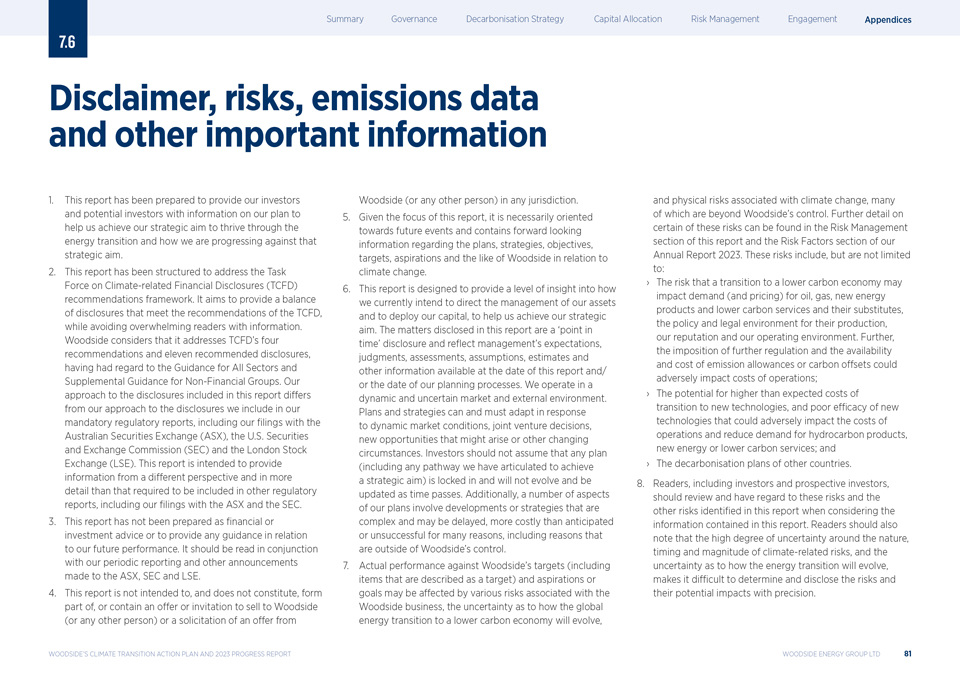 |
7.6 Disclaimer, and other important risks, emissions information data 1. This report has been prepared to provide our investors and potential investors with information on our plan to help us achieve our strategic aim to thrive through the energy transition and how we are progressing against that strategic aim. 2. This report has been structured to address the Task Force on Climate-related Financial Disclosures (TCFD) recommendations framework. It aims to provide a balance of disclosures that meet the recommendations of the TCFD, while avoiding overwhelming readers with information. Woodside considers that it addresses TCFD?s four recommendations and eleven recommended disclosures, having had regard to the Guidance for All Sectors and Supplemental Guidance for Non-Financial Groups. Our approach to the disclosures included in this report differs from our approach to the disclosures we include in our mandatory regulatory reports, including our filings with the Australian Securities Exchange (ASX), the U.S. Securities and Exchange Commission (SEC) and the London Stock Exchange (LSE). This report is intended to provide information from a different perspective and in more detail than that required to be included in other regulatory reports, including our filings with the ASX and the SEC. 3. This report has not been prepared as ?nancial or investment advice or to provide any guidance in relation to our future performance. It should be read in conjunction with our periodic reporting and other announcements made to the ASX, SEC and LSE. 4. This report is not intended to, and does not constitute, form part of, or contain an offer or invitation to sell to Woodside (or any other person) or a solicitation of an offer from Woodside (or any other person) in any jurisdiction. 5. Given the focus of this report, it is necessarily oriented towards future events and contains forward looking information regarding the plans, strategies, objectives, targets, aspirations and the like of Woodside in relation to climate change. 6. This report is designed to provide a level of insight into how we currently intend to direct the management of our assets and to deploy our capital, to help us achieve our strategic aim. The matters disclosed in this report are a ?point in time? disclosure and reflect management?s expectations, judgments, assessments, assumptions, estimates and other information available at the date of this report and/ or the date of our planning processes. We operate in a dynamic and uncertain market and external environment. Plans and strategies can and must adapt in response to dynamic market conditions, joint venture decisions, new opportunities that might arise or other changing circumstances. Investors should not assume that any plan (including any pathway we have articulated to achieve a strategic aim) is locked in and will not evolve and be updated as time passes. Additionally, a number of aspects of our plans involve developments or strategies that are complex and may be delayed, more costly than anticipated or unsuccessful for many reasons, including reasons that are outside of Woodside?s control. 7. Actual performance against Woodside?s targets (including items that are described as a target) and aspirations or goals may be affected by various risks associated with the Woodside business, the uncertainty as to how the global energy transition to a lower carbon economy will evolve, 8. and physical risks associated with climate change, many of which are beyond Woodside?s control. Further detail on certain of these risks can be found in the Risk Management section of this report and the Risk Factors section of our Annual Report 2023. These risks include, but are not limited to: The risk that a transition to a lower carbon economy may impact demand (and pricing) for oil, gas, new energy products and lower carbon services and their substitutes, the policy and legal environment for their production, our reputation and our operating environment. Further, the imposition of further regulation and the availability and cost of emission allowances or carbon offsets could adversely impact costs of operations; The potential for higher than expected costs of transition to new technologies, and poor efficacy of new technologies that could adversely impact the costs of operations and reduce demand for hydrocarbon products, new energy or lower carbon services; and The decarbonisation plans of other countries. Readers, including investors and prospective investors, should review and have regard to these risks and the other risks identi?ed in this report when considering the information contained in this report. Readers should also note that the high degree of uncertainty around the nature, timing and magnitude of climate-related risks, and the uncertainty as to how the energy transition will evolve, makes it difficult to determine and disclose the risks and their potential impacts with precision. WOODSIDE?S CLIMATE TRANSITION ACTION PLAN AND 2023 PROGRESS REPORT WOODSIDE ENERGY GROUP LTD 81
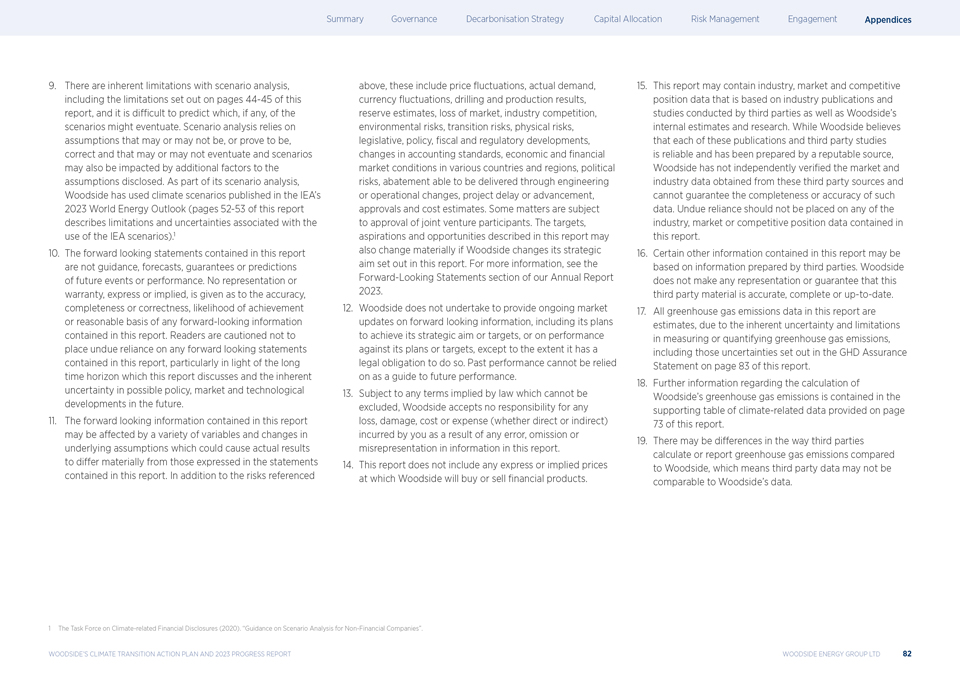 |
9.情景分析有其固有的局限性,包括本报告第44-45页所列的局限性,如果有的话,很难预测其中哪一种情景最终会出现。情景分析依赖于可能正确或可能不正确的假设,以及可能最终或可能不正确的假设,情景还可能受到所披露假设的其他因素的影响。作为情景分析的一部分,伍德赛德使用了国际能源署-S 2023年世界能源展望中发布的气候情景(本报告第52-53页描述了与使用国际能源署情景相关的限制和不确定性)。1 10.本报告中包含的前瞻性陈述不是对未来事件或业绩的指导、预测、保证或预测。对于本报告中包含的任何前瞻性信息的准确性、完整性或正确性、实现的可能性或合理基础,不作任何明示或暗示的陈述或保证。告诫读者不要过度依赖本报告中包含的任何前瞻性陈述,特别是考虑到本报告讨论的长期前景以及未来可能出现的政策、市场和技术发展的内在不确定性。11.本报告所载前瞻性信息可能会受到各种变量和基本假设变化的影响,这些变量和基本假设的变化可能导致实际结果与本报告所载陈述中所表达的结果大不相同。除上述风险外,这些风险还包括价格波动、实际需求、货币波动、钻井和生产结果、储量估计、市场损失、行业竞争、环境风险、过渡风险、实物风险、立法、政策、规模和监管发展、会计标准的变化、不同国家和地区的经济和金融市场状况、政治风险、可通过工程或运营变化实现的减排、项目延迟或推进、审批和成本估算。有些事项还需经合资企业参与方批准。如果伍德赛德改变其在本报告中提出的战略目标,本报告中描述的目标、抱负和机会也可能发生重大变化。有关更多信息,请参阅我们的2023年年度报告中的前瞻性陈述部分。12.伍德赛德不承诺持续向市场提供有关前瞻性信息的最新信息,包括其实现其战略目标或指标的计划,或关于其相对于其计划或指标的业绩的最新情况,除非它有法律义务这样做。不能将过去的业绩作为未来业绩的 指南。13.在法律规定的任何不能排除的条款的约束下,伍德赛德对您因本报告中信息的任何错误、遗漏或失实陈述而招致的任何损失、损害、成本或费用(无论是直接或间接的)不承担任何责任。14.本报告不包括伍德赛德购买或销售金融产品的任何明示或默示价格。15.本报告可能包含行业、市场和竞争地位数据, 基于行业出版物和第三方进行的研究,以及伍德赛德?S的内部估计和研究。虽然伍德赛德相信这些出版物和第三方研究都是可靠的,并且是由信誉良好的来源准备的,但伍德赛德没有独立核实从这些第三方来源获得的市场和行业数据,也不能保证这些数据的完整性或准确性。不应过度依赖本报告中包含的任何 行业、市场或竞争地位数据。16.本报告所载的某些其他信息可能以第三方编写的信息为基础。伍德赛德不做任何陈述,也不保证这些第三方材料准确、完整或最新。17.本报告中的所有温室气体排放数据均为估计数据,因为在测量或量化温室气体排放方面存在固有的不确定性和局限性,包括本报告第83页《全球温室气体排放保证声明》中所列的不确定性。18.关于伍德赛德?S温室气体排放量计算的进一步资料载于本报告第73页提供的与气候有关的数据支持表。19.与伍德赛德相比,第三方计算或报告温室气体排放的方式可能有所不同,这意味着第三方数据可能无法与伍德赛德?S的数据进行比较。1与气候有关的财务披露工作队(2020年)。?非金融公司情景分析指南?伍德赛德?S气候转型行动计划和2023年进展报告伍德赛德能源集团有限公司82
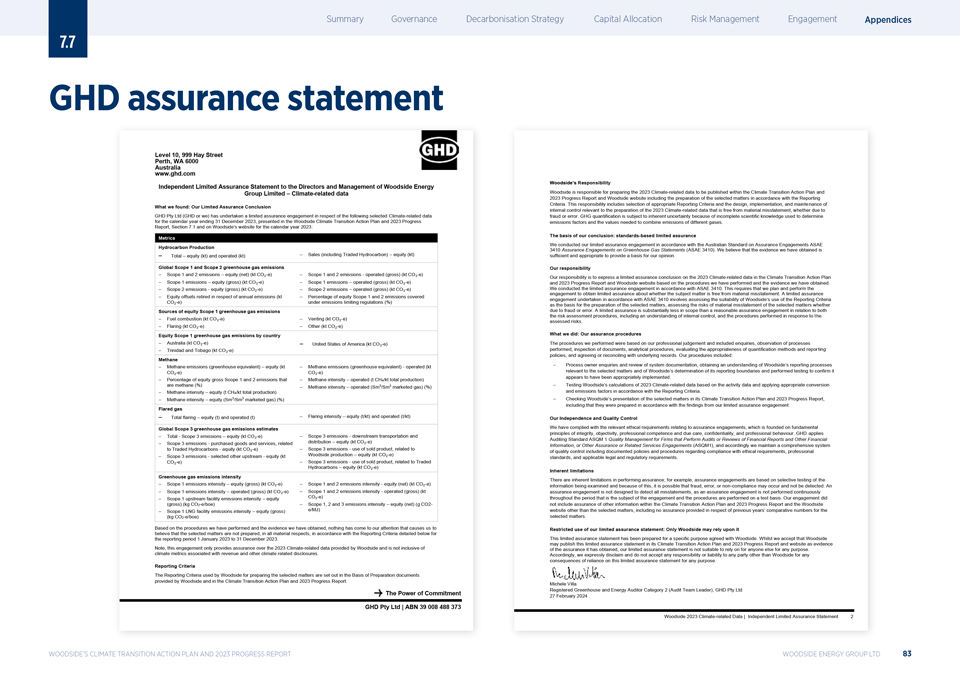 |
7.7 GHD assurance statement Level Perth, 10, WA 999 6000 Hay Street Australia www.ghd. com Independent Limited Assurance Statement to the Directors and Management of Woodside Energy Group Limited ? Climate-related data What we found: Our Limited Assurance Conclusion GHD Pty Ltd (GHD or we) has undertaken a limited assurance engagement in respect of the following selected Climate-related data for the calendar year ending 31 December 2023, presented in the Woodside Climate Transition Action Plan and 2023 Progress Report, Section 7.1 and on Woodside?s website for the calendar year 2023: Metrics Hydrocarbon Production ? Total ? equity (kt) and operated (kt) ? Sales (including Traded Hydrocarbon) ? equity (kt) Global Scope 1 and Scope 2 greenhouse gas emissions ? Scope 1 and 2 emissions ? equity (net) (kt CO?-e) ? Scope 1 and 2 emissions—operated (gross) (kt CO?-e) ? Scope 1 emissions ? equity (gross) (kt CO?-e) ? Scope 1 emissions ? operated (gross) (kt CO?-e) ? Scope 2 emissions—equity (gross) (kt CO?-e) ? Scope 2 emissions ? operated (gross) (kt CO?-e) ? Equity offsets retired in respect of annual emissions (kt ? Percentage of equity Scope 1 and 2 emissions covered CO?-e) under emissions limiting regulations (%) Sources of equity Scope 1 greenhouse gas emissions ? Fuel combustion (kt CO?-e) ? Venting (kt CO?-e) ? Flaring (kt CO?-e) ? Other (kt CO?-e) Equity Scope 1 greenhouse gas emissions by country ? Australia (kt CO?-e) ? United States of America (kt CO?-e) ? Trinidad and Tobago (kt CO?-e) Methane ? Methane emissions (greenhouse equivalent) ? equity (kt ? Methane emissions (greenhouse equivalent)—operated (kt CO?-e) CO?-e) ? Percentage of equity gross Scope 1 and 2 emissions that ? Methane intensity ? operated (t CH4/kt total production) are methane (%) ? Methane intensity ? operated (Sm3/Sm3 marketed gas) (%) ? Methane intensity ? equity (t CH4/kt total production) ? Methane intensity ? equity (Sm3/Sm3 marketed gas) (%) Flared gas ? Total flaring ? equity (t) and operated (t) ? Flaring intensity ? equity (t/kt) and operated (t/kt) Global Scope 3 greenhouse gas emissions estimates ? Total—Scope 3 emissions ? equity (kt CO?-e) ? Scope 3 emissions—downstream transportation and ? Scope 3 emissions—purchased goods and services, related distribution ? equity (kt CO?-e) to Traded Hydrocarbons—equity (kt CO?-e) ? Scope 3 emissions—use of sold product, related to ? Scope 3 emissions—selected other upstream—equity (kt Woodside production ? equity (kt CO?-e) CO?-e) ? Scope 3 emissions—use of sold product, related to Traded Hydrocarbons ? equity (kt CO?-e) Greenhouse gas emissions intensity ? Scope 1 emissions intensity ? equity (gross) (kt CO?-e) ? Scope 1 and 2 emissions intensity—equity (net) (kt CO?-e) ? Scope 1 emissions intensity ? operated (gross) (kt CO?-e) ? Scope 1 and 2 emissions intensity—operated (gross) (kt ? Scope 1 upstream facility emissions intensity ? equity CO?-e) (gross) (kg CO2-e/boe) ? Scope 1, 2 and 3 emissions intensity ? equity (net) (g CO2- ? Scope 1 LNG facility emissions intensity ? equity (gross) e/MJ) (kg CO2-e/boe) believe that the selected matters are not prepared, in all material respects, in accordance with the Reporting Criteria detailed below for the reporting period 1 January 2023 to 31 December 2023. Note, this engagement only provides assurance over the 2023 Climate-related data provided by Woodside and is not inclusive of climate metrics associated with revenue and other climate related disclosures. Reporting Criteria The Reporting Criteria used by Woodside for preparing the selected matters are set out in the Basis of Preparation documents provided by Woodside and in the Climate Transition Action Plan and 2023 Progress Report. The Power of Commitment GHD Pty Ltd | ABN 39 008 488 373 Woodside?s Responsibility Woodside is responsible for preparing the 2023 Climate-related data to be published within the Climate Transition Action Plan and 2023 Progress Report and Woodside website including the preparation of the selected matters in accordance with the Reporting Criteria. This responsibility includes selection of appropriate Reporting Criteria and the design, implementation, and maintenance of internal control relevant to the preparation of the 2023 Climate-related data that is free from material misstatement, whether due to fraud or error. GHG quantification is subject to inherent uncertainty because of incomplete scientific knowledge used to determine emissions factors and the values needed to combine emissions of different gases. The basis of our conclusion: standards-based limited assurance We conducted our limited assurance engagement in accordance with the Australian Standard on Assurance Engagements ASAE 3410 Assurance Engagements on Greenhouse Gas Statements (ASAE 3410). We believe that the evidence we have obtained is sufficient and appropriate to provide a basis for our opinion. Our responsibility Our responsibility is to express a limited assurance conclusion on the 2023 Climate-related data in the Climate Transition Action Plan and 2023 Progress Report and Woodside website based on the procedures we have performed and the evidence we have obtained. We conducted the limited assurance engagement in accordance with ASAE 3410. This requires that we plan and perform the engagement to obtain limited assurance about whether the subject matter is free from material misstatement. A limited assurance engagement undertaken in accordance with ASAE 3410 involves assessing the suitability of Woodside?s use of the Reporting Criteria as the basis for the preparation of the selected matters, assessing the risks of material misstatement of the selected matters whether due to fraud or error. A limited assurance is substantially less in scope than a reasonable assurance engagement in relation to both the risk assessment procedures, including an understanding of internal control, and the procedures performed in response to the assessed risks. What we did: Our assurance procedures The procedures we performed were based on our professional judgement and included enquiries, observation of processes performed, inspection of documents, analytical procedures, evaluating the appropriateness of quantification methods and reporting policies, and agreeing or reconciling with underlying records. Our procedures included: ? Process owner enquiries and review of system documentation, obtaining an understanding of Woodside?s reporting processes relevant to the selected matters and of Woodside?s determination of its reporting boundaries and performed testing to confirm appears to have been appropriately implemented. ? Testing Woodside?s calculations of 2023 Climate-related data based on the activity data and applying appropriate conversion and emissions factors in accordance with the Reporting Criteria. ? Checking Woodside?s presentation of the selected matters in its Climate Transition Action Plan and 2023 Progress Report, including that they were prepared in accordance with the findings from our limited assurance engagement. Our Independence and Quality Control We have complied with the relevant ethical requirements relating to assurance engagements, which is founded on fundamental principles of integrity, objectivity, professional competence and due care, confidentiality, and professional behaviour. GHD applies Auditing Standard ASQM 1 Quality Management for Firms that Perform Audits or Reviews of Financial Reports and Other Financial Information, or Other Assurance or Related Services Engagements (ASQM1), and accordingly we maintain a comprehensive system of quality control including documented policies and procedures regarding compliance with ethical requirements, professional standards, and applicable legal and regulatory requirements. Inherent limitations There are inherent limitations in performing assurance; for example, assurance engagements are based on selective testing of the information being examined and because of this, it is possible that fraud, error, or non-compliance may occur and not be detected. assurance engagement is not designed to detect all misstatements, as an assurance engagement is not performed continuously throughout the period that is the subject of the engagement and the procedures are performed on a test basis. Our engagement did not include assurance of other information within the Climate Transition Action Plan and 2023 Progress Report and the Woodside website other than the selected matters, including no assurance provided in respect of previous years? comparative numbers for the selected matters. Restricted use of our limited assurance statement: Only Woodside may rely upon it This limited assurance statement has been prepared for a specific purpose agreed with Woodside. Whilst we accept that Woodside may publish this limited assurance statement in its Climate Transition Action Plan and 2023 Progress Report and website as evidence of the assurance it has obtained, our limited assurance statement is not suitable to rely on for anyone else for any purpose. Accordingly, we expressly disclaim and do not accept any responsibility or liability to any party other than Woodside for any consequences of reliance on this limited assurance statement for any purpose. Michele Villa Registered Greenhouse and Energy Auditor Category 2 (Audit Team Leader), GHD Pty Ltd 27 February 2024 WOODSIDE?S CLIMATE TRANSITION ACTION PLAN AND 2023 PROGRESS REPORT WOODSIDE ENERGY GROUP LTD 83
 |
Head Office Woodside Energy Group Ltd Mia Yellagonga 11 Mount Street Perth WA 6000 Postal Address GPO Box D188 Perth WA 6840 Australia T +61 8 9348 4000 F +61 8 9214 2777 E companyinfo@woodside.com Woodside Energy Group Ltd ABN 55 004 898 962 woodside.com